Table of Contents¶
1 An example of a small Multi-Player simulation, with rhoRand and Selfish, for different algorithms
1.1 Creating the problem
1.1.1 Parameters for the simulation
1.1.2 Three MAB problems with Bernoulli arms
1.1.3 Some RL algorithms
1.2 Creating the EvaluatorMultiPlayers objects
1.3 Solving the problem
1.4 Plotting the results
1.4.1 First problem
1.4.2 Second problem
1.4.3 Third problem
1.4.4 Comparing their performances
An example of a small Multi-Player simulation, with rhoRand and Selfish, for different algorithms¶
First, be sure to be in the main folder, or to have SMPyBandits installed, and import EvaluatorMultiPlayers from Environment package:
[1]:
!pip install SMPyBandits watermark
%load_ext watermark
%watermark -v -m -p SMPyBandits -a "Lilian Besson"
Requirement already satisfied: SMPyBandits in ./venv3/lib/python3.6/site-packages (0.9.4)
Requirement already satisfied: watermark in ./venv3/lib/python3.6/site-packages (1.7.0)
Requirement already satisfied: joblib in ./venv3/lib/python3.6/site-packages (from SMPyBandits) (0.13.0)
Requirement already satisfied: scikit-optimize in ./venv3/lib/python3.6/site-packages (from SMPyBandits) (0.5.2)
Requirement already satisfied: seaborn in ./venv3/lib/python3.6/site-packages (from SMPyBandits) (0.9.0)
Requirement already satisfied: numpy in ./venv3/lib/python3.6/site-packages (from SMPyBandits) (1.15.4)
Requirement already satisfied: scikit-learn in ./venv3/lib/python3.6/site-packages (from SMPyBandits) (0.20.0)
Requirement already satisfied: matplotlib>=2 in ./venv3/lib/python3.6/site-packages (from SMPyBandits) (3.0.2)
Requirement already satisfied: scipy>0.9 in ./venv3/lib/python3.6/site-packages (from SMPyBandits) (1.1.0)
Requirement already satisfied: ipython in ./venv3/lib/python3.6/site-packages (from watermark) (7.1.1)
Requirement already satisfied: pandas>=0.15.2 in ./venv3/lib/python3.6/site-packages (from seaborn->SMPyBandits) (0.23.4)
Requirement already satisfied: kiwisolver>=1.0.1 in ./venv3/lib/python3.6/site-packages (from matplotlib>=2->SMPyBandits) (1.0.1)
Requirement already satisfied: python-dateutil>=2.1 in ./venv3/lib/python3.6/site-packages (from matplotlib>=2->SMPyBandits) (2.7.5)
Requirement already satisfied: cycler>=0.10 in ./venv3/lib/python3.6/site-packages (from matplotlib>=2->SMPyBandits) (0.10.0)
Requirement already satisfied: pyparsing!=2.0.4,!=2.1.2,!=2.1.6,>=2.0.1 in ./venv3/lib/python3.6/site-packages (from matplotlib>=2->SMPyBandits) (2.3.0)
Requirement already satisfied: pexpect; sys_platform != "win32" in ./venv3/lib/python3.6/site-packages (from ipython->watermark) (4.6.0)
Requirement already satisfied: pygments in ./venv3/lib/python3.6/site-packages (from ipython->watermark) (2.2.0)
Requirement already satisfied: backcall in ./venv3/lib/python3.6/site-packages (from ipython->watermark) (0.1.0)
Requirement already satisfied: jedi>=0.10 in ./venv3/lib/python3.6/site-packages (from ipython->watermark) (0.13.1)
Requirement already satisfied: decorator in ./venv3/lib/python3.6/site-packages (from ipython->watermark) (4.3.0)
Requirement already satisfied: pickleshare in ./venv3/lib/python3.6/site-packages (from ipython->watermark) (0.7.5)
Requirement already satisfied: traitlets>=4.2 in ./venv3/lib/python3.6/site-packages (from ipython->watermark) (4.3.2)
Requirement already satisfied: prompt-toolkit<2.1.0,>=2.0.0 in ./venv3/lib/python3.6/site-packages (from ipython->watermark) (2.0.7)
Requirement already satisfied: setuptools>=18.5 in ./venv3/lib/python3.6/site-packages (from ipython->watermark) (40.6.2)
Requirement already satisfied: pytz>=2011k in ./venv3/lib/python3.6/site-packages (from pandas>=0.15.2->seaborn->SMPyBandits) (2018.7)
Requirement already satisfied: six>=1.5 in ./venv3/lib/python3.6/site-packages (from python-dateutil>=2.1->matplotlib>=2->SMPyBandits) (1.11.0)
Requirement already satisfied: ptyprocess>=0.5 in ./venv3/lib/python3.6/site-packages (from pexpect; sys_platform != "win32"->ipython->watermark) (0.6.0)
Requirement already satisfied: parso>=0.3.0 in ./venv3/lib/python3.6/site-packages (from jedi>=0.10->ipython->watermark) (0.3.1)
Requirement already satisfied: ipython-genutils in ./venv3/lib/python3.6/site-packages (from traitlets>=4.2->ipython->watermark) (0.2.0)
Requirement already satisfied: wcwidth in ./venv3/lib/python3.6/site-packages (from prompt-toolkit<2.1.0,>=2.0.0->ipython->watermark) (0.1.7)
Info: Using the Jupyter notebook version of the tqdm() decorator, tqdm_notebook() ...
Lilian Besson
CPython 3.6.6
IPython 7.1.1
SMPyBandits 0.9.4
compiler : GCC 8.0.1 20180414 (experimental) [trunk revision 259383
system : Linux
release : 4.15.0-38-generic
machine : x86_64
processor : x86_64
CPU cores : 4
interpreter: 64bit
[2]:
# Local imports
from SMPyBandits.Environment import EvaluatorMultiPlayers, tqdm
We also need arms, for instance Bernoulli-distributed arm:
[3]:
# Import arms
from SMPyBandits.Arms import Bernoulli
And finally we need some single-player and multi-player Reinforcement Learning algorithms:
[4]:
# Import algorithms
from SMPyBandits.Policies import *
from SMPyBandits.PoliciesMultiPlayers import *
[5]:
# Just improving the ?? in Jupyter. Thanks to https://nbviewer.jupyter.org/gist/minrk/7715212
from __future__ import print_function
from IPython.core import page
def myprint(s):
try:
print(s['text/plain'])
except (KeyError, TypeError):
print(s)
page.page = myprint
For instance, this imported the Thompson algorithm:
[6]:
Thompson?
Init signature: Thompson(nbArms, posterior=<class 'SMPyBandits.Policies.Posterior.Beta.Beta'>, lower=0.0, amplitude=1.0, *args, **kwargs)
Docstring:
The Thompson (Bayesian) index policy.
- By default, it uses a Beta posterior (:class:`Policies.Posterior.Beta`), one by arm.
- Prior is initially flat, i.e., :math:`a=\alpha_0=1` and :math:`b=\beta_0=1`.
- A non-flat prior for each arm can be given with parameters ``a`` and ``b``, for instance::
nbArms = 2
prior_failures = a = 100
prior_successes = b = 50
policy = Thompson(nbArms, a=a, b=b)
np.mean([policy.choice() for _ in range(1000)]) # 0.515 ~= 0.5: each arm has same prior!
- A different prior for each arm can be given with parameters ``params_for_each_posterior``, for instance::
nbArms = 2
params0 = { 'a': 10, 'b': 5} # mean 1/3
params1 = { 'a': 5, 'b': 10} # mean 2/3
params = [params0, params1]
policy = Thompson(nbArms, params_for_each_posterior=params)
np.mean([policy.choice() for _ in range(1000)]) # 0.9719 ~= 1: arm 1 is better than arm 0 !
- Reference: [Thompson - Biometrika, 1933].
Init docstring: Create a new Bayesian policy, by creating a default posterior on each arm.
File: /tmp/SMPyBandits/notebooks/venv3/lib/python3.6/site-packages/SMPyBandits/Policies/Thompson.py
Type: type
As well as the rhoRand and Selfish multi-player policy:
[7]:
rhoRand?
Init signature: rhoRand(nbPlayers, nbArms, playerAlgo, maxRank=None, orthogonalRanks=False, lower=0.0, amplitude=1.0, *args, **kwargs)
Docstring:
rhoRand: implementation of the multi-player policy from [Distributed Algorithms for Learning..., Anandkumar et al., 2010](http://ieeexplore.ieee.org/document/5462144/).
Init docstring:
- nbPlayers: number of players to create (in self._players).
- playerAlgo: class to use for every players.
- nbArms: number of arms, given as first argument to playerAlgo.
- maxRank: maximum rank allowed by the rhoRand child (default to nbPlayers, but for instance if there is 2 × rhoRand[UCB] + 2 × rhoRand[klUCB], maxRank should be 4 not 2).
- `*args`, `**kwargs`: arguments, named arguments, given to playerAlgo.
Example:
>>> import sys; sys.path.insert(0, '..'); from Policies import *
>>> import random; random.seed(0); import numpy as np; np.random.seed(0)
>>> nbArms = 17
>>> nbPlayers = 6
>>> s = rhoRand(nbPlayers, nbArms, UCB)
>>> [ child.choice() for child in s.children ]
[12, 15, 0, 3, 3, 7]
>>> [ child.choice() for child in s.children ]
[9, 4, 6, 12, 1, 6]
- To get a list of usable players, use ``s.children``.
- Warning: ``s._players`` is for internal use ONLY!
File: /tmp/SMPyBandits/notebooks/venv3/lib/python3.6/site-packages/SMPyBandits/PoliciesMultiPlayers/rhoRand.py
Type: type
[8]:
Selfish?
Init signature: Selfish(nbPlayers, nbArms, playerAlgo, penalty=None, lower=0.0, amplitude=1.0, *args, **kwargs)
Docstring:
Selfish: a multi-player policy where every player is selfish, playing on their side.
- without nowing how many players there is, and
- not even knowing that they should try to avoid collisions. When a collision happens, the algorithm simply receives a 0 reward for the chosen arm (can be changed with penalty= argument).
Init docstring:
- nbPlayers: number of players to create (in self._players).
- playerAlgo: class to use for every players.
- nbArms: number of arms, given as first argument to playerAlgo.
- `*args`, `**kwargs`: arguments, named arguments, given to playerAlgo.
Examples:
>>> import sys; sys.path.insert(0, '..'); from Policies import *
>>> import random; random.seed(0); import numpy as np; np.random.seed(0)
>>> nbArms = 17
>>> nbPlayers = 6
>>> s = Selfish(nbPlayers, nbArms, Uniform)
>>> [ child.choice() for child in s.children ]
[12, 13, 1, 8, 16, 15]
>>> [ child.choice() for child in s.children ]
[12, 9, 15, 11, 6, 16]
- To get a list of usable players, use ``s.children``.
- Warning: ``s._players`` is for internal use ONLY!
.. warning:: I want my code to stay compatible with Python 2, so I cannot use the `new syntax of keyword-only argument <https://www.python.org/dev/peps/pep-3102/>`_. It would make more sense to have ``*args, penalty=PENALTY, lower=0., amplitude=1., **kwargs`` instead of ``penalty=PENALTY, lower=0., amplitude=1., *args, **kwargs`` but I can't.
File: /tmp/SMPyBandits/notebooks/venv3/lib/python3.6/site-packages/SMPyBandits/PoliciesMultiPlayers/Selfish.py
Type: type
We also need a collision model. The usual ones are defined in the CollisionModels package, and the only one we need is the classical one, where two or more colliding users don’t receive any rewards.
[9]:
# Collision Models
from SMPyBandits.Environment.CollisionModels import onlyUniqUserGetsReward
onlyUniqUserGetsReward?
Signature: onlyUniqUserGetsReward(t, arms, players, choices, rewards, pulls, collisions)
Docstring:
Simple collision model where only the players alone on one arm samples it and receives the reward.
- This is the default collision model, cf. [[Multi-Player Bandits Revisited, Lilian Besson and Emilie Kaufmann, 2017]](https://hal.inria.fr/hal-01629733).
- The numpy array 'choices' is increased according to the number of users who collided (it is NOT binary).
File: /tmp/SMPyBandits/notebooks/venv3/lib/python3.6/site-packages/SMPyBandits/Environment/CollisionModels.py
Type: function
Creating the problem¶
Parameters for the simulation¶
\(T = 10000\) is the time horizon,
\(N = 100\) is the number of repetitions (should be larger to have consistent results),
\(M = 2\) is the number of players,
N_JOBS = 4is the number of cores used to parallelize the code.
[21]:
HORIZON = 10000
REPETITIONS = 100
NB_PLAYERS = 2
N_JOBS = 1
collisionModel = onlyUniqUserGetsReward
Three MAB problems with Bernoulli arms¶
We consider in this example \(3\) problems, with Bernoulli arms, of different means.
The first problem is very easy, with two good arms and three arms, with a fixed gap \(\Delta = \max_{\mu_i \neq \mu_j}(\mu_{i} - \mu_{j}) = 0.1\).
The second problem is as easier, with a larger gap.
Third problem is harder, with a smaller gap, and a very large difference between the two optimal arms and the suboptimal arms.
Note: right now, the multi-environments evaluator does not work well for MP policies, if there is a number different of arms in the scenarios. So I use the same number of arms in all the problems.
[22]:
ENVIRONMENTS = [ # 1) Bernoulli arms
{ # Scenario 1 from [Komiyama, Honda, Nakagawa, 2016, arXiv 1506.00779]
"arm_type": Bernoulli,
"params": [0.3, 0.4, 0.5, 0.6, 0.7]
},
{ # Classical scenario
"arm_type": Bernoulli,
"params": [0.1, 0.3, 0.5, 0.7, 0.9]
},
{ # Harder scenario
"arm_type": Bernoulli,
"params": [0.005, 0.01, 0.015, 0.84, 0.85]
}
]
Some RL algorithms¶
We will use Thompson Sampling, \(\mathrm{UCB}_1\) and \(\mathrm{kl}\)-\(\mathrm{UCB}\), using two different decentralized policy:
rhoRand: each player starts with a rank \(1\), and on collision it selects a new rank \(r \sim U([1,M])\). Instead of aiming at the best arm, each player aims at the \(r\)-th best arm (as given by its UCB index, or posterior sampling if Thompson sampling).Selfish: each player runs a classical RL algorithm, on the joint reward \(\tilde{r}\):\[\tilde{r}_j(t) = r_j(t) \times (1 - \eta_j(t))\]where \(r_j(t)\) is the reward from the sensing of the \(j\)-th arm at time \(t \geq 1\) and \(\eta_j(t)\) is a boolean indicator saying that there were a collision on that arm at time \(t\). In other words, if a player chose arm \(j\) and was alone on it, it receives \(r_j(t)\), and if it was not alone, all players who chose arm \(j\) receive \(0\).
[23]:
nbArms = len(ENVIRONMENTS[0]['params'])
nbArms
SUCCESSIVE_PLAYERS = [
# UCB alpha=1
rhoRand(NB_PLAYERS, nbArms, UCBalpha, alpha=1).children,
Selfish(NB_PLAYERS, nbArms, UCBalpha, alpha=1).children,
# Thompson Sampling
rhoRand(NB_PLAYERS, nbArms, Thompson).children,
Selfish(NB_PLAYERS, nbArms, Thompson).children,
# Thompson Sampling
rhoRand(NB_PLAYERS, nbArms, klUCB).children,
Selfish(NB_PLAYERS, nbArms, klUCB).children,
]
SUCCESSIVE_PLAYERS
[23]:
5
[23]:
[[rhoRand(UCB($\alpha=1$)), rhoRand(UCB($\alpha=1$))],
[Selfish(UCB($\alpha=1$)), Selfish(UCB($\alpha=1$))],
[rhoRand(Thompson), rhoRand(Thompson)],
[Selfish(Thompson), Selfish(Thompson)],
[rhoRand(kl-UCB), rhoRand(kl-UCB)],
[Selfish(kl-UCB), Selfish(kl-UCB)]]
The mother class in this case does not do any centralized learning, as Selfish and rhoRand are fully decentralized scenario.
[24]:
OneMother = SUCCESSIVE_PLAYERS[0][0].mother
OneMother
OneMother.nbArms
OnePlayer = SUCCESSIVE_PLAYERS[0][0]
OnePlayer.nbArms
[24]:
<SMPyBandits.PoliciesMultiPlayers.rhoRand.rhoRand at 0x7fd1f0089a20>
[24]:
5
[24]:
5
Complete configuration for the problem:
[25]:
configuration = {
# --- Duration of the experiment
"horizon": HORIZON,
# --- Number of repetition of the experiment (to have an average)
"repetitions": REPETITIONS,
# --- Parameters for the use of joblib.Parallel
"n_jobs": N_JOBS, # = nb of CPU cores
"verbosity": 6, # Max joblib verbosity
# --- Collision model
"collisionModel": onlyUniqUserGetsReward,
# --- Arms
"environment": ENVIRONMENTS,
# --- Algorithms
"successive_players": SUCCESSIVE_PLAYERS,
}
Creating the EvaluatorMultiPlayers objects¶
We will need to create several objects, as the simulation first runs one policy against each environment, and then aggregate them to compare them.
[26]:
%%time
N_players = len(configuration["successive_players"])
# List to keep all the EvaluatorMultiPlayers objects
evs = [None] * N_players
evaluators = [[None] * N_players] * len(configuration["environment"])
for playersId, players in tqdm(enumerate(configuration["successive_players"]), desc="Creating"):
print("\n\nConsidering the list of players :\n", players)
conf = configuration.copy()
conf['players'] = players
evs[playersId] = EvaluatorMultiPlayers(conf)
Considering the list of players :
[rhoRand(UCB($\alpha=1$)), rhoRand(UCB($\alpha=1$))]
Number of players in the multi-players game: 2
Time horizon: 10000
Number of repetitions: 100
Sampling rate for plotting, delta_t_plot: 1
Number of jobs for parallelization: 1
Using collision model onlyUniqUserGetsReward (function <function onlyUniqUserGetsReward at 0x7fd1f3a25bf8>).
More details:
Simple collision model where only the players alone on one arm samples it and receives the reward.
- This is the default collision model, cf. [[Multi-Player Bandits Revisited, Lilian Besson and Emilie Kaufmann, 2017]](https://hal.inria.fr/hal-01629733).
- The numpy array 'choices' is increased according to the number of users who collided (it is NOT binary).
Using accurate regrets and last regrets ? True
Creating a new MAB problem ...
Reading arms of this MAB problem from a dictionnary 'configuration' = {'arm_type': <class 'SMPyBandits.Arms.Bernoulli.Bernoulli'>, 'params': [0.3, 0.4, 0.5, 0.6, 0.7]} ...
- with 'arm_type' = <class 'SMPyBandits.Arms.Bernoulli.Bernoulli'>
- with 'params' = [0.3, 0.4, 0.5, 0.6, 0.7]
- with 'arms' = [B(0.3), B(0.4), B(0.5), B(0.6), B(0.7)]
- with 'means' = [0.3 0.4 0.5 0.6 0.7]
- with 'nbArms' = 5
- with 'maxArm' = 0.7
- with 'minArm' = 0.3
This MAB problem has:
- a [Lai & Robbins] complexity constant C(mu) = 9.46 ...
- a Optimal Arm Identification factor H_OI(mu) = 60.00% ...
- with 'arms' represented as: $[B(0.3), B(0.4), B(0.5), B(0.6), B(0.7)^*]$
Creating a new MAB problem ...
Reading arms of this MAB problem from a dictionnary 'configuration' = {'arm_type': <class 'SMPyBandits.Arms.Bernoulli.Bernoulli'>, 'params': [0.1, 0.3, 0.5, 0.7, 0.9]} ...
- with 'arm_type' = <class 'SMPyBandits.Arms.Bernoulli.Bernoulli'>
- with 'params' = [0.1, 0.3, 0.5, 0.7, 0.9]
- with 'arms' = [B(0.1), B(0.3), B(0.5), B(0.7), B(0.9)]
- with 'means' = [0.1 0.3 0.5 0.7 0.9]
- with 'nbArms' = 5
- with 'maxArm' = 0.9
- with 'minArm' = 0.1
This MAB problem has:
- a [Lai & Robbins] complexity constant C(mu) = 3.12 ...
- a Optimal Arm Identification factor H_OI(mu) = 40.00% ...
- with 'arms' represented as: $[B(0.1), B(0.3), B(0.5), B(0.7), B(0.9)^*]$
Creating a new MAB problem ...
Reading arms of this MAB problem from a dictionnary 'configuration' = {'arm_type': <class 'SMPyBandits.Arms.Bernoulli.Bernoulli'>, 'params': [0.005, 0.01, 0.015, 0.84, 0.85]} ...
- with 'arm_type' = <class 'SMPyBandits.Arms.Bernoulli.Bernoulli'>
- with 'params' = [0.005, 0.01, 0.015, 0.84, 0.85]
- with 'arms' = [B(0.005), B(0.01), B(0.015), B(0.84), B(0.85)]
- with 'means' = [0.005 0.01 0.015 0.84 0.85 ]
- with 'nbArms' = 5
- with 'maxArm' = 0.85
- with 'minArm' = 0.005
This MAB problem has:
- a [Lai & Robbins] complexity constant C(mu) = 27.3 ...
- a Optimal Arm Identification factor H_OI(mu) = 29.40% ...
- with 'arms' represented as: $[B(0.005), B(0.01), B(0.015), B(0.84), B(0.85)^*]$
Number of environments to try: 3
Considering the list of players :
[Selfish(UCB($\alpha=1$)), Selfish(UCB($\alpha=1$))]
Number of players in the multi-players game: 2
Time horizon: 10000
Number of repetitions: 100
Sampling rate for plotting, delta_t_plot: 1
Number of jobs for parallelization: 1
Using collision model onlyUniqUserGetsReward (function <function onlyUniqUserGetsReward at 0x7fd1f3a25bf8>).
More details:
Simple collision model where only the players alone on one arm samples it and receives the reward.
- This is the default collision model, cf. [[Multi-Player Bandits Revisited, Lilian Besson and Emilie Kaufmann, 2017]](https://hal.inria.fr/hal-01629733).
- The numpy array 'choices' is increased according to the number of users who collided (it is NOT binary).
Using accurate regrets and last regrets ? True
Creating a new MAB problem ...
Reading arms of this MAB problem from a dictionnary 'configuration' = {'arm_type': <class 'SMPyBandits.Arms.Bernoulli.Bernoulli'>, 'params': [0.3, 0.4, 0.5, 0.6, 0.7]} ...
- with 'arm_type' = <class 'SMPyBandits.Arms.Bernoulli.Bernoulli'>
- with 'params' = [0.3, 0.4, 0.5, 0.6, 0.7]
- with 'arms' = [B(0.3), B(0.4), B(0.5), B(0.6), B(0.7)]
- with 'means' = [0.3 0.4 0.5 0.6 0.7]
- with 'nbArms' = 5
- with 'maxArm' = 0.7
- with 'minArm' = 0.3
This MAB problem has:
- a [Lai & Robbins] complexity constant C(mu) = 9.46 ...
- a Optimal Arm Identification factor H_OI(mu) = 60.00% ...
- with 'arms' represented as: $[B(0.3), B(0.4), B(0.5), B(0.6), B(0.7)^*]$
Creating a new MAB problem ...
Reading arms of this MAB problem from a dictionnary 'configuration' = {'arm_type': <class 'SMPyBandits.Arms.Bernoulli.Bernoulli'>, 'params': [0.1, 0.3, 0.5, 0.7, 0.9]} ...
- with 'arm_type' = <class 'SMPyBandits.Arms.Bernoulli.Bernoulli'>
- with 'params' = [0.1, 0.3, 0.5, 0.7, 0.9]
- with 'arms' = [B(0.1), B(0.3), B(0.5), B(0.7), B(0.9)]
- with 'means' = [0.1 0.3 0.5 0.7 0.9]
- with 'nbArms' = 5
- with 'maxArm' = 0.9
- with 'minArm' = 0.1
This MAB problem has:
- a [Lai & Robbins] complexity constant C(mu) = 3.12 ...
- a Optimal Arm Identification factor H_OI(mu) = 40.00% ...
- with 'arms' represented as: $[B(0.1), B(0.3), B(0.5), B(0.7), B(0.9)^*]$
Creating a new MAB problem ...
Reading arms of this MAB problem from a dictionnary 'configuration' = {'arm_type': <class 'SMPyBandits.Arms.Bernoulli.Bernoulli'>, 'params': [0.005, 0.01, 0.015, 0.84, 0.85]} ...
- with 'arm_type' = <class 'SMPyBandits.Arms.Bernoulli.Bernoulli'>
- with 'params' = [0.005, 0.01, 0.015, 0.84, 0.85]
- with 'arms' = [B(0.005), B(0.01), B(0.015), B(0.84), B(0.85)]
- with 'means' = [0.005 0.01 0.015 0.84 0.85 ]
- with 'nbArms' = 5
- with 'maxArm' = 0.85
- with 'minArm' = 0.005
This MAB problem has:
- a [Lai & Robbins] complexity constant C(mu) = 27.3 ...
- a Optimal Arm Identification factor H_OI(mu) = 29.40% ...
- with 'arms' represented as: $[B(0.005), B(0.01), B(0.015), B(0.84), B(0.85)^*]$
Number of environments to try: 3
Considering the list of players :
[rhoRand(Thompson), rhoRand(Thompson)]
Number of players in the multi-players game: 2
Time horizon: 10000
Number of repetitions: 100
Sampling rate for plotting, delta_t_plot: 1
Number of jobs for parallelization: 1
Using collision model onlyUniqUserGetsReward (function <function onlyUniqUserGetsReward at 0x7fd1f3a25bf8>).
More details:
Simple collision model where only the players alone on one arm samples it and receives the reward.
- This is the default collision model, cf. [[Multi-Player Bandits Revisited, Lilian Besson and Emilie Kaufmann, 2017]](https://hal.inria.fr/hal-01629733).
- The numpy array 'choices' is increased according to the number of users who collided (it is NOT binary).
Using accurate regrets and last regrets ? True
Creating a new MAB problem ...
Reading arms of this MAB problem from a dictionnary 'configuration' = {'arm_type': <class 'SMPyBandits.Arms.Bernoulli.Bernoulli'>, 'params': [0.3, 0.4, 0.5, 0.6, 0.7]} ...
- with 'arm_type' = <class 'SMPyBandits.Arms.Bernoulli.Bernoulli'>
- with 'params' = [0.3, 0.4, 0.5, 0.6, 0.7]
- with 'arms' = [B(0.3), B(0.4), B(0.5), B(0.6), B(0.7)]
- with 'means' = [0.3 0.4 0.5 0.6 0.7]
- with 'nbArms' = 5
- with 'maxArm' = 0.7
- with 'minArm' = 0.3
This MAB problem has:
- a [Lai & Robbins] complexity constant C(mu) = 9.46 ...
- a Optimal Arm Identification factor H_OI(mu) = 60.00% ...
- with 'arms' represented as: $[B(0.3), B(0.4), B(0.5), B(0.6), B(0.7)^*]$
Creating a new MAB problem ...
Reading arms of this MAB problem from a dictionnary 'configuration' = {'arm_type': <class 'SMPyBandits.Arms.Bernoulli.Bernoulli'>, 'params': [0.1, 0.3, 0.5, 0.7, 0.9]} ...
- with 'arm_type' = <class 'SMPyBandits.Arms.Bernoulli.Bernoulli'>
- with 'params' = [0.1, 0.3, 0.5, 0.7, 0.9]
- with 'arms' = [B(0.1), B(0.3), B(0.5), B(0.7), B(0.9)]
- with 'means' = [0.1 0.3 0.5 0.7 0.9]
- with 'nbArms' = 5
- with 'maxArm' = 0.9
- with 'minArm' = 0.1
This MAB problem has:
- a [Lai & Robbins] complexity constant C(mu) = 3.12 ...
- a Optimal Arm Identification factor H_OI(mu) = 40.00% ...
- with 'arms' represented as: $[B(0.1), B(0.3), B(0.5), B(0.7), B(0.9)^*]$
Creating a new MAB problem ...
Reading arms of this MAB problem from a dictionnary 'configuration' = {'arm_type': <class 'SMPyBandits.Arms.Bernoulli.Bernoulli'>, 'params': [0.005, 0.01, 0.015, 0.84, 0.85]} ...
- with 'arm_type' = <class 'SMPyBandits.Arms.Bernoulli.Bernoulli'>
- with 'params' = [0.005, 0.01, 0.015, 0.84, 0.85]
- with 'arms' = [B(0.005), B(0.01), B(0.015), B(0.84), B(0.85)]
- with 'means' = [0.005 0.01 0.015 0.84 0.85 ]
- with 'nbArms' = 5
- with 'maxArm' = 0.85
- with 'minArm' = 0.005
This MAB problem has:
- a [Lai & Robbins] complexity constant C(mu) = 27.3 ...
- a Optimal Arm Identification factor H_OI(mu) = 29.40% ...
- with 'arms' represented as: $[B(0.005), B(0.01), B(0.015), B(0.84), B(0.85)^*]$
Number of environments to try: 3
Considering the list of players :
[Selfish(Thompson), Selfish(Thompson)]
Number of players in the multi-players game: 2
Time horizon: 10000
Number of repetitions: 100
Sampling rate for plotting, delta_t_plot: 1
Number of jobs for parallelization: 1
Using collision model onlyUniqUserGetsReward (function <function onlyUniqUserGetsReward at 0x7fd1f3a25bf8>).
More details:
Simple collision model where only the players alone on one arm samples it and receives the reward.
- This is the default collision model, cf. [[Multi-Player Bandits Revisited, Lilian Besson and Emilie Kaufmann, 2017]](https://hal.inria.fr/hal-01629733).
- The numpy array 'choices' is increased according to the number of users who collided (it is NOT binary).
Using accurate regrets and last regrets ? True
Creating a new MAB problem ...
Reading arms of this MAB problem from a dictionnary 'configuration' = {'arm_type': <class 'SMPyBandits.Arms.Bernoulli.Bernoulli'>, 'params': [0.3, 0.4, 0.5, 0.6, 0.7]} ...
- with 'arm_type' = <class 'SMPyBandits.Arms.Bernoulli.Bernoulli'>
- with 'params' = [0.3, 0.4, 0.5, 0.6, 0.7]
- with 'arms' = [B(0.3), B(0.4), B(0.5), B(0.6), B(0.7)]
- with 'means' = [0.3 0.4 0.5 0.6 0.7]
- with 'nbArms' = 5
- with 'maxArm' = 0.7
- with 'minArm' = 0.3
This MAB problem has:
- a [Lai & Robbins] complexity constant C(mu) = 9.46 ...
- a Optimal Arm Identification factor H_OI(mu) = 60.00% ...
- with 'arms' represented as: $[B(0.3), B(0.4), B(0.5), B(0.6), B(0.7)^*]$
Creating a new MAB problem ...
Reading arms of this MAB problem from a dictionnary 'configuration' = {'arm_type': <class 'SMPyBandits.Arms.Bernoulli.Bernoulli'>, 'params': [0.1, 0.3, 0.5, 0.7, 0.9]} ...
- with 'arm_type' = <class 'SMPyBandits.Arms.Bernoulli.Bernoulli'>
- with 'params' = [0.1, 0.3, 0.5, 0.7, 0.9]
- with 'arms' = [B(0.1), B(0.3), B(0.5), B(0.7), B(0.9)]
- with 'means' = [0.1 0.3 0.5 0.7 0.9]
- with 'nbArms' = 5
- with 'maxArm' = 0.9
- with 'minArm' = 0.1
This MAB problem has:
- a [Lai & Robbins] complexity constant C(mu) = 3.12 ...
- a Optimal Arm Identification factor H_OI(mu) = 40.00% ...
- with 'arms' represented as: $[B(0.1), B(0.3), B(0.5), B(0.7), B(0.9)^*]$
Creating a new MAB problem ...
Reading arms of this MAB problem from a dictionnary 'configuration' = {'arm_type': <class 'SMPyBandits.Arms.Bernoulli.Bernoulli'>, 'params': [0.005, 0.01, 0.015, 0.84, 0.85]} ...
- with 'arm_type' = <class 'SMPyBandits.Arms.Bernoulli.Bernoulli'>
- with 'params' = [0.005, 0.01, 0.015, 0.84, 0.85]
- with 'arms' = [B(0.005), B(0.01), B(0.015), B(0.84), B(0.85)]
- with 'means' = [0.005 0.01 0.015 0.84 0.85 ]
- with 'nbArms' = 5
- with 'maxArm' = 0.85
- with 'minArm' = 0.005
This MAB problem has:
- a [Lai & Robbins] complexity constant C(mu) = 27.3 ...
- a Optimal Arm Identification factor H_OI(mu) = 29.40% ...
- with 'arms' represented as: $[B(0.005), B(0.01), B(0.015), B(0.84), B(0.85)^*]$
Number of environments to try: 3
Considering the list of players :
[rhoRand(kl-UCB), rhoRand(kl-UCB)]
Number of players in the multi-players game: 2
Time horizon: 10000
Number of repetitions: 100
Sampling rate for plotting, delta_t_plot: 1
Number of jobs for parallelization: 1
Using collision model onlyUniqUserGetsReward (function <function onlyUniqUserGetsReward at 0x7fd1f3a25bf8>).
More details:
Simple collision model where only the players alone on one arm samples it and receives the reward.
- This is the default collision model, cf. [[Multi-Player Bandits Revisited, Lilian Besson and Emilie Kaufmann, 2017]](https://hal.inria.fr/hal-01629733).
- The numpy array 'choices' is increased according to the number of users who collided (it is NOT binary).
Using accurate regrets and last regrets ? True
Creating a new MAB problem ...
Reading arms of this MAB problem from a dictionnary 'configuration' = {'arm_type': <class 'SMPyBandits.Arms.Bernoulli.Bernoulli'>, 'params': [0.3, 0.4, 0.5, 0.6, 0.7]} ...
- with 'arm_type' = <class 'SMPyBandits.Arms.Bernoulli.Bernoulli'>
- with 'params' = [0.3, 0.4, 0.5, 0.6, 0.7]
- with 'arms' = [B(0.3), B(0.4), B(0.5), B(0.6), B(0.7)]
- with 'means' = [0.3 0.4 0.5 0.6 0.7]
- with 'nbArms' = 5
- with 'maxArm' = 0.7
- with 'minArm' = 0.3
This MAB problem has:
- a [Lai & Robbins] complexity constant C(mu) = 9.46 ...
- a Optimal Arm Identification factor H_OI(mu) = 60.00% ...
- with 'arms' represented as: $[B(0.3), B(0.4), B(0.5), B(0.6), B(0.7)^*]$
Creating a new MAB problem ...
Reading arms of this MAB problem from a dictionnary 'configuration' = {'arm_type': <class 'SMPyBandits.Arms.Bernoulli.Bernoulli'>, 'params': [0.1, 0.3, 0.5, 0.7, 0.9]} ...
- with 'arm_type' = <class 'SMPyBandits.Arms.Bernoulli.Bernoulli'>
- with 'params' = [0.1, 0.3, 0.5, 0.7, 0.9]
- with 'arms' = [B(0.1), B(0.3), B(0.5), B(0.7), B(0.9)]
- with 'means' = [0.1 0.3 0.5 0.7 0.9]
- with 'nbArms' = 5
- with 'maxArm' = 0.9
- with 'minArm' = 0.1
This MAB problem has:
- a [Lai & Robbins] complexity constant C(mu) = 3.12 ...
- a Optimal Arm Identification factor H_OI(mu) = 40.00% ...
- with 'arms' represented as: $[B(0.1), B(0.3), B(0.5), B(0.7), B(0.9)^*]$
Creating a new MAB problem ...
Reading arms of this MAB problem from a dictionnary 'configuration' = {'arm_type': <class 'SMPyBandits.Arms.Bernoulli.Bernoulli'>, 'params': [0.005, 0.01, 0.015, 0.84, 0.85]} ...
- with 'arm_type' = <class 'SMPyBandits.Arms.Bernoulli.Bernoulli'>
- with 'params' = [0.005, 0.01, 0.015, 0.84, 0.85]
- with 'arms' = [B(0.005), B(0.01), B(0.015), B(0.84), B(0.85)]
- with 'means' = [0.005 0.01 0.015 0.84 0.85 ]
- with 'nbArms' = 5
- with 'maxArm' = 0.85
- with 'minArm' = 0.005
This MAB problem has:
- a [Lai & Robbins] complexity constant C(mu) = 27.3 ...
- a Optimal Arm Identification factor H_OI(mu) = 29.40% ...
- with 'arms' represented as: $[B(0.005), B(0.01), B(0.015), B(0.84), B(0.85)^*]$
Number of environments to try: 3
Considering the list of players :
[Selfish(kl-UCB), Selfish(kl-UCB)]
Number of players in the multi-players game: 2
Time horizon: 10000
Number of repetitions: 100
Sampling rate for plotting, delta_t_plot: 1
Number of jobs for parallelization: 1
Using collision model onlyUniqUserGetsReward (function <function onlyUniqUserGetsReward at 0x7fd1f3a25bf8>).
More details:
Simple collision model where only the players alone on one arm samples it and receives the reward.
- This is the default collision model, cf. [[Multi-Player Bandits Revisited, Lilian Besson and Emilie Kaufmann, 2017]](https://hal.inria.fr/hal-01629733).
- The numpy array 'choices' is increased according to the number of users who collided (it is NOT binary).
Using accurate regrets and last regrets ? True
Creating a new MAB problem ...
Reading arms of this MAB problem from a dictionnary 'configuration' = {'arm_type': <class 'SMPyBandits.Arms.Bernoulli.Bernoulli'>, 'params': [0.3, 0.4, 0.5, 0.6, 0.7]} ...
- with 'arm_type' = <class 'SMPyBandits.Arms.Bernoulli.Bernoulli'>
- with 'params' = [0.3, 0.4, 0.5, 0.6, 0.7]
- with 'arms' = [B(0.3), B(0.4), B(0.5), B(0.6), B(0.7)]
- with 'means' = [0.3 0.4 0.5 0.6 0.7]
- with 'nbArms' = 5
- with 'maxArm' = 0.7
- with 'minArm' = 0.3
This MAB problem has:
- a [Lai & Robbins] complexity constant C(mu) = 9.46 ...
- a Optimal Arm Identification factor H_OI(mu) = 60.00% ...
- with 'arms' represented as: $[B(0.3), B(0.4), B(0.5), B(0.6), B(0.7)^*]$
Creating a new MAB problem ...
Reading arms of this MAB problem from a dictionnary 'configuration' = {'arm_type': <class 'SMPyBandits.Arms.Bernoulli.Bernoulli'>, 'params': [0.1, 0.3, 0.5, 0.7, 0.9]} ...
- with 'arm_type' = <class 'SMPyBandits.Arms.Bernoulli.Bernoulli'>
- with 'params' = [0.1, 0.3, 0.5, 0.7, 0.9]
- with 'arms' = [B(0.1), B(0.3), B(0.5), B(0.7), B(0.9)]
- with 'means' = [0.1 0.3 0.5 0.7 0.9]
- with 'nbArms' = 5
- with 'maxArm' = 0.9
- with 'minArm' = 0.1
This MAB problem has:
- a [Lai & Robbins] complexity constant C(mu) = 3.12 ...
- a Optimal Arm Identification factor H_OI(mu) = 40.00% ...
- with 'arms' represented as: $[B(0.1), B(0.3), B(0.5), B(0.7), B(0.9)^*]$
Creating a new MAB problem ...
Reading arms of this MAB problem from a dictionnary 'configuration' = {'arm_type': <class 'SMPyBandits.Arms.Bernoulli.Bernoulli'>, 'params': [0.005, 0.01, 0.015, 0.84, 0.85]} ...
- with 'arm_type' = <class 'SMPyBandits.Arms.Bernoulli.Bernoulli'>
- with 'params' = [0.005, 0.01, 0.015, 0.84, 0.85]
- with 'arms' = [B(0.005), B(0.01), B(0.015), B(0.84), B(0.85)]
- with 'means' = [0.005 0.01 0.015 0.84 0.85 ]
- with 'nbArms' = 5
- with 'maxArm' = 0.85
- with 'minArm' = 0.005
This MAB problem has:
- a [Lai & Robbins] complexity constant C(mu) = 27.3 ...
- a Optimal Arm Identification factor H_OI(mu) = 29.40% ...
- with 'arms' represented as: $[B(0.005), B(0.01), B(0.015), B(0.84), B(0.85)^*]$
Number of environments to try: 3
CPU times: user 44.1 ms, sys: 8.09 ms, total: 52.2 ms
Wall time: 51.1 ms
Solving the problem¶
Now we can simulate the \(2\) environments, for the successive policies. That part can take some time.
[27]:
%%time
for playersId, evaluation in tqdm(enumerate(evs), desc="Policies"):
for envId, env in tqdm(enumerate(evaluation.envs), desc="Problems"):
# Evaluate just that env
evaluation.startOneEnv(envId, env)
# Storing it after simulation is done
evaluators[envId][playersId] = evaluation
Evaluating environment: MAB(nbArms: 5, arms: [B(0.3), B(0.4), B(0.5), B(0.6), B(0.7)], minArm: 0.3, maxArm: 0.7)
- Adding player # 1 = #1<RhoRand-UCB($\alpha=1$)> ...
Using this already created player 'player' = #1<RhoRand-UCB($\alpha=1$)> ...
- Adding player # 2 = #2<RhoRand-UCB($\alpha=1$)> ...
Using this already created player 'player' = #2<RhoRand-UCB($\alpha=1$)> ...
Estimated order by the policy #1<RhoRand-UCB($\alpha=1$)> after 10000 steps: [0 1 2 4 3] ...
==> Optimal arm identification: 100.00% (relative success)...
==> Mean distance from optimal ordering: 82.00% (relative success)...
Estimated order by the policy #2<RhoRand-UCB($\alpha=1$)> after 10000 steps: [0 1 2 3 4] ...
==> Optimal arm identification: 100.00% (relative success)...
==> Mean distance from optimal ordering: 100.00% (relative success)...
Evaluating environment: MAB(nbArms: 5, arms: [B(0.1), B(0.3), B(0.5), B(0.7), B(0.9)], minArm: 0.1, maxArm: 0.9)
- Adding player # 1 = #1<RhoRand-UCB($\alpha=1$)> ...
Using this already created player 'player' = #1<RhoRand-UCB($\alpha=1$)> ...
- Adding player # 2 = #2<RhoRand-UCB($\alpha=1$)> ...
Using this already created player 'player' = #2<RhoRand-UCB($\alpha=1$)> ...
Estimated order by the policy #1<RhoRand-UCB($\alpha=1$)> after 10000 steps: [1 2 0 3 4] ...
==> Optimal arm identification: 100.00% (relative success)...
==> Mean distance from optimal ordering: 74.00% (relative success)...
Estimated order by the policy #2<RhoRand-UCB($\alpha=1$)> after 10000 steps: [0 2 1 4 3] ...
==> Optimal arm identification: 100.00% (relative success)...
==> Mean distance from optimal ordering: 64.00% (relative success)...
Evaluating environment: MAB(nbArms: 5, arms: [B(0.005), B(0.01), B(0.015), B(0.84), B(0.85)], minArm: 0.005, maxArm: 0.85)
- Adding player # 1 = #1<RhoRand-UCB($\alpha=1$)> ...
Using this already created player 'player' = #1<RhoRand-UCB($\alpha=1$)> ...
- Adding player # 2 = #2<RhoRand-UCB($\alpha=1$)> ...
Using this already created player 'player' = #2<RhoRand-UCB($\alpha=1$)> ...
Estimated order by the policy #1<RhoRand-UCB($\alpha=1$)> after 10000 steps: [0 1 2 4 3] ...
==> Optimal arm identification: 100.00% (relative success)...
==> Mean distance from optimal ordering: 82.00% (relative success)...
Estimated order by the policy #2<RhoRand-UCB($\alpha=1$)> after 10000 steps: [0 1 2 3 4] ...
==> Optimal arm identification: 100.00% (relative success)...
==> Mean distance from optimal ordering: 100.00% (relative success)...
Evaluating environment: MAB(nbArms: 5, arms: [B(0.3), B(0.4), B(0.5), B(0.6), B(0.7)], minArm: 0.3, maxArm: 0.7)
- Adding player # 1 = #1<Selfish-UCB($\alpha=1$)> ...
Using this already created player 'player' = #1<Selfish-UCB($\alpha=1$)> ...
- Adding player # 2 = #2<Selfish-UCB($\alpha=1$)> ...
Using this already created player 'player' = #2<Selfish-UCB($\alpha=1$)> ...
Estimated order by the policy #1<Selfish-UCB($\alpha=1$)> after 10000 steps: [1 0 2 4 3] ...
==> Optimal arm identification: 100.00% (relative success)...
==> Mean distance from optimal ordering: 64.00% (relative success)...
Estimated order by the policy #2<Selfish-UCB($\alpha=1$)> after 10000 steps: [0 3 1 2 4] ...
==> Optimal arm identification: 92.31% (relative success)...
==> Mean distance from optimal ordering: 74.00% (relative success)...
Evaluating environment: MAB(nbArms: 5, arms: [B(0.1), B(0.3), B(0.5), B(0.7), B(0.9)], minArm: 0.1, maxArm: 0.9)
- Adding player # 1 = #1<Selfish-UCB($\alpha=1$)> ...
Using this already created player 'player' = #1<Selfish-UCB($\alpha=1$)> ...
- Adding player # 2 = #2<Selfish-UCB($\alpha=1$)> ...
Using this already created player 'player' = #2<Selfish-UCB($\alpha=1$)> ...
Estimated order by the policy #1<Selfish-UCB($\alpha=1$)> after 10000 steps: [0 1 2 3 4] ...
==> Optimal arm identification: 100.00% (relative success)...
==> Mean distance from optimal ordering: 100.00% (relative success)...
Estimated order by the policy #2<Selfish-UCB($\alpha=1$)> after 10000 steps: [0 1 4 2 3] ...
==> Optimal arm identification: 75.00% (relative success)...
==> Mean distance from optimal ordering: 74.00% (relative success)...
Evaluating environment: MAB(nbArms: 5, arms: [B(0.005), B(0.01), B(0.015), B(0.84), B(0.85)], minArm: 0.005, maxArm: 0.85)
- Adding player # 1 = #1<Selfish-UCB($\alpha=1$)> ...
Using this already created player 'player' = #1<Selfish-UCB($\alpha=1$)> ...
- Adding player # 2 = #2<Selfish-UCB($\alpha=1$)> ...
Using this already created player 'player' = #2<Selfish-UCB($\alpha=1$)> ...
Estimated order by the policy #1<Selfish-UCB($\alpha=1$)> after 10000 steps: [0 1 2 4 3] ...
==> Optimal arm identification: 100.00% (relative success)...
==> Mean distance from optimal ordering: 82.00% (relative success)...
Estimated order by the policy #2<Selfish-UCB($\alpha=1$)> after 10000 steps: [0 1 2 3 4] ...
==> Optimal arm identification: 100.00% (relative success)...
==> Mean distance from optimal ordering: 100.00% (relative success)...
Evaluating environment: MAB(nbArms: 5, arms: [B(0.3), B(0.4), B(0.5), B(0.6), B(0.7)], minArm: 0.3, maxArm: 0.7)
- Adding player # 1 = #1<RhoRand-Thompson> ...
Using this already created player 'player' = #1<RhoRand-Thompson> ...
- Adding player # 2 = #2<RhoRand-Thompson> ...
Using this already created player 'player' = #2<RhoRand-Thompson> ...
Estimated order by the policy #1<RhoRand-Thompson> after 10000 steps: [0 1 2 3 4] ...
==> Optimal arm identification: 100.00% (relative success)...
==> Mean distance from optimal ordering: 100.00% (relative success)...
Estimated order by the policy #2<RhoRand-Thompson> after 10000 steps: [0 1 2 3 4] ...
==> Optimal arm identification: 100.00% (relative success)...
==> Mean distance from optimal ordering: 100.00% (relative success)...
Evaluating environment: MAB(nbArms: 5, arms: [B(0.1), B(0.3), B(0.5), B(0.7), B(0.9)], minArm: 0.1, maxArm: 0.9)
- Adding player # 1 = #1<RhoRand-Thompson> ...
Using this already created player 'player' = #1<RhoRand-Thompson> ...
- Adding player # 2 = #2<RhoRand-Thompson> ...
Using this already created player 'player' = #2<RhoRand-Thompson> ...
Estimated order by the policy #1<RhoRand-Thompson> after 10000 steps: [0 1 2 3 4] ...
==> Optimal arm identification: 100.00% (relative success)...
==> Mean distance from optimal ordering: 100.00% (relative success)...
Estimated order by the policy #2<RhoRand-Thompson> after 10000 steps: [0 1 2 3 4] ...
==> Optimal arm identification: 100.00% (relative success)...
==> Mean distance from optimal ordering: 100.00% (relative success)...
Evaluating environment: MAB(nbArms: 5, arms: [B(0.005), B(0.01), B(0.015), B(0.84), B(0.85)], minArm: 0.005, maxArm: 0.85)
- Adding player # 1 = #1<RhoRand-Thompson> ...
Using this already created player 'player' = #1<RhoRand-Thompson> ...
- Adding player # 2 = #2<RhoRand-Thompson> ...
Using this already created player 'player' = #2<RhoRand-Thompson> ...
Estimated order by the policy #1<RhoRand-Thompson> after 10000 steps: [2 1 0 3 4] ...
==> Optimal arm identification: 100.00% (relative success)...
==> Mean distance from optimal ordering: 64.00% (relative success)...
Estimated order by the policy #2<RhoRand-Thompson> after 10000 steps: [2 1 0 3 4] ...
==> Optimal arm identification: 100.00% (relative success)...
==> Mean distance from optimal ordering: 64.00% (relative success)...
Evaluating environment: MAB(nbArms: 5, arms: [B(0.3), B(0.4), B(0.5), B(0.6), B(0.7)], minArm: 0.3, maxArm: 0.7)
- Adding player # 1 = #1<Selfish-Thompson> ...
Using this already created player 'player' = #1<Selfish-Thompson> ...
- Adding player # 2 = #2<Selfish-Thompson> ...
Using this already created player 'player' = #2<Selfish-Thompson> ...
Estimated order by the policy #1<Selfish-Thompson> after 10000 steps: [0 4 1 2 3] ...
==> Optimal arm identification: 84.62% (relative success)...
==> Mean distance from optimal ordering: 66.00% (relative success)...
Estimated order by the policy #2<Selfish-Thompson> after 10000 steps: [2 3 1 0 4] ...
==> Optimal arm identification: 76.92% (relative success)...
==> Mean distance from optimal ordering: 48.00% (relative success)...
Evaluating environment: MAB(nbArms: 5, arms: [B(0.1), B(0.3), B(0.5), B(0.7), B(0.9)], minArm: 0.1, maxArm: 0.9)
- Adding player # 1 = #1<Selfish-Thompson> ...
Using this already created player 'player' = #1<Selfish-Thompson> ...
- Adding player # 2 = #2<Selfish-Thompson> ...
Using this already created player 'player' = #2<Selfish-Thompson> ...
Estimated order by the policy #1<Selfish-Thompson> after 10000 steps: [0 2 1 4 3] ...
==> Optimal arm identification: 100.00% (relative success)...
==> Mean distance from optimal ordering: 64.00% (relative success)...
Estimated order by the policy #2<Selfish-Thompson> after 10000 steps: [1 0 3 2 4] ...
==> Optimal arm identification: 87.50% (relative success)...
==> Mean distance from optimal ordering: 64.00% (relative success)...
Evaluating environment: MAB(nbArms: 5, arms: [B(0.005), B(0.01), B(0.015), B(0.84), B(0.85)], minArm: 0.005, maxArm: 0.85)
- Adding player # 1 = #1<Selfish-Thompson> ...
Using this already created player 'player' = #1<Selfish-Thompson> ...
- Adding player # 2 = #2<Selfish-Thompson> ...
Using this already created player 'player' = #2<Selfish-Thompson> ...
Estimated order by the policy #1<Selfish-Thompson> after 10000 steps: [0 1 2 4 3] ...
==> Optimal arm identification: 100.00% (relative success)...
==> Mean distance from optimal ordering: 82.00% (relative success)...
Estimated order by the policy #2<Selfish-Thompson> after 10000 steps: [2 0 1 3 4] ...
==> Optimal arm identification: 100.00% (relative success)...
==> Mean distance from optimal ordering: 74.00% (relative success)...
Evaluating environment: MAB(nbArms: 5, arms: [B(0.3), B(0.4), B(0.5), B(0.6), B(0.7)], minArm: 0.3, maxArm: 0.7)
- Adding player # 1 = #1<RhoRand-kl-UCB> ...
Using this already created player 'player' = #1<RhoRand-kl-UCB> ...
- Adding player # 2 = #2<RhoRand-kl-UCB> ...
Using this already created player 'player' = #2<RhoRand-kl-UCB> ...
Estimated order by the policy #1<RhoRand-kl-UCB> after 10000 steps: [1 0 2 4 3] ...
==> Optimal arm identification: 100.00% (relative success)...
==> Mean distance from optimal ordering: 64.00% (relative success)...
Estimated order by the policy #2<RhoRand-kl-UCB> after 10000 steps: [0 2 1 3 4] ...
==> Optimal arm identification: 100.00% (relative success)...
==> Mean distance from optimal ordering: 82.00% (relative success)...
Evaluating environment: MAB(nbArms: 5, arms: [B(0.1), B(0.3), B(0.5), B(0.7), B(0.9)], minArm: 0.1, maxArm: 0.9)
- Adding player # 1 = #1<RhoRand-kl-UCB> ...
Using this already created player 'player' = #1<RhoRand-kl-UCB> ...
- Adding player # 2 = #2<RhoRand-kl-UCB> ...
Using this already created player 'player' = #2<RhoRand-kl-UCB> ...
Estimated order by the policy #1<RhoRand-kl-UCB> after 10000 steps: [1 0 2 4 3] ...
==> Optimal arm identification: 100.00% (relative success)...
==> Mean distance from optimal ordering: 64.00% (relative success)...
Estimated order by the policy #2<RhoRand-kl-UCB> after 10000 steps: [1 0 2 3 4] ...
==> Optimal arm identification: 100.00% (relative success)...
==> Mean distance from optimal ordering: 82.00% (relative success)...
Evaluating environment: MAB(nbArms: 5, arms: [B(0.005), B(0.01), B(0.015), B(0.84), B(0.85)], minArm: 0.005, maxArm: 0.85)
- Adding player # 1 = #1<RhoRand-kl-UCB> ...
Using this already created player 'player' = #1<RhoRand-kl-UCB> ...
- Adding player # 2 = #2<RhoRand-kl-UCB> ...
Using this already created player 'player' = #2<RhoRand-kl-UCB> ...
Estimated order by the policy #1<RhoRand-kl-UCB> after 10000 steps: [0 1 2 4 3] ...
==> Optimal arm identification: 100.00% (relative success)...
==> Mean distance from optimal ordering: 82.00% (relative success)...
Estimated order by the policy #2<RhoRand-kl-UCB> after 10000 steps: [0 1 2 3 4] ...
==> Optimal arm identification: 100.00% (relative success)...
==> Mean distance from optimal ordering: 100.00% (relative success)...
Evaluating environment: MAB(nbArms: 5, arms: [B(0.3), B(0.4), B(0.5), B(0.6), B(0.7)], minArm: 0.3, maxArm: 0.7)
- Adding player # 1 = #1<Selfish-kl-UCB> ...
Using this already created player 'player' = #1<Selfish-kl-UCB> ...
- Adding player # 2 = #2<Selfish-kl-UCB> ...
Using this already created player 'player' = #2<Selfish-kl-UCB> ...
Estimated order by the policy #1<Selfish-kl-UCB> after 10000 steps: [4 1 2 0 3] ...
==> Optimal arm identification: 69.23% (relative success)...
==> Mean distance from optimal ordering: 48.00% (relative success)...
Estimated order by the policy #2<Selfish-kl-UCB> after 10000 steps: [3 0 2 1 4] ...
==> Optimal arm identification: 84.62% (relative success)...
==> Mean distance from optimal ordering: 46.00% (relative success)...
Evaluating environment: MAB(nbArms: 5, arms: [B(0.1), B(0.3), B(0.5), B(0.7), B(0.9)], minArm: 0.1, maxArm: 0.9)
- Adding player # 1 = #1<Selfish-kl-UCB> ...
Using this already created player 'player' = #1<Selfish-kl-UCB> ...
- Adding player # 2 = #2<Selfish-kl-UCB> ...
Using this already created player 'player' = #2<Selfish-kl-UCB> ...
Estimated order by the policy #1<Selfish-kl-UCB> after 10000 steps: [0 4 1 2 3] ...
==> Optimal arm identification: 75.00% (relative success)...
==> Mean distance from optimal ordering: 66.00% (relative success)...
Estimated order by the policy #2<Selfish-kl-UCB> after 10000 steps: [1 2 0 3 4] ...
==> Optimal arm identification: 100.00% (relative success)...
==> Mean distance from optimal ordering: 74.00% (relative success)...
Evaluating environment: MAB(nbArms: 5, arms: [B(0.005), B(0.01), B(0.015), B(0.84), B(0.85)], minArm: 0.005, maxArm: 0.85)
- Adding player # 1 = #1<Selfish-kl-UCB> ...
Using this already created player 'player' = #1<Selfish-kl-UCB> ...
- Adding player # 2 = #2<Selfish-kl-UCB> ...
Using this already created player 'player' = #2<Selfish-kl-UCB> ...
Estimated order by the policy #1<Selfish-kl-UCB> after 10000 steps: [0 1 2 4 3] ...
==> Optimal arm identification: 100.00% (relative success)...
==> Mean distance from optimal ordering: 82.00% (relative success)...
Estimated order by the policy #2<Selfish-kl-UCB> after 10000 steps: [0 1 2 3 4] ...
==> Optimal arm identification: 100.00% (relative success)...
==> Mean distance from optimal ordering: 100.00% (relative success)...
CPU times: user 44min 45s, sys: 2.64 s, total: 44min 48s
Wall time: 44min 48s
Plotting the results¶
And finally, visualize them, with the plotting method of a EvaluatorMultiPlayers object:
[ ]:
def plotAll(evaluation, envId):
evaluation.printFinalRanking(envId)
# Rewards
evaluation.plotRewards(envId)
# Fairness
evaluation.plotFairness(envId, fairness="STD")
# Centralized regret
evaluation.plotRegretCentralized(envId, subTerms=True)
#evaluation.plotRegretCentralized(envId, semilogx=True, subTerms=True)
# Number of switches
#evaluation.plotNbSwitchs(envId, cumulated=False)
evaluation.plotNbSwitchs(envId, cumulated=True)
# Frequency of selection of the best arms
evaluation.plotBestArmPulls(envId)
# Number of collisions
evaluation.plotNbCollisions(envId, cumulated=False)
evaluation.plotNbCollisions(envId, cumulated=True)
# Frequency of collision in each arm
evaluation.plotFrequencyCollisions(envId, piechart=True)
[29]:
import matplotlib as mpl
mpl.rcParams['figure.figsize'] = (12.4, 7)
First problem¶
\(\mu = [0.3, 0.4, 0.5, 0.6, 0.7]\) was an easy Bernoulli problem.
[30]:
for playersId in tqdm(range(len(evs)), desc="Policies"):
evaluation = evaluators[0][playersId]
plotAll(evaluation, 0)
Final ranking for this environment # 0 : RhoRand-UCB($\alpha=1$) ...
- Player # 2 / 2, RhoRand-UCB($\alpha=1$) was ranked 1 / 2 for this simulation (last rewards = 6377.8).
- Player # 1 / 2, RhoRand-UCB($\alpha=1$) was ranked 2 / 2 for this simulation (last rewards = 6363.5).
Warning: forcing to use putatright = False because there is 2 items in the legend.

/home/lilian/ownCloud/owncloud.crans.org/Crans/These_2016-17/src/SMPyBandits/notebooks/venv3/lib/python3.6/site-packages/matplotlib/figure.py:98: MatplotlibDeprecationWarning:
Adding an axes using the same arguments as a previous axes currently reuses the earlier instance. In a future version, a new instance will always be created and returned. Meanwhile, this warning can be suppressed, and the future behavior ensured, by passing a unique label to each axes instance.
"Adding an axes using the same arguments as a previous axes "
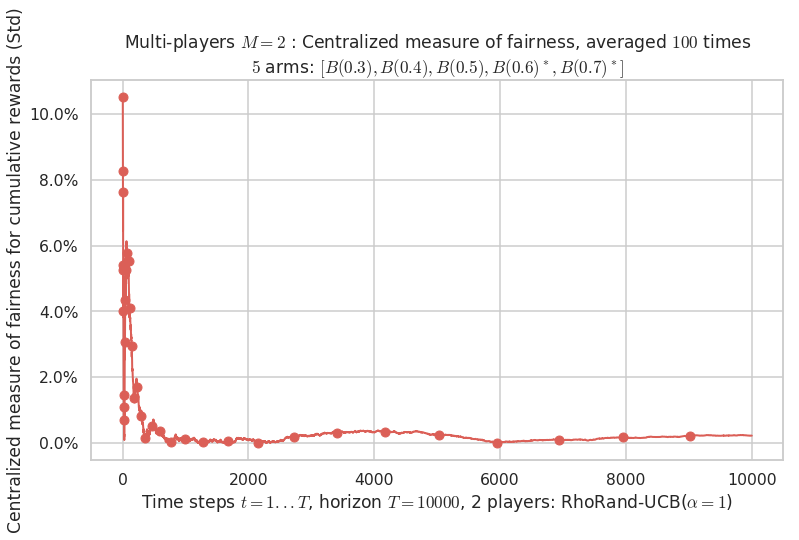
- For 2 players, Anandtharam et al. centralized lower-bound gave = 9 ...
- For 2 players, our lower bound gave = 18 ...
- For 2 players, the initial lower bound in Theorem 6 from [Anandkumar et al., 2010] gave = 12.1 ...
This MAB problem has:
- a [Lai & Robbins] complexity constant C(mu) = 9.46 for 1-player problem ...
- a Optimal Arm Identification factor H_OI(mu) = 60.00% ...
- [Anandtharam et al] centralized lower-bound = 9,
- [Anandkumar et al] decentralized lower-bound = 12.1
- Our better (larger) decentralized lower-bound = 18,
Warning: forcing to use putatright = False because there is 7 items in the legend.
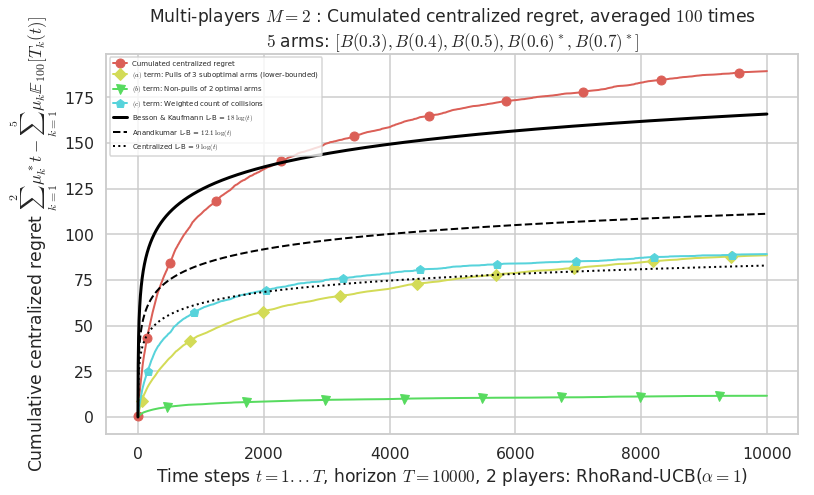
Warning: forcing to use putatright = False because there is 2 items in the legend.

Warning: forcing to use putatright = False because there is 2 items in the legend.
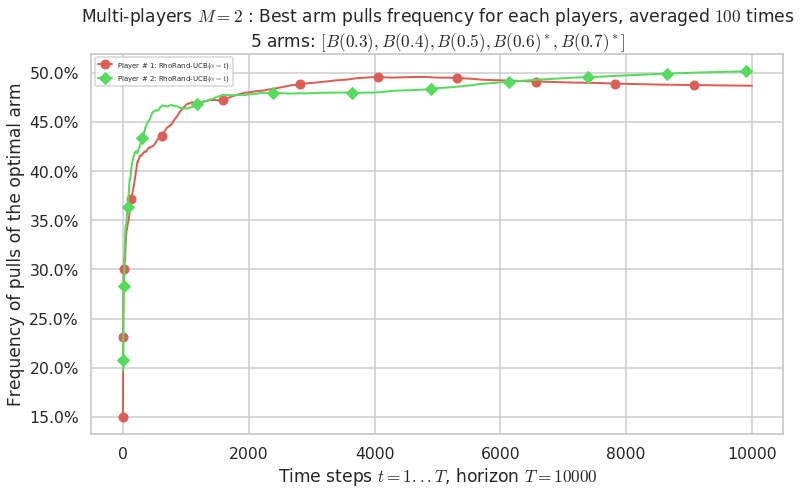
No upper bound for the non-cumulated number of collisions...
Warning: forcing to use putatright = False because there is 1 items in the legend.
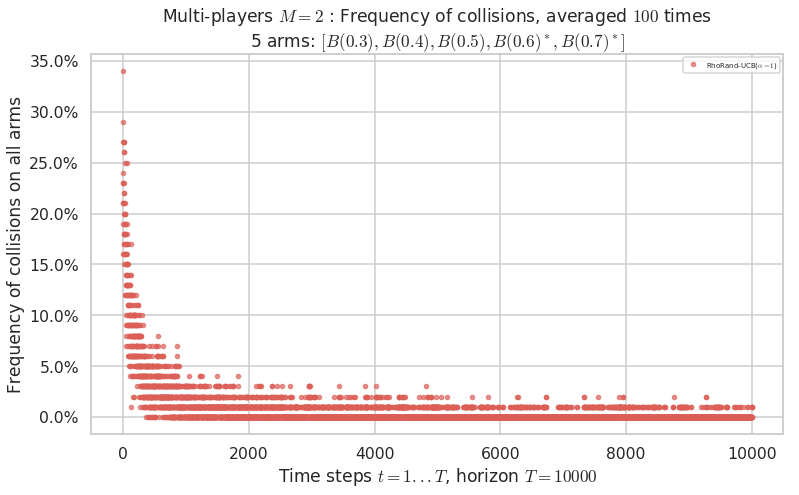
No upper bound for the non-cumulated number of collisions...
Warning: forcing to use putatright = False because there is 1 items in the legend.
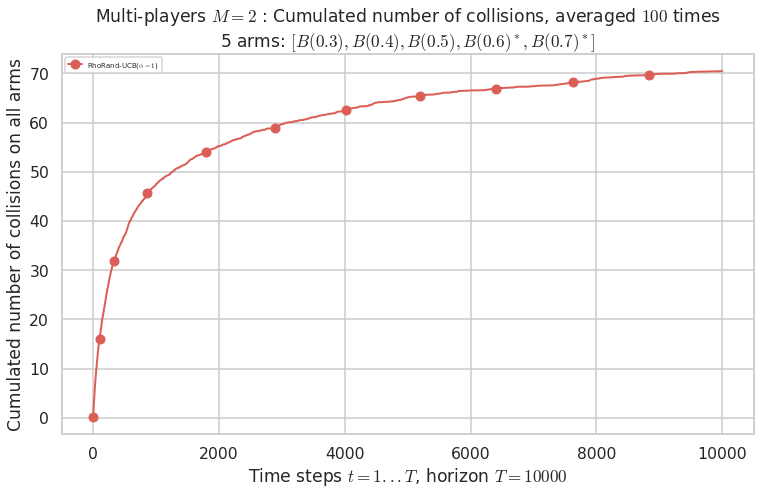
- For #$0$: $B(0.3)$ ($0.0%$$\%$), frequency of collisions is 0.000132 ...
- For #$1$: $B(0.4)$ ($0.0%$$\%$), frequency of collisions is 0.000192 ...
- For #$2$: $B(0.5)$ ($0.0%$$\%$), frequency of collisions is 0.000473 ...
- For #$3$: $B(0.6)$ ($0.3%$$\%$), frequency of collisions is 0.002693 ...
- For #$4$: $B(0.7)$ ($0.4%$$\%$), frequency of collisions is 0.003555 ...
Warning: forcing to use putatright = False because there is 6 items in the legend.
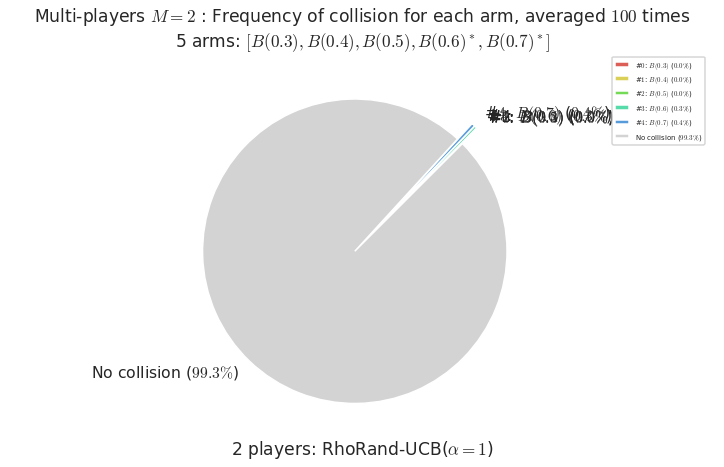
Final ranking for this environment # 0 : Selfish-UCB($\alpha=1$) ...
- Player # 1 / 2, Selfish-UCB($\alpha=1$) was ranked 1 / 2 for this simulation (last rewards = 6448.1).
- Player # 2 / 2, Selfish-UCB($\alpha=1$) was ranked 2 / 2 for this simulation (last rewards = 6348.2).
Warning: forcing to use putatright = False because there is 2 items in the legend.
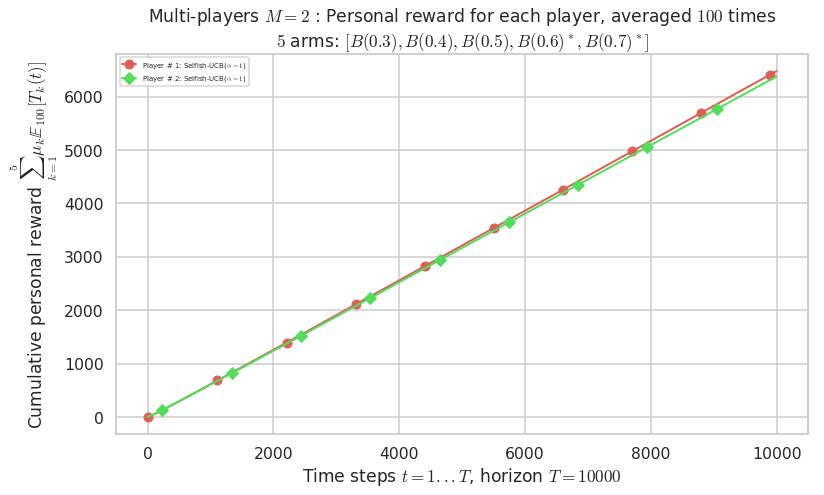
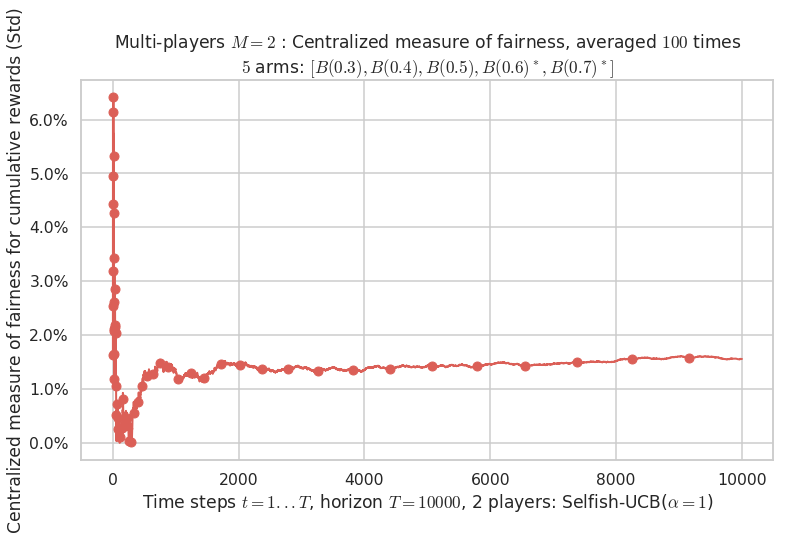
- For 2 players, Anandtharam et al. centralized lower-bound gave = 9 ...
- For 2 players, our lower bound gave = 18 ...
- For 2 players, the initial lower bound in Theorem 6 from [Anandkumar et al., 2010] gave = 12.1 ...
This MAB problem has:
- a [Lai & Robbins] complexity constant C(mu) = 9.46 for 1-player problem ...
- a Optimal Arm Identification factor H_OI(mu) = 60.00% ...
- [Anandtharam et al] centralized lower-bound = 9,
- [Anandkumar et al] decentralized lower-bound = 12.1
- Our better (larger) decentralized lower-bound = 18,
Warning: forcing to use putatright = False because there is 7 items in the legend.
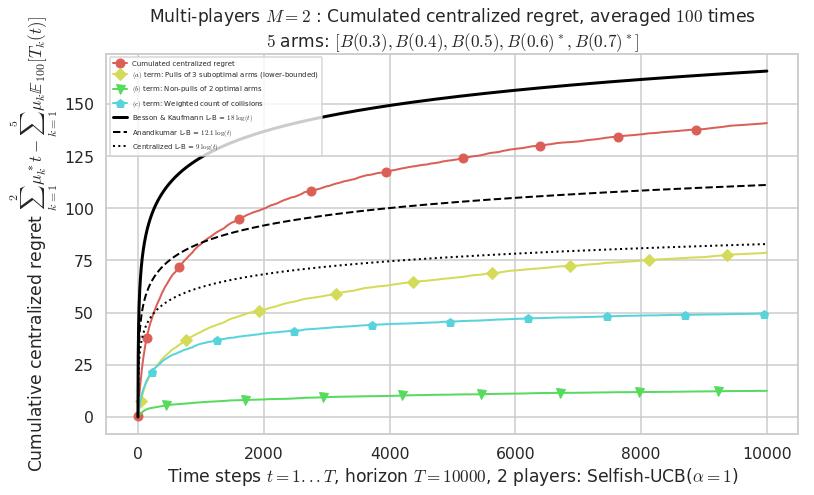
Warning: forcing to use putatright = False because there is 2 items in the legend.
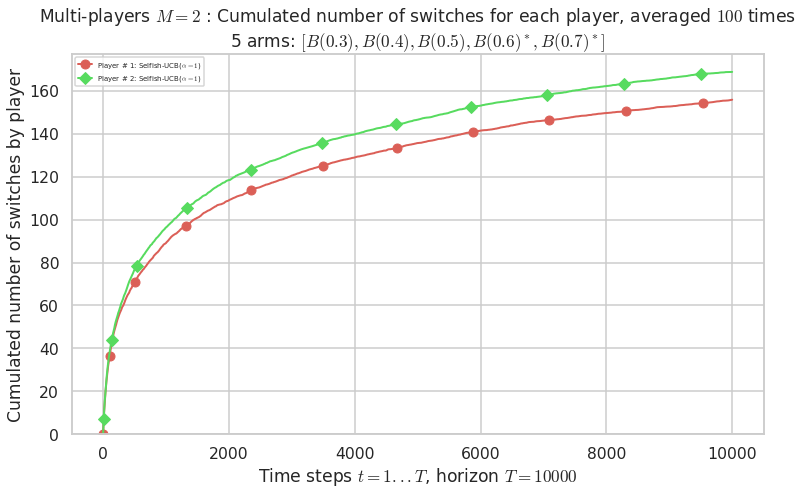
Warning: forcing to use putatright = False because there is 2 items in the legend.
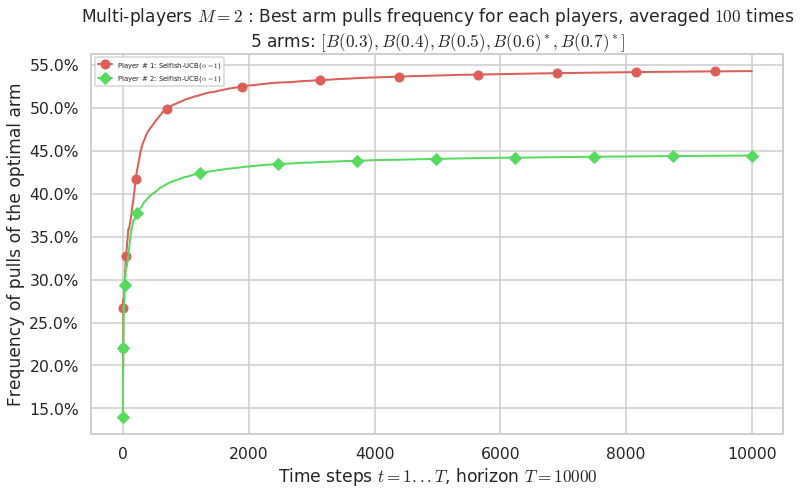
No upper bound for the non-cumulated number of collisions...
Warning: forcing to use putatright = False because there is 1 items in the legend.
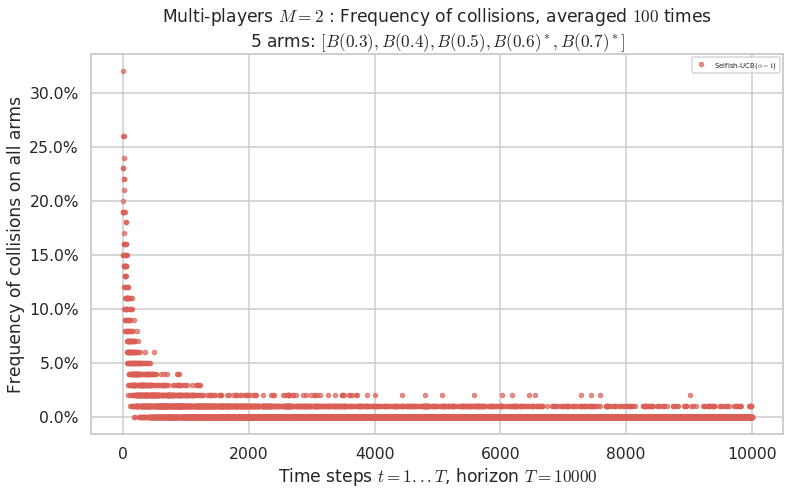
No upper bound for the non-cumulated number of collisions...
Warning: forcing to use putatright = False because there is 1 items in the legend.
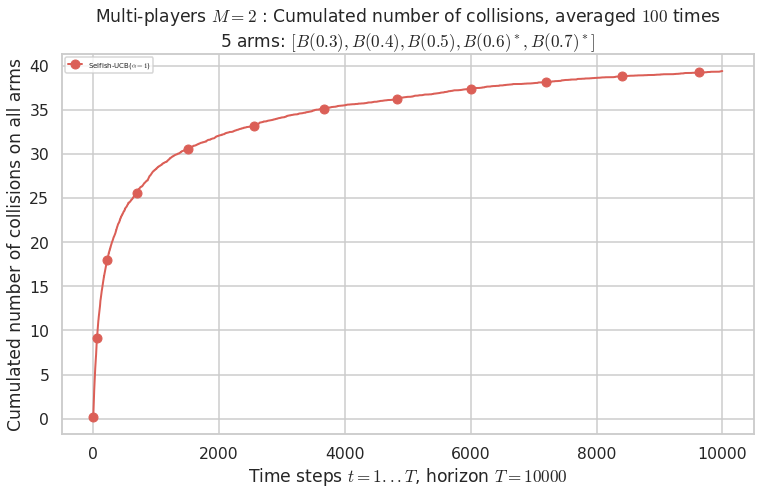
- For #$0$: $B(0.3)$ ($0.0%$$\%$), frequency of collisions is 0.000109 ...
- For #$1$: $B(0.4)$ ($0.0%$$\%$), frequency of collisions is 0.000181 ...
- For #$2$: $B(0.5)$ ($0.0%$$\%$), frequency of collisions is 0.000331 ...
- For #$3$: $B(0.6)$ ($0.1%$$\%$), frequency of collisions is 0.001118 ...
- For #$4$: $B(0.7)$ ($0.2%$$\%$), frequency of collisions is 0.002199 ...
Warning: forcing to use putatright = False because there is 6 items in the legend.
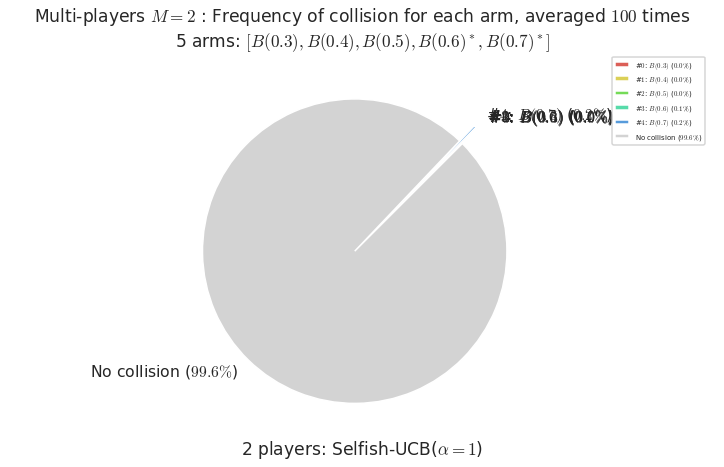
Final ranking for this environment # 0 : RhoRand-Thompson ...
- Player # 1 / 2, RhoRand-Thompson was ranked 1 / 2 for this simulation (last rewards = 6369.6).
- Player # 2 / 2, RhoRand-Thompson was ranked 2 / 2 for this simulation (last rewards = 6267.1).
Warning: forcing to use putatright = False because there is 2 items in the legend.
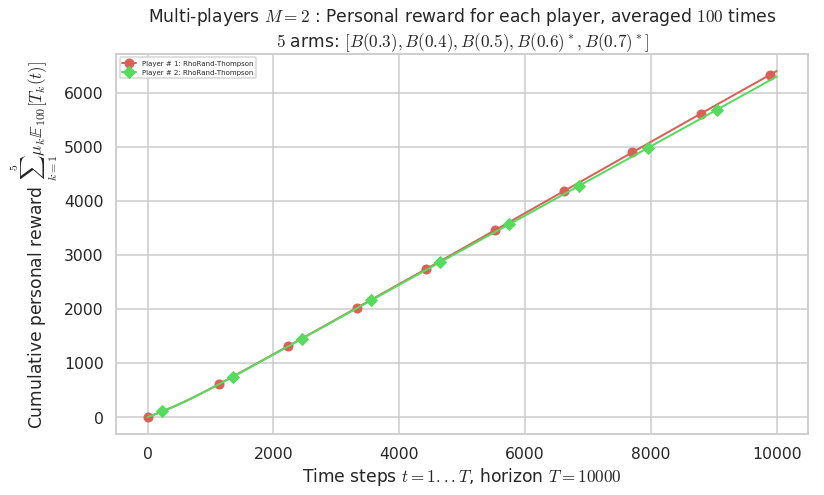
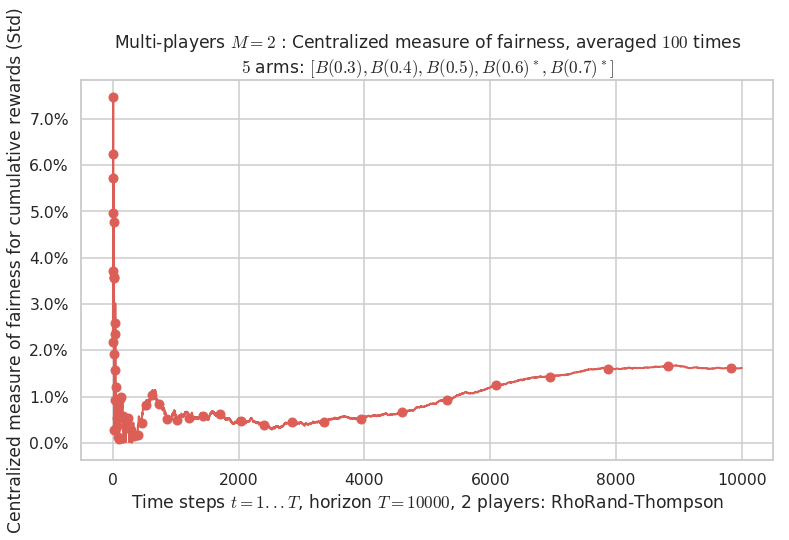
- For 2 players, Anandtharam et al. centralized lower-bound gave = 9 ...
- For 2 players, our lower bound gave = 18 ...
- For 2 players, the initial lower bound in Theorem 6 from [Anandkumar et al., 2010] gave = 12.1 ...
This MAB problem has:
- a [Lai & Robbins] complexity constant C(mu) = 9.46 for 1-player problem ...
- a Optimal Arm Identification factor H_OI(mu) = 60.00% ...
- [Anandtharam et al] centralized lower-bound = 9,
- [Anandkumar et al] decentralized lower-bound = 12.1
- Our better (larger) decentralized lower-bound = 18,
Warning: forcing to use putatright = False because there is 7 items in the legend.
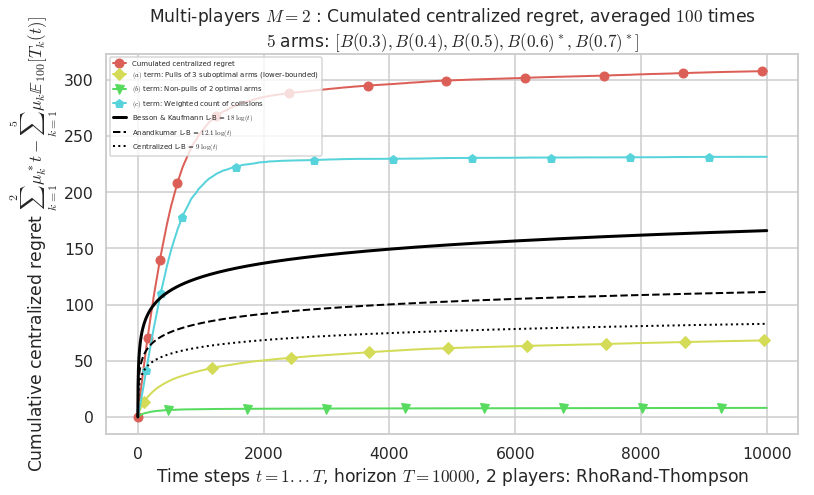
Warning: forcing to use putatright = False because there is 2 items in the legend.
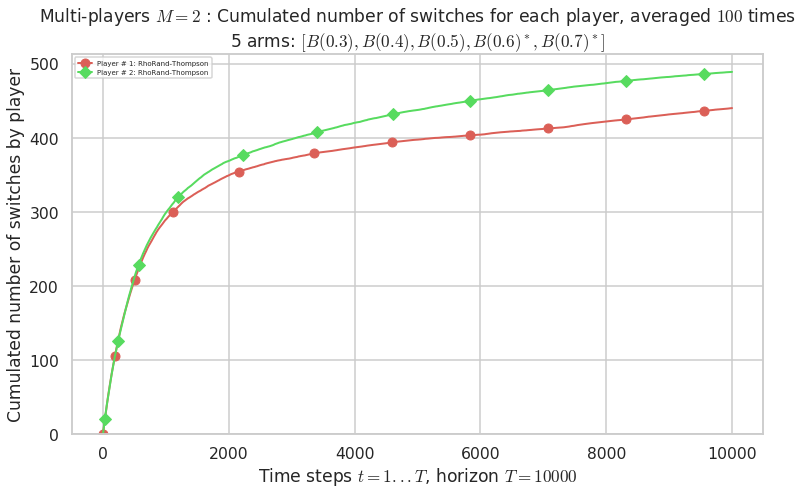
Warning: forcing to use putatright = False because there is 2 items in the legend.
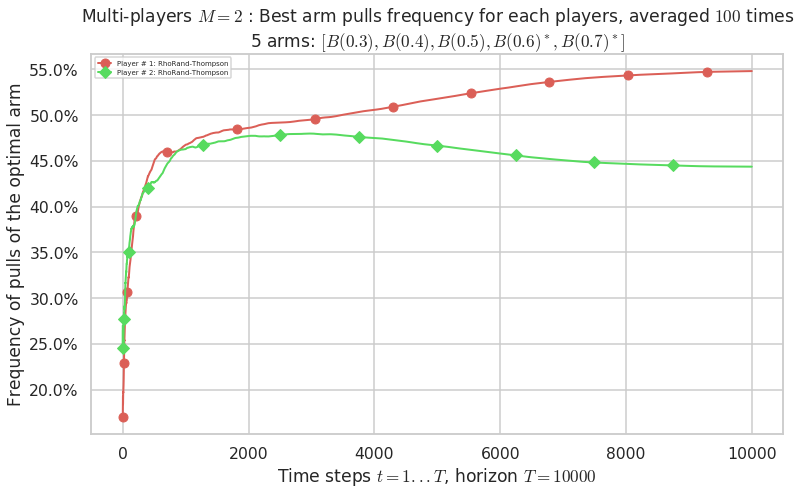
No upper bound for the non-cumulated number of collisions...
Warning: forcing to use putatright = False because there is 1 items in the legend.
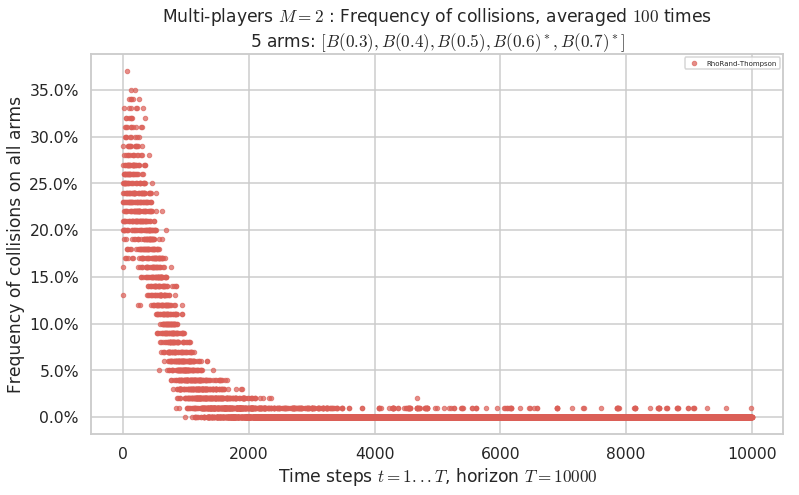
No upper bound for the non-cumulated number of collisions...
Warning: forcing to use putatright = False because there is 1 items in the legend.
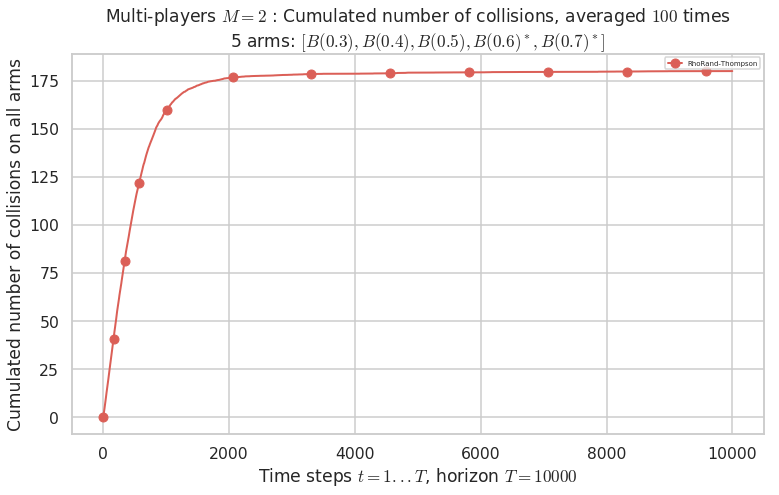
- For #$0$: $B(0.3)$ ($0.0%$$\%$), frequency of collisions is 0.000108 ...
- For #$1$: $B(0.4)$ ($0.0%$$\%$), frequency of collisions is 0.000226 ...
- For #$2$: $B(0.5)$ ($0.1%$$\%$), frequency of collisions is 0.000793 ...
- For #$3$: $B(0.6)$ ($0.8%$$\%$), frequency of collisions is 0.007542 ...
- For #$4$: $B(0.7)$ ($0.9%$$\%$), frequency of collisions is 0.009321 ...
Warning: forcing to use putatright = False because there is 6 items in the legend.
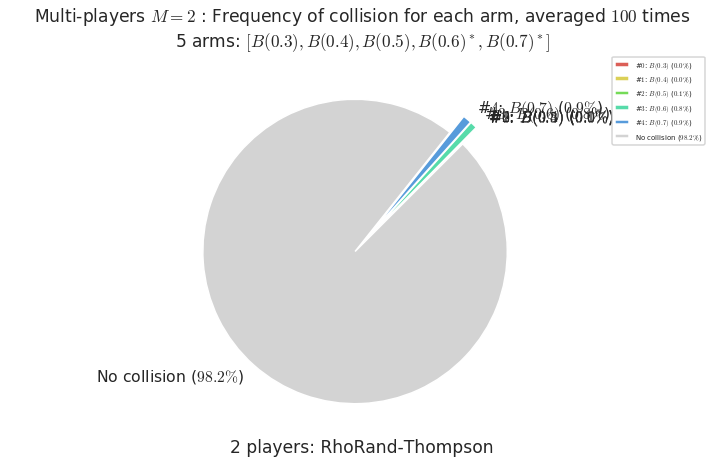
Final ranking for this environment # 0 : Selfish-Thompson ...
- Player # 1 / 2, Selfish-Thompson was ranked 1 / 2 for this simulation (last rewards = 6498.6).
- Player # 2 / 2, Selfish-Thompson was ranked 2 / 2 for this simulation (last rewards = 6347.1).
Warning: forcing to use putatright = False because there is 2 items in the legend.
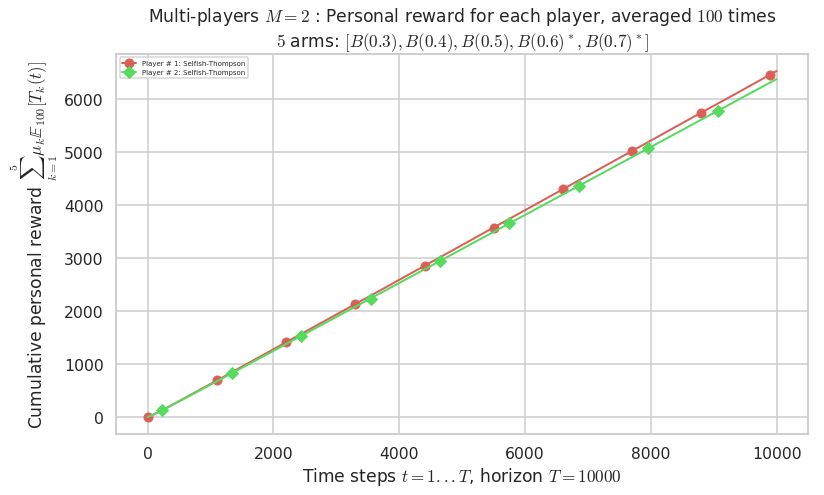
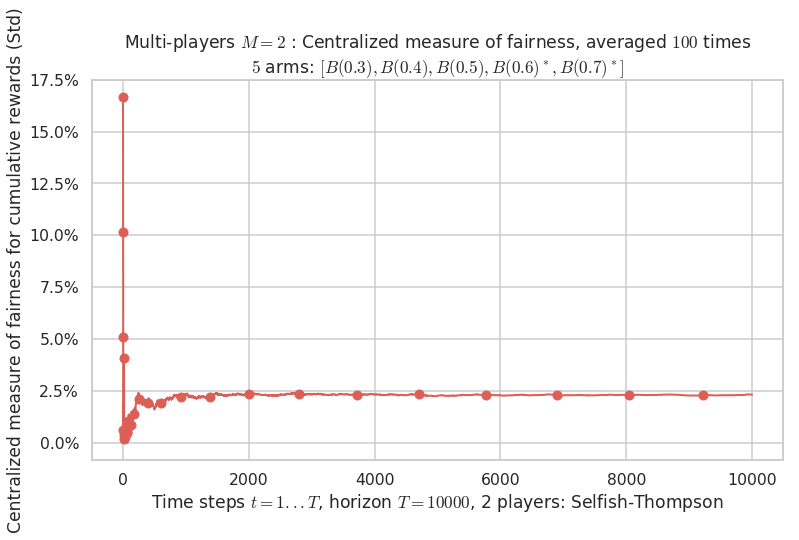
- For 2 players, Anandtharam et al. centralized lower-bound gave = 9 ...
- For 2 players, our lower bound gave = 18 ...
- For 2 players, the initial lower bound in Theorem 6 from [Anandkumar et al., 2010] gave = 12.1 ...
This MAB problem has:
- a [Lai & Robbins] complexity constant C(mu) = 9.46 for 1-player problem ...
- a Optimal Arm Identification factor H_OI(mu) = 60.00% ...
- [Anandtharam et al] centralized lower-bound = 9,
- [Anandkumar et al] decentralized lower-bound = 12.1
- Our better (larger) decentralized lower-bound = 18,
Warning: forcing to use putatright = False because there is 7 items in the legend.
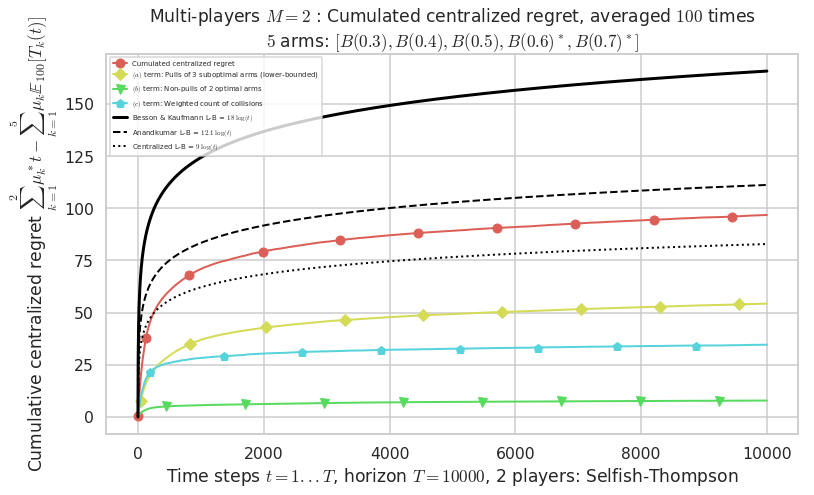
Warning: forcing to use putatright = False because there is 2 items in the legend.
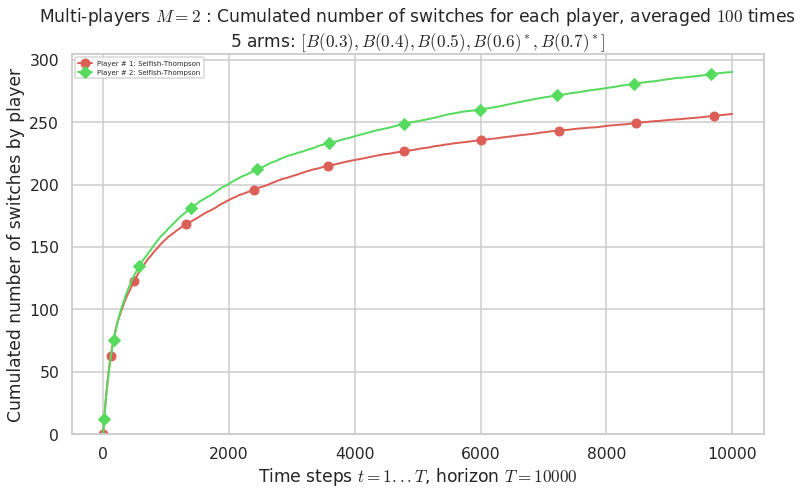
Warning: forcing to use putatright = False because there is 2 items in the legend.
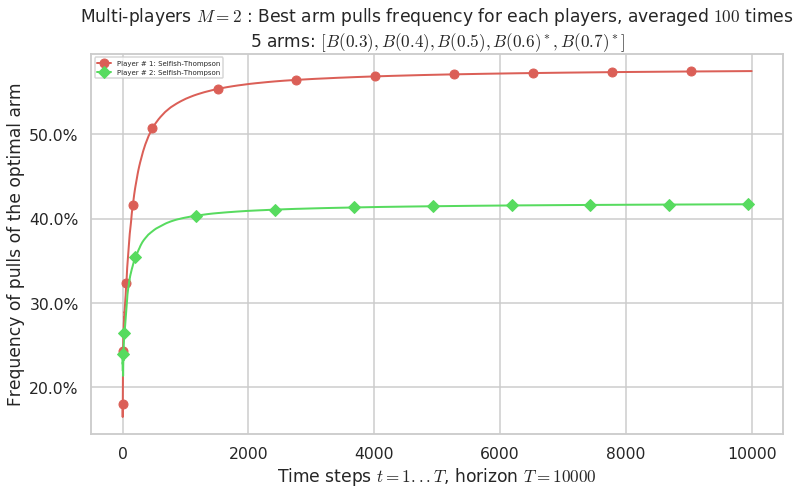
No upper bound for the non-cumulated number of collisions...
Warning: forcing to use putatright = False because there is 1 items in the legend.

No upper bound for the non-cumulated number of collisions...
Warning: forcing to use putatright = False because there is 1 items in the legend.
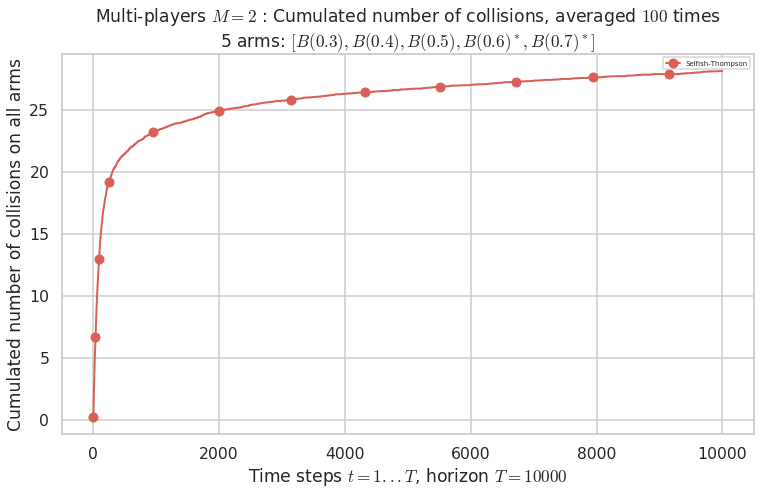
- For #$0$: $B(0.3)$ ($0.0%$$\%$), frequency of collisions is 0.000107 ...
- For #$1$: $B(0.4)$ ($0.0%$$\%$), frequency of collisions is 0.000153 ...
- For #$2$: $B(0.5)$ ($0.0%$$\%$), frequency of collisions is 0.000326 ...
- For #$3$: $B(0.6)$ ($0.1%$$\%$), frequency of collisions is 0.000851 ...
- For #$4$: $B(0.7)$ ($0.1%$$\%$), frequency of collisions is 0.001377 ...
Warning: forcing to use putatright = False because there is 6 items in the legend.

Final ranking for this environment # 0 : RhoRand-kl-UCB ...
- Player # 1 / 2, RhoRand-kl-UCB was ranked 1 / 2 for this simulation (last rewards = 6410.4).
- Player # 2 / 2, RhoRand-kl-UCB was ranked 2 / 2 for this simulation (last rewards = 6356.7).
Warning: forcing to use putatright = False because there is 2 items in the legend.
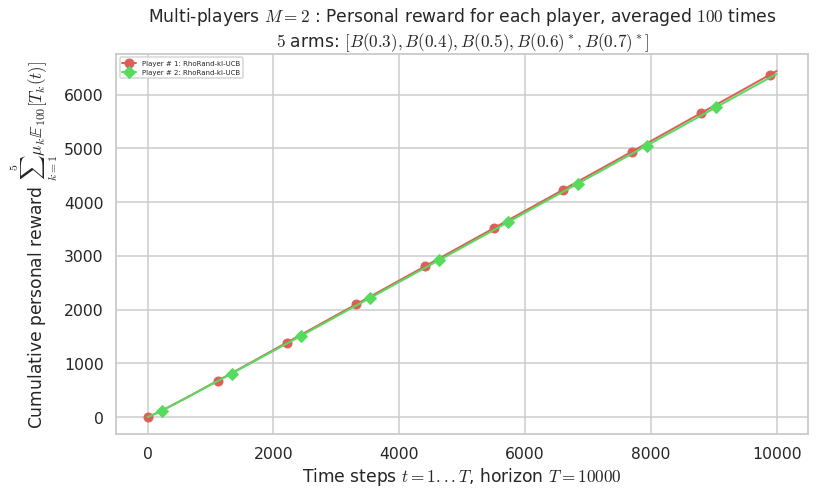
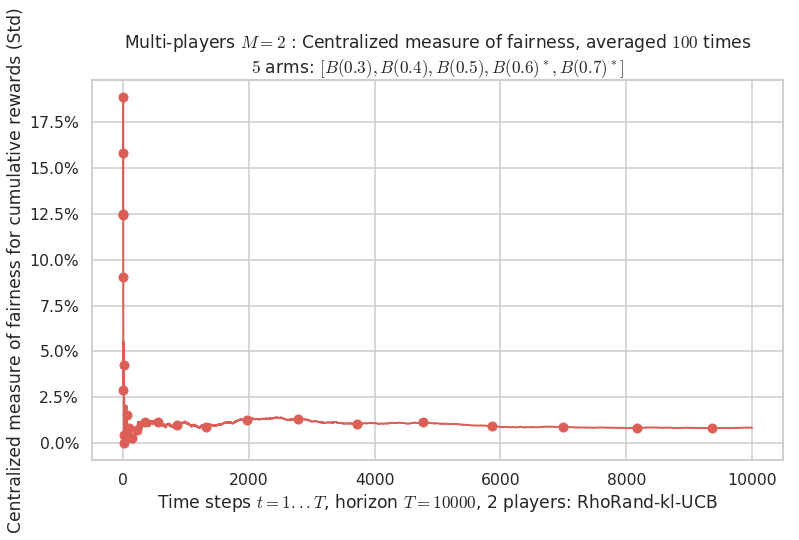
- For 2 players, Anandtharam et al. centralized lower-bound gave = 9 ...
- For 2 players, our lower bound gave = 18 ...
- For 2 players, the initial lower bound in Theorem 6 from [Anandkumar et al., 2010] gave = 12.1 ...
This MAB problem has:
- a [Lai & Robbins] complexity constant C(mu) = 9.46 for 1-player problem ...
- a Optimal Arm Identification factor H_OI(mu) = 60.00% ...
- [Anandtharam et al] centralized lower-bound = 9,
- [Anandkumar et al] decentralized lower-bound = 12.1
- Our better (larger) decentralized lower-bound = 18,
Warning: forcing to use putatright = False because there is 7 items in the legend.
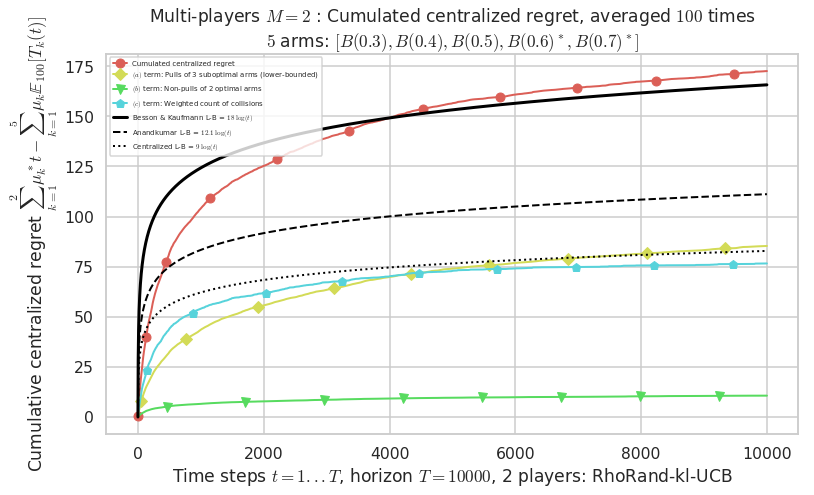
Warning: forcing to use putatright = False because there is 2 items in the legend.
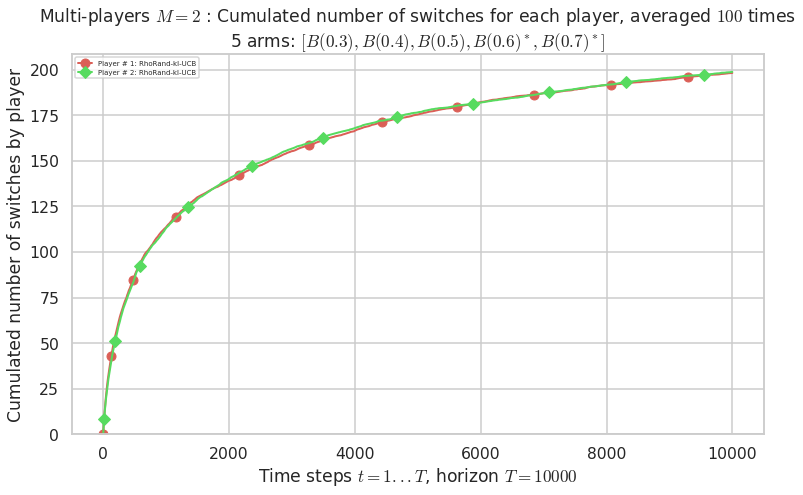
Warning: forcing to use putatright = False because there is 2 items in the legend.

No upper bound for the non-cumulated number of collisions...
Warning: forcing to use putatright = False because there is 1 items in the legend.
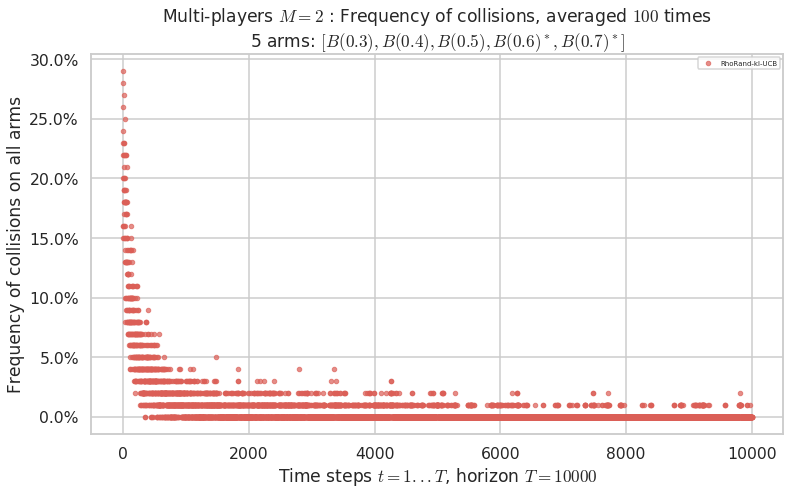
No upper bound for the non-cumulated number of collisions...
Warning: forcing to use putatright = False because there is 1 items in the legend.
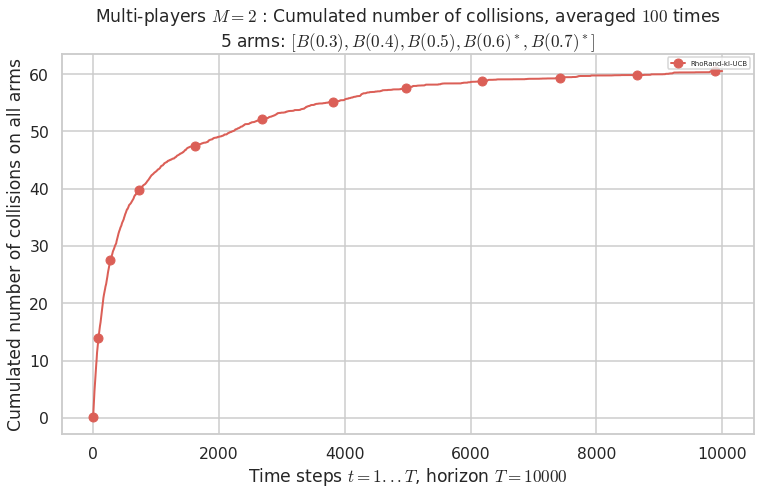
- For #$0$: $B(0.3)$ ($0.0%$$\%$), frequency of collisions is 0.000109 ...
- For #$1$: $B(0.4)$ ($0.0%$$\%$), frequency of collisions is 0.000178 ...
- For #$2$: $B(0.5)$ ($0.0%$$\%$), frequency of collisions is 0.000423 ...
- For #$3$: $B(0.6)$ ($0.2%$$\%$), frequency of collisions is 0.002254 ...
- For #$4$: $B(0.7)$ ($0.3%$$\%$), frequency of collisions is 0.00309 ...
Warning: forcing to use putatright = False because there is 6 items in the legend.
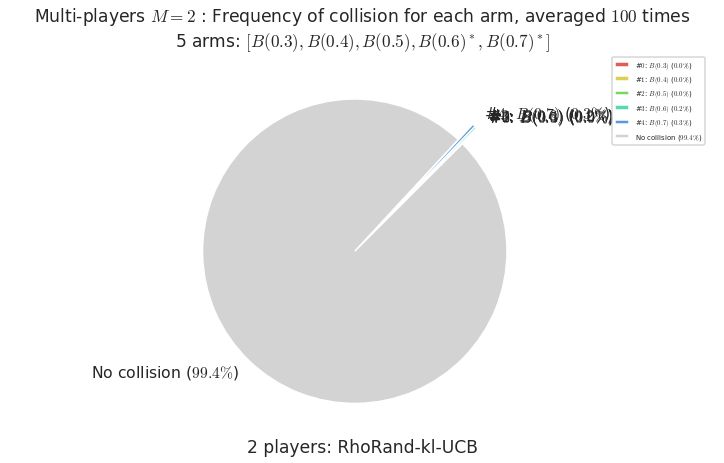
Final ranking for this environment # 0 : Selfish-kl-UCB ...
- Player # 1 / 2, Selfish-kl-UCB was ranked 1 / 2 for this simulation (last rewards = 6418.6).
- Player # 2 / 2, Selfish-kl-UCB was ranked 2 / 2 for this simulation (last rewards = 6388.8).
Warning: forcing to use putatright = False because there is 2 items in the legend.
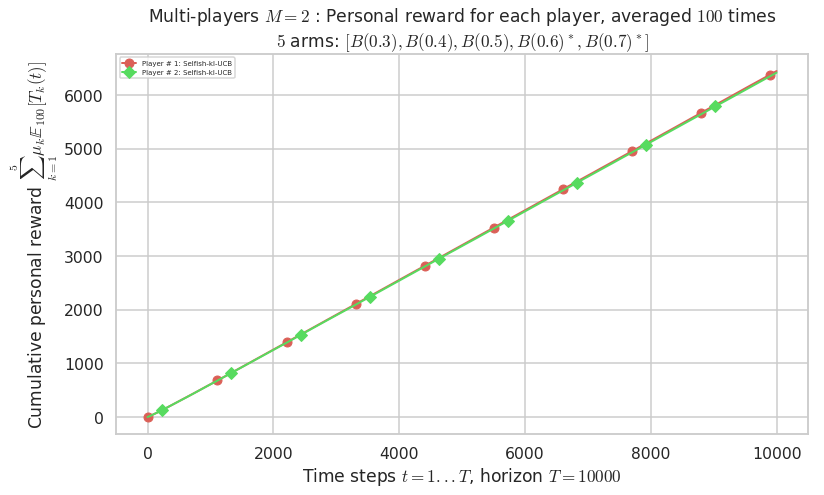
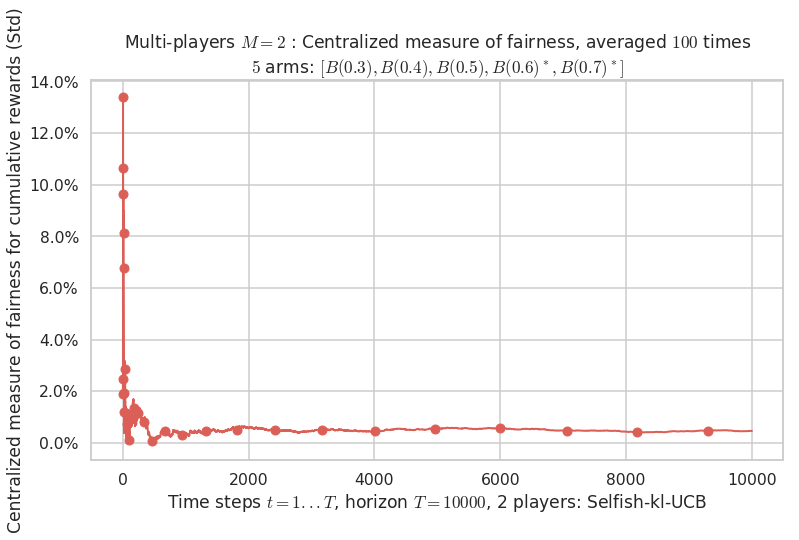
- For 2 players, Anandtharam et al. centralized lower-bound gave = 9 ...
- For 2 players, our lower bound gave = 18 ...
- For 2 players, the initial lower bound in Theorem 6 from [Anandkumar et al., 2010] gave = 12.1 ...
This MAB problem has:
- a [Lai & Robbins] complexity constant C(mu) = 9.46 for 1-player problem ...
- a Optimal Arm Identification factor H_OI(mu) = 60.00% ...
- [Anandtharam et al] centralized lower-bound = 9,
- [Anandkumar et al] decentralized lower-bound = 12.1
- Our better (larger) decentralized lower-bound = 18,
Warning: forcing to use putatright = False because there is 7 items in the legend.

Warning: forcing to use putatright = False because there is 2 items in the legend.

Warning: forcing to use putatright = False because there is 2 items in the legend.
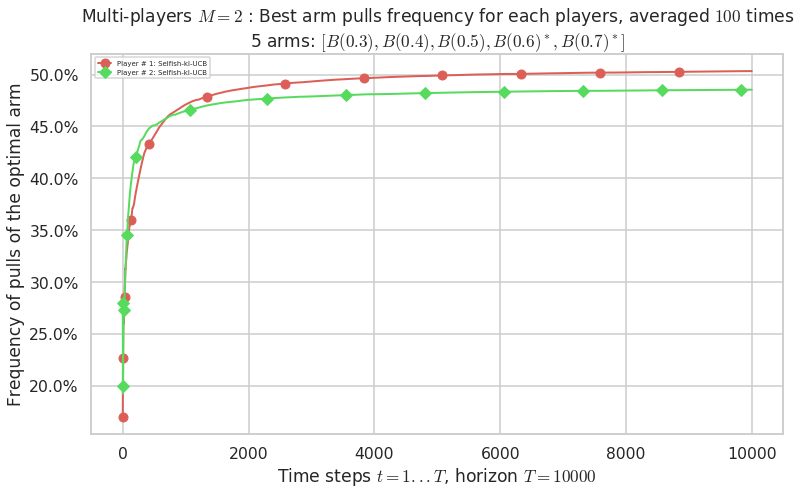
No upper bound for the non-cumulated number of collisions...
Warning: forcing to use putatright = False because there is 1 items in the legend.
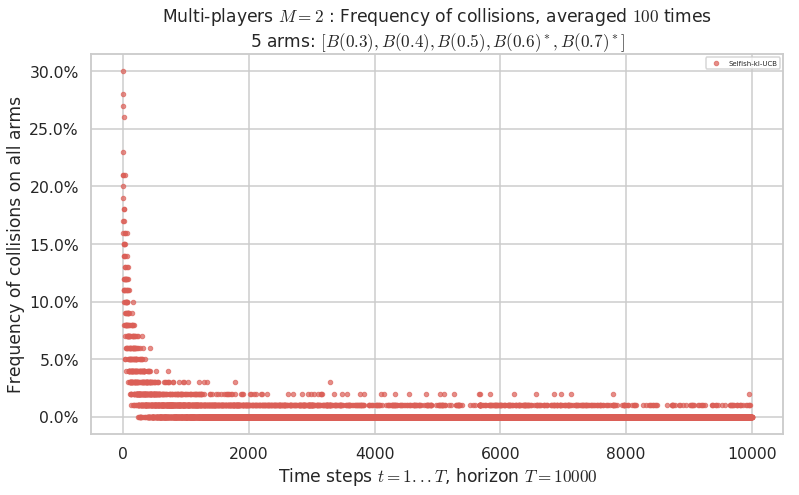
No upper bound for the non-cumulated number of collisions...
Warning: forcing to use putatright = False because there is 1 items in the legend.
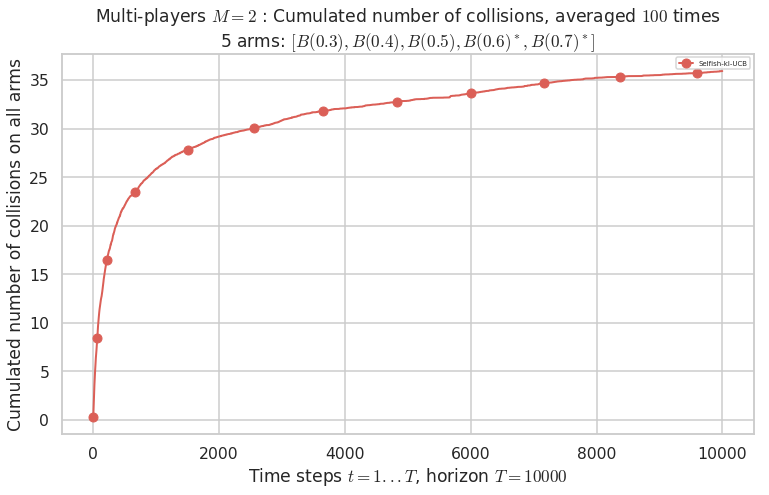
- For #$0$: $B(0.3)$ ($0.0%$$\%$), frequency of collisions is 9.6e-05 ...
- For #$1$: $B(0.4)$ ($0.0%$$\%$), frequency of collisions is 0.000152 ...
- For #$2$: $B(0.5)$ ($0.0%$$\%$), frequency of collisions is 0.000278 ...
- For #$3$: $B(0.6)$ ($0.1%$$\%$), frequency of collisions is 0.001086 ...
- For #$4$: $B(0.7)$ ($0.2%$$\%$), frequency of collisions is 0.00198 ...
Warning: forcing to use putatright = False because there is 5 items in the legend.
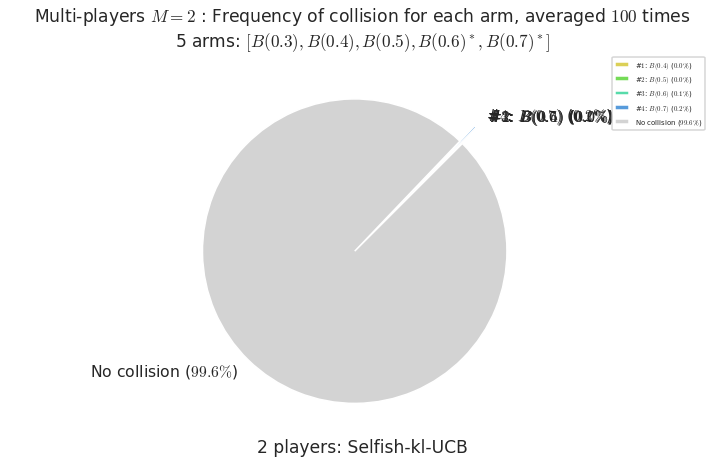
Second problem¶
\(\mu = [0.1, 0.3, 0.5, 0.7, 0.9]\) was an easier Bernoulli problem, with larger gap \(\Delta = 0.2\).
[31]:
for playersId in tqdm(range(len(evs)), desc="Policies"):
evaluation = evaluators[1][playersId]
plotAll(evaluation, 1)
Final ranking for this environment # 1 : RhoRand-UCB($\alpha=1$) ...
- Player # 2 / 2, RhoRand-UCB($\alpha=1$) was ranked 1 / 2 for this simulation (last rewards = 8048).
- Player # 1 / 2, RhoRand-UCB($\alpha=1$) was ranked 2 / 2 for this simulation (last rewards = 7784.3).
Warning: forcing to use putatright = False because there is 2 items in the legend.

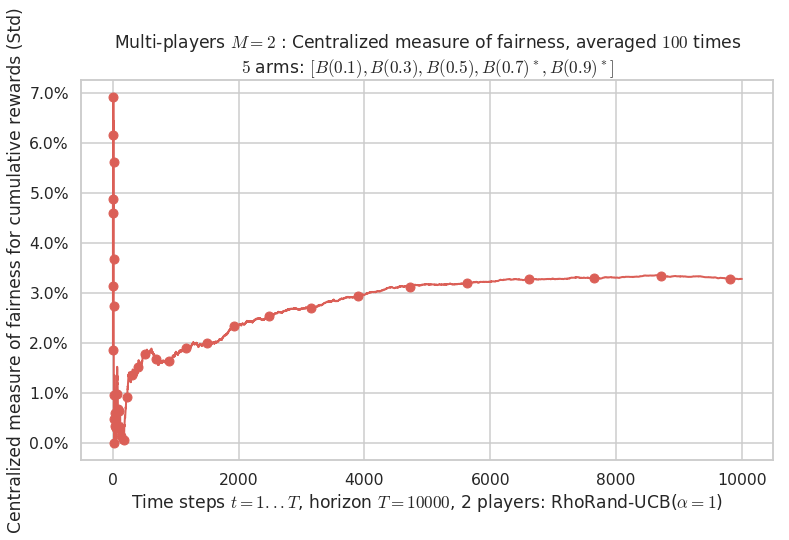
- For 2 players, Anandtharam et al. centralized lower-bound gave = 4.23 ...
- For 2 players, our lower bound gave = 8.46 ...
- For 2 players, the initial lower bound in Theorem 6 from [Anandkumar et al., 2010] gave = 5.35 ...
This MAB problem has:
- a [Lai & Robbins] complexity constant C(mu) = 3.12 for 1-player problem ...
- a Optimal Arm Identification factor H_OI(mu) = 40.00% ...
- [Anandtharam et al] centralized lower-bound = 4.23,
- [Anandkumar et al] decentralized lower-bound = 5.35
- Our better (larger) decentralized lower-bound = 8.46,
Warning: forcing to use putatright = False because there is 7 items in the legend.
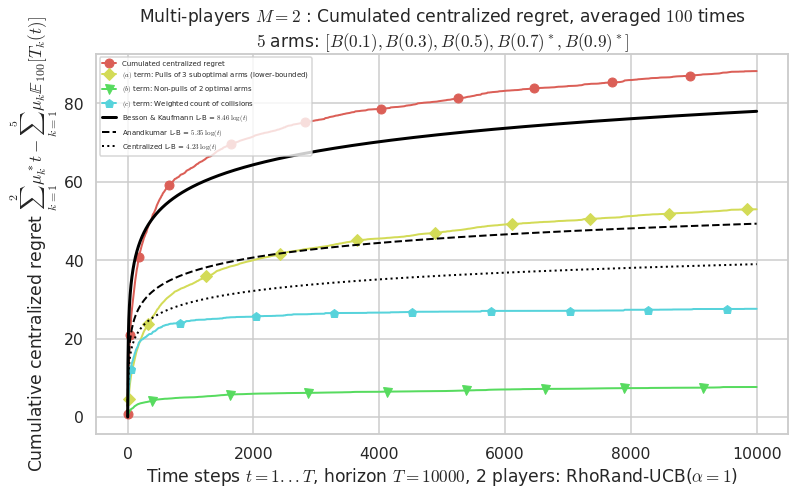
Warning: forcing to use putatright = False because there is 2 items in the legend.
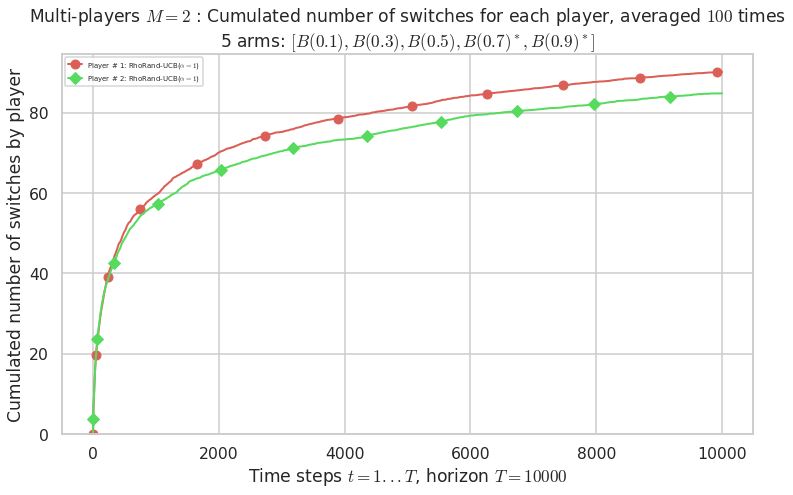
Warning: forcing to use putatright = False because there is 2 items in the legend.
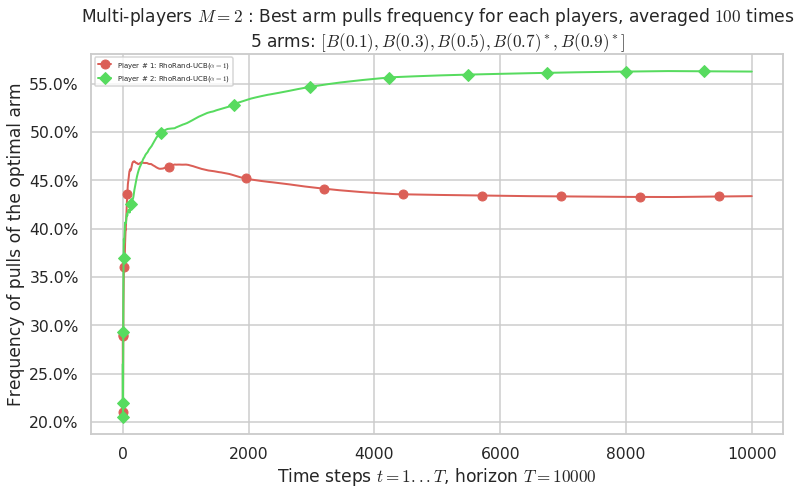
No upper bound for the non-cumulated number of collisions...
Warning: forcing to use putatright = False because there is 1 items in the legend.
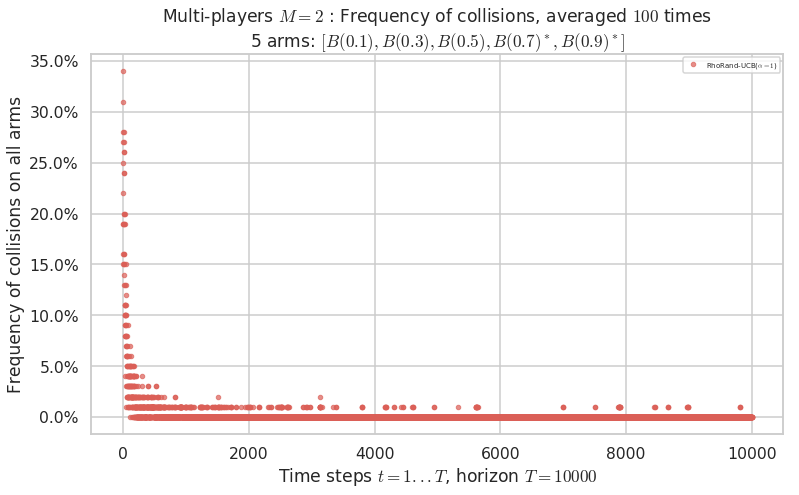
No upper bound for the non-cumulated number of collisions...
Warning: forcing to use putatright = False because there is 1 items in the legend.
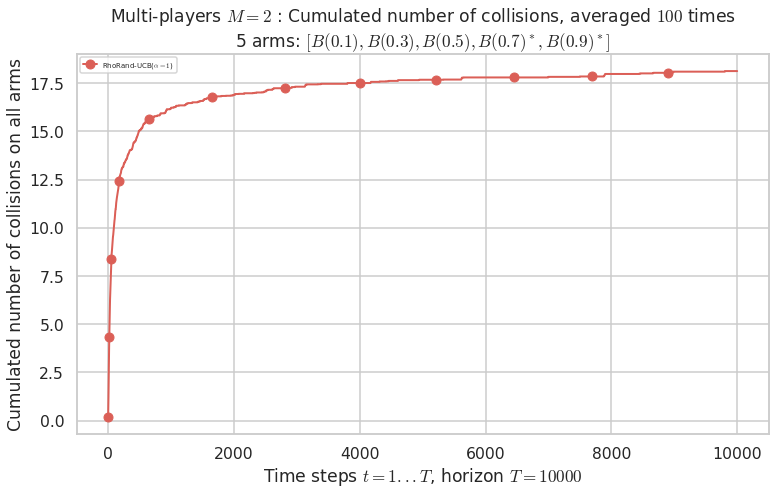
- For #$0$: $B(0.1)$ ($0.0%$$\%$), frequency of collisions is 2.3e-05 ...
- For #$1$: $B(0.3)$ ($0.0%$$\%$), frequency of collisions is 5.3e-05 ...
- For #$2$: $B(0.5)$ ($0.0%$$\%$), frequency of collisions is 0.000152 ...
- For #$3$: $B(0.7)$ ($0.1%$$\%$), frequency of collisions is 0.00071 ...
- For #$4$: $B(0.9)$ ($0.1%$$\%$), frequency of collisions is 0.000875 ...
Warning: forcing to use putatright = False because there is 4 items in the legend.
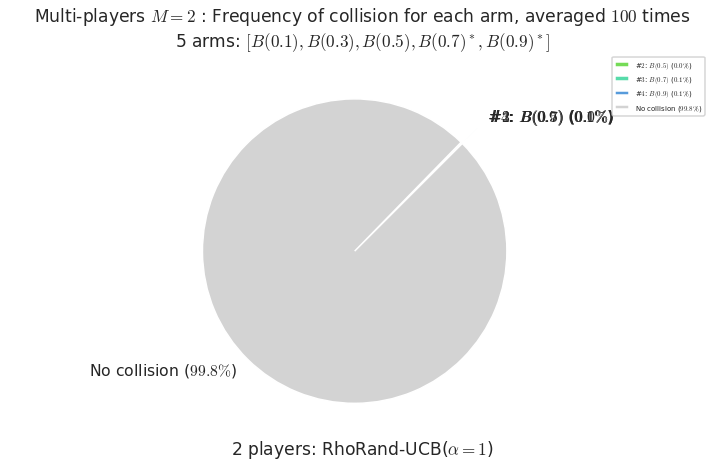
Final ranking for this environment # 1 : Selfish-UCB($\alpha=1$) ...
- Player # 2 / 2, Selfish-UCB($\alpha=1$) was ranked 1 / 2 for this simulation (last rewards = 7930.9).
- Player # 1 / 2, Selfish-UCB($\alpha=1$) was ranked 2 / 2 for this simulation (last rewards = 7896.6).
Warning: forcing to use putatright = False because there is 2 items in the legend.
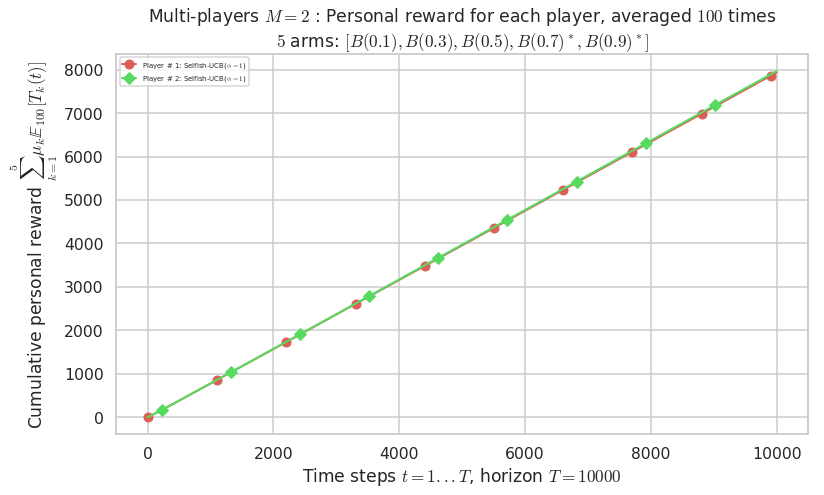
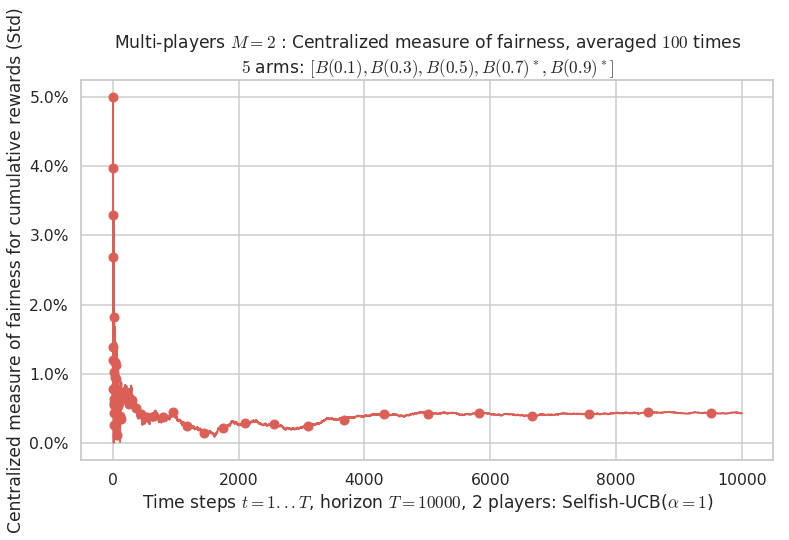
- For 2 players, Anandtharam et al. centralized lower-bound gave = 4.23 ...
- For 2 players, our lower bound gave = 8.46 ...
- For 2 players, the initial lower bound in Theorem 6 from [Anandkumar et al., 2010] gave = 5.35 ...
This MAB problem has:
- a [Lai & Robbins] complexity constant C(mu) = 3.12 for 1-player problem ...
- a Optimal Arm Identification factor H_OI(mu) = 40.00% ...
- [Anandtharam et al] centralized lower-bound = 4.23,
- [Anandkumar et al] decentralized lower-bound = 5.35
- Our better (larger) decentralized lower-bound = 8.46,
Warning: forcing to use putatright = False because there is 7 items in the legend.
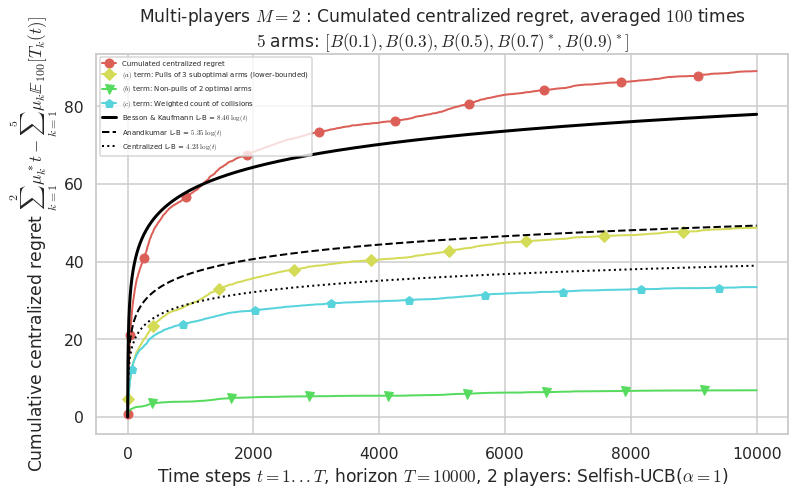
Warning: forcing to use putatright = False because there is 2 items in the legend.
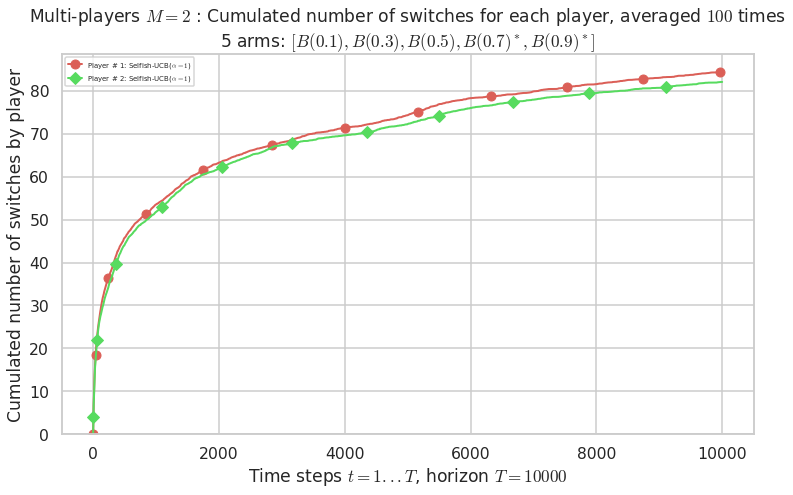
Warning: forcing to use putatright = False because there is 2 items in the legend.
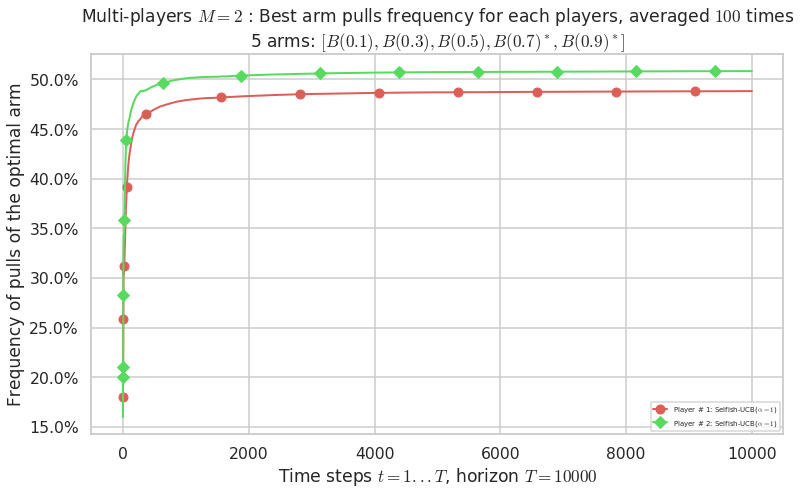
No upper bound for the non-cumulated number of collisions...
Warning: forcing to use putatright = False because there is 1 items in the legend.
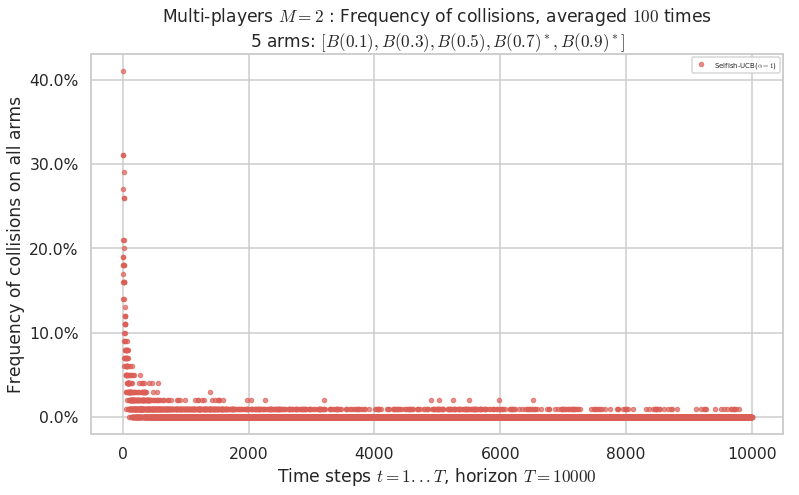
No upper bound for the non-cumulated number of collisions...
Warning: forcing to use putatright = False because there is 1 items in the legend.

- For #$0$: $B(0.1)$ ($0.0%$$\%$), frequency of collisions is 4.2e-05 ...
- For #$1$: $B(0.3)$ ($0.0%$$\%$), frequency of collisions is 5.7e-05 ...
- For #$2$: $B(0.5)$ ($0.0%$$\%$), frequency of collisions is 0.000136 ...
- For #$3$: $B(0.7)$ ($0.1%$$\%$), frequency of collisions is 0.000614 ...
- For #$4$: $B(0.9)$ ($0.1%$$\%$), frequency of collisions is 0.001281 ...
Warning: forcing to use putatright = False because there is 4 items in the legend.
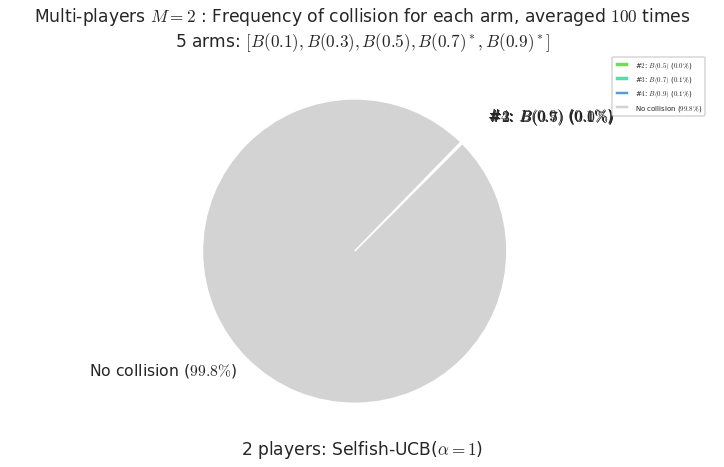
Final ranking for this environment # 1 : RhoRand-Thompson ...
- Player # 1 / 2, RhoRand-Thompson was ranked 1 / 2 for this simulation (last rewards = 8034.6).
- Player # 2 / 2, RhoRand-Thompson was ranked 2 / 2 for this simulation (last rewards = 7793.9).
Warning: forcing to use putatright = False because there is 2 items in the legend.
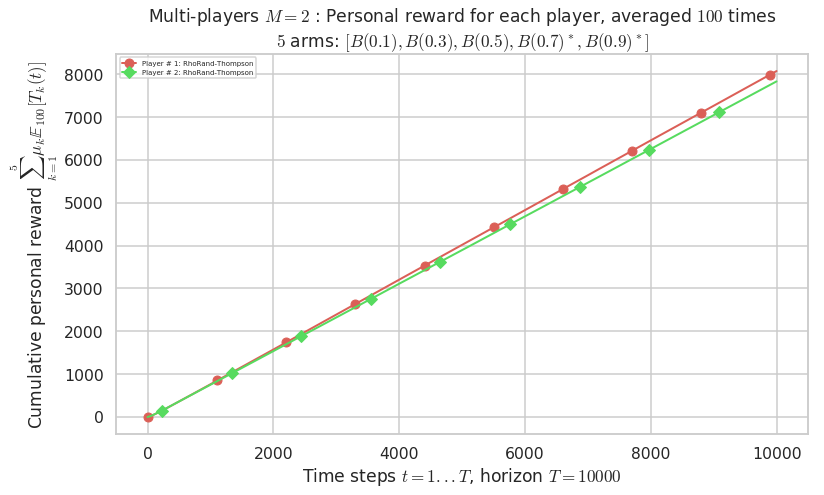
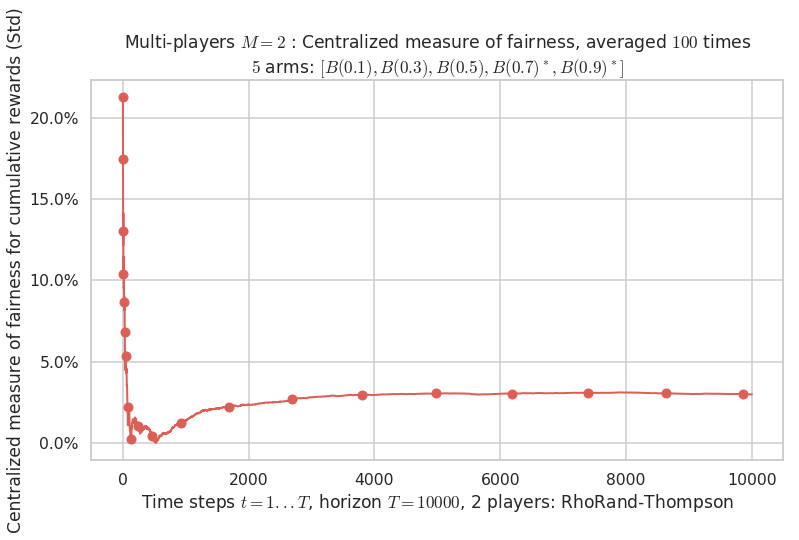
- For 2 players, Anandtharam et al. centralized lower-bound gave = 4.23 ...
- For 2 players, our lower bound gave = 8.46 ...
- For 2 players, the initial lower bound in Theorem 6 from [Anandkumar et al., 2010] gave = 5.35 ...
This MAB problem has:
- a [Lai & Robbins] complexity constant C(mu) = 3.12 for 1-player problem ...
- a Optimal Arm Identification factor H_OI(mu) = 40.00% ...
- [Anandtharam et al] centralized lower-bound = 4.23,
- [Anandkumar et al] decentralized lower-bound = 5.35
- Our better (larger) decentralized lower-bound = 8.46,
Warning: forcing to use putatright = False because there is 7 items in the legend.
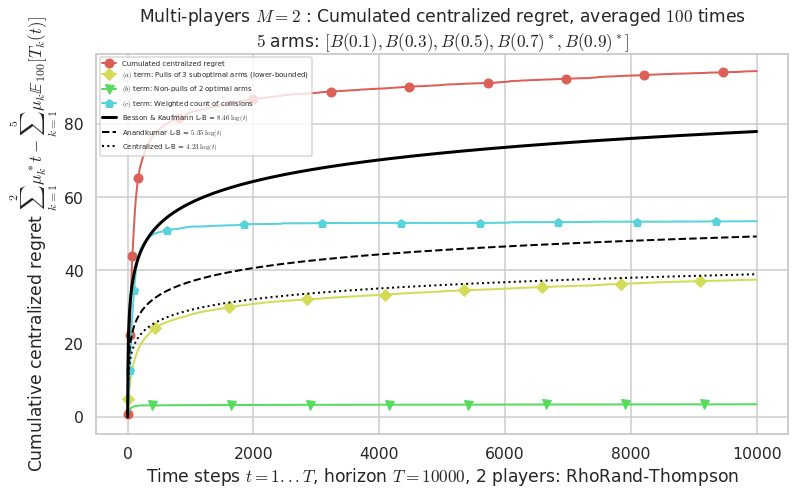
Warning: forcing to use putatright = False because there is 2 items in the legend.
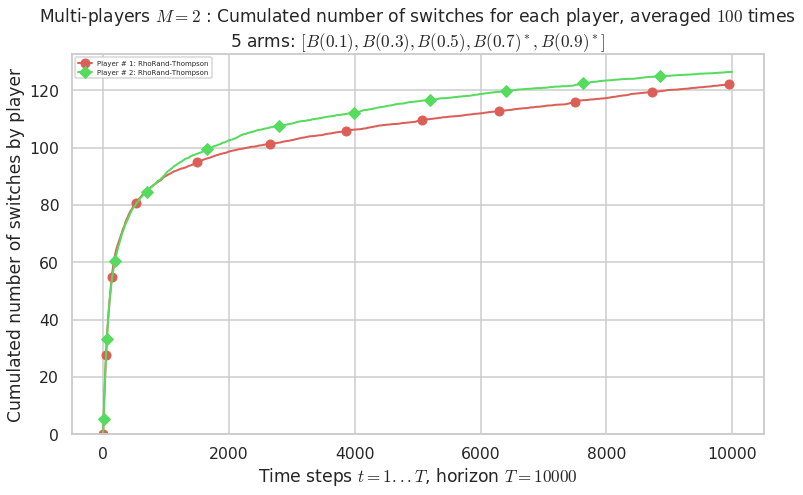
Warning: forcing to use putatright = False because there is 2 items in the legend.
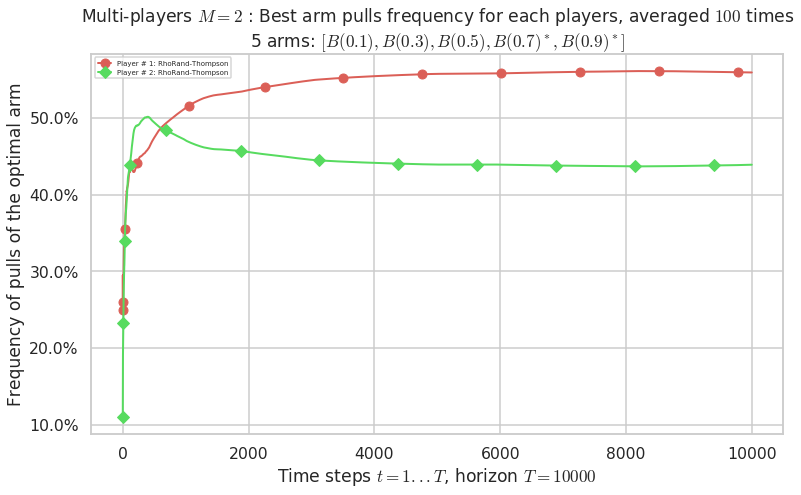
No upper bound for the non-cumulated number of collisions...
Warning: forcing to use putatright = False because there is 1 items in the legend.
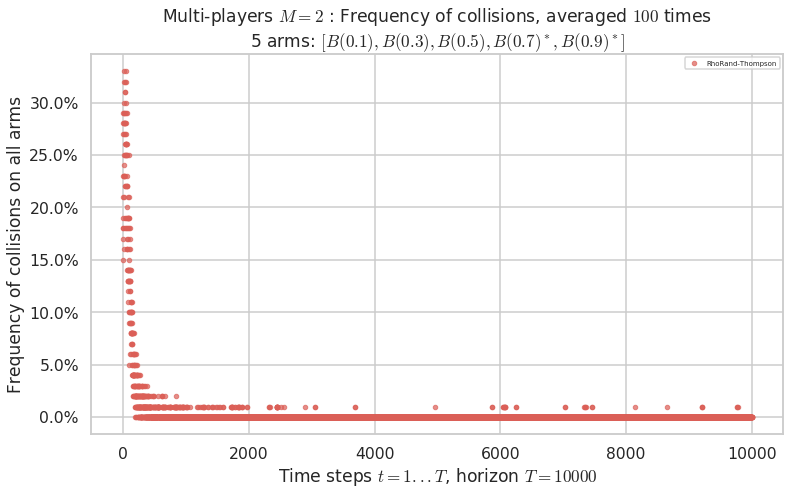
No upper bound for the non-cumulated number of collisions...
Warning: forcing to use putatright = False because there is 1 items in the legend.
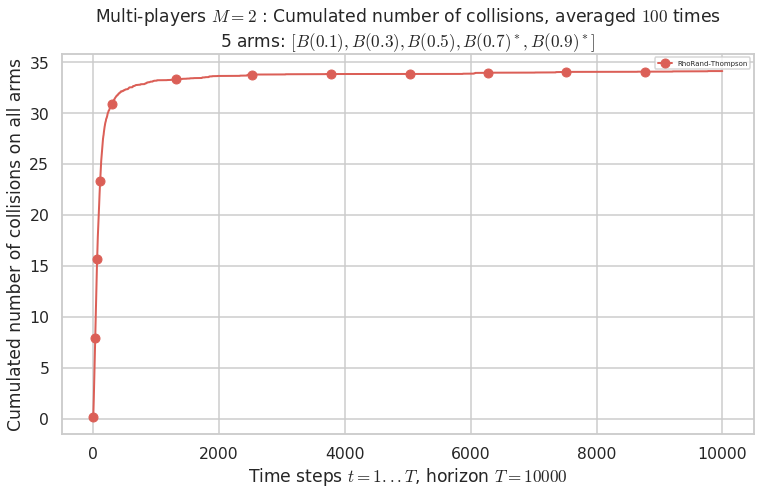
- For #$0$: $B(0.1)$ ($0.0%$$\%$), frequency of collisions is 3.3e-05 ...
- For #$1$: $B(0.3)$ ($0.0%$$\%$), frequency of collisions is 5.6e-05 ...
- For #$2$: $B(0.5)$ ($0.0%$$\%$), frequency of collisions is 0.000146 ...
- For #$3$: $B(0.7)$ ($0.1%$$\%$), frequency of collisions is 0.001405 ...
- For #$4$: $B(0.9)$ ($0.2%$$\%$), frequency of collisions is 0.001772 ...
Warning: forcing to use putatright = False because there is 4 items in the legend.
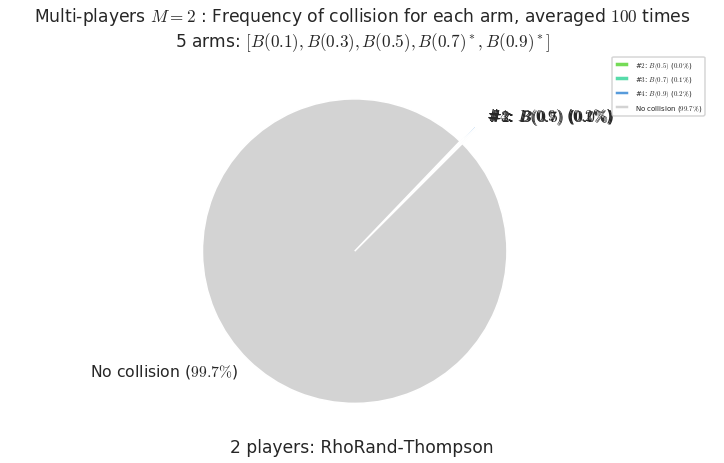
Final ranking for this environment # 1 : Selfish-Thompson ...
- Player # 2 / 2, Selfish-Thompson was ranked 1 / 2 for this simulation (last rewards = 7950.6).
- Player # 1 / 2, Selfish-Thompson was ranked 2 / 2 for this simulation (last rewards = 7912).
Warning: forcing to use putatright = False because there is 2 items in the legend.
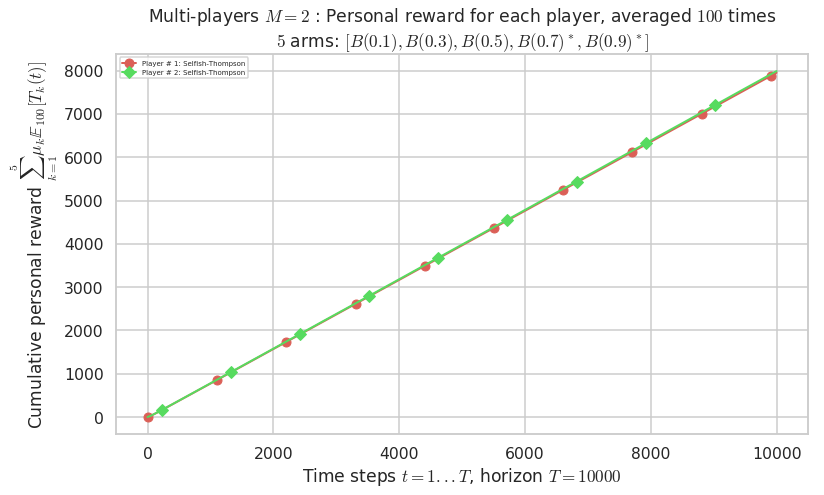
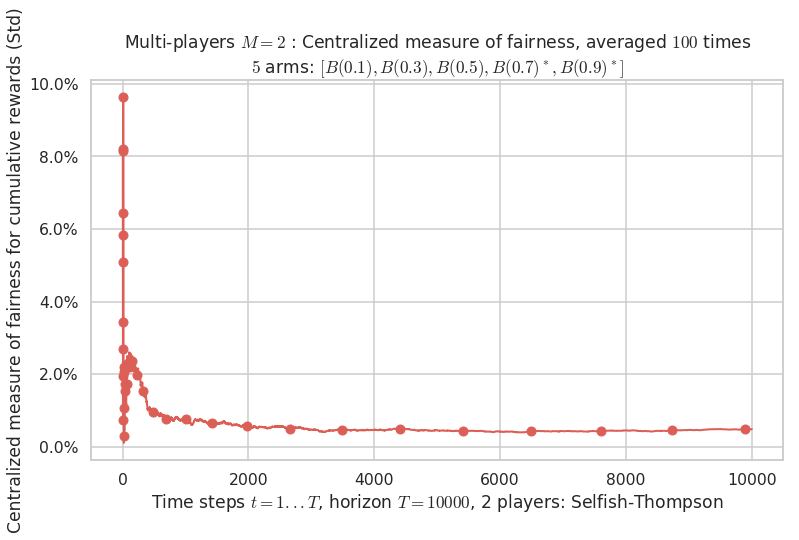
- For 2 players, Anandtharam et al. centralized lower-bound gave = 4.23 ...
- For 2 players, our lower bound gave = 8.46 ...
- For 2 players, the initial lower bound in Theorem 6 from [Anandkumar et al., 2010] gave = 5.35 ...
This MAB problem has:
- a [Lai & Robbins] complexity constant C(mu) = 3.12 for 1-player problem ...
- a Optimal Arm Identification factor H_OI(mu) = 40.00% ...
- [Anandtharam et al] centralized lower-bound = 4.23,
- [Anandkumar et al] decentralized lower-bound = 5.35
- Our better (larger) decentralized lower-bound = 8.46,
Warning: forcing to use putatright = False because there is 7 items in the legend.
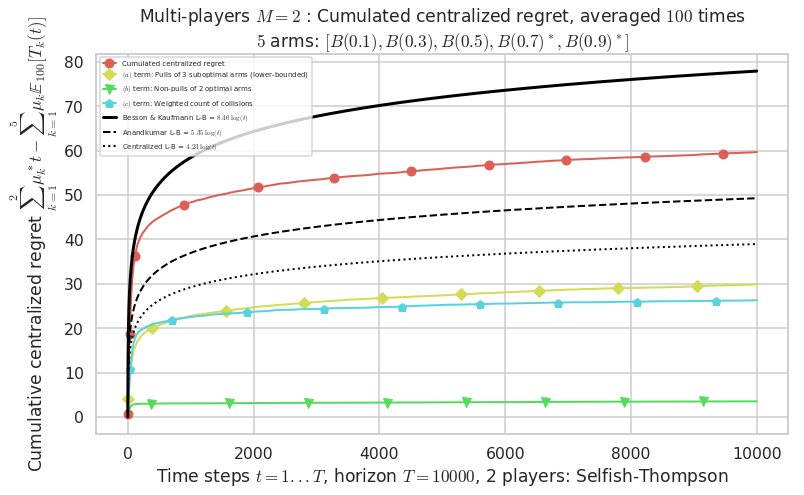
Warning: forcing to use putatright = False because there is 2 items in the legend.
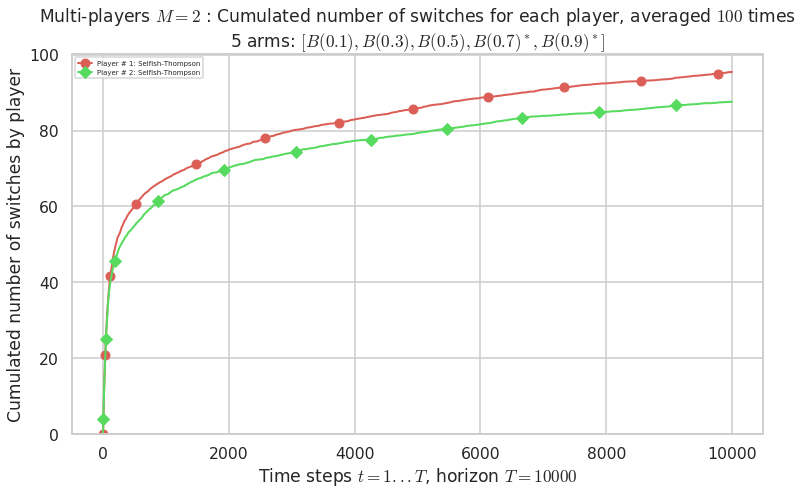
Warning: forcing to use putatright = False because there is 2 items in the legend.
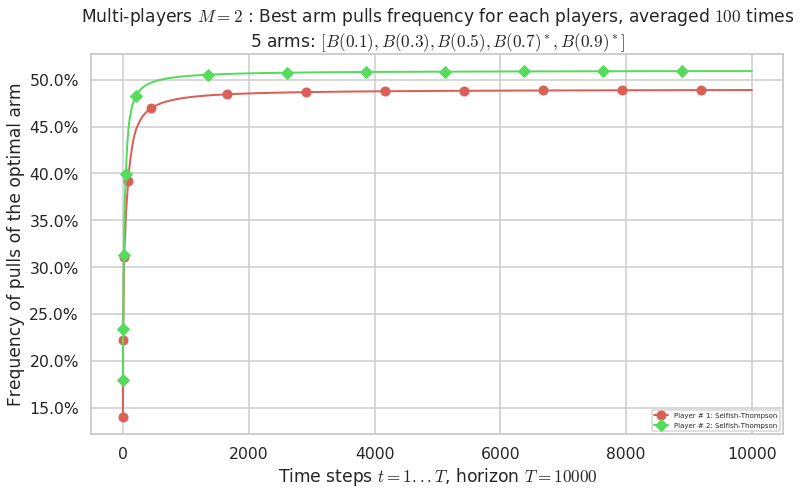
No upper bound for the non-cumulated number of collisions...
Warning: forcing to use putatright = False because there is 1 items in the legend.
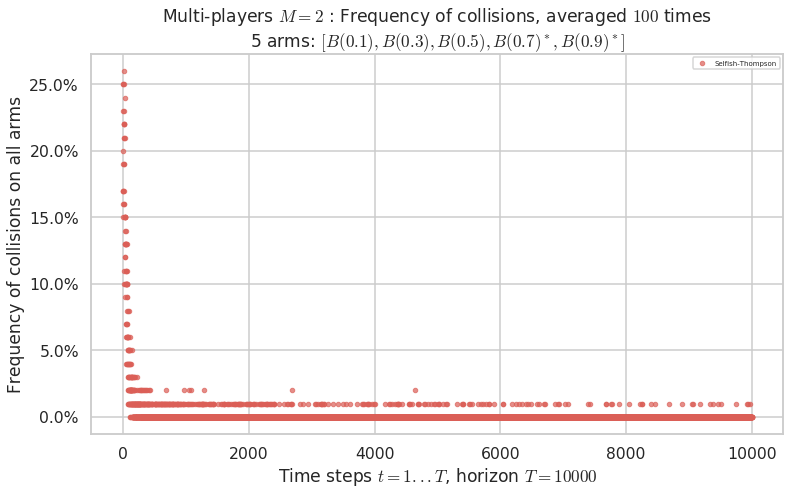
No upper bound for the non-cumulated number of collisions...
Warning: forcing to use putatright = False because there is 1 items in the legend.
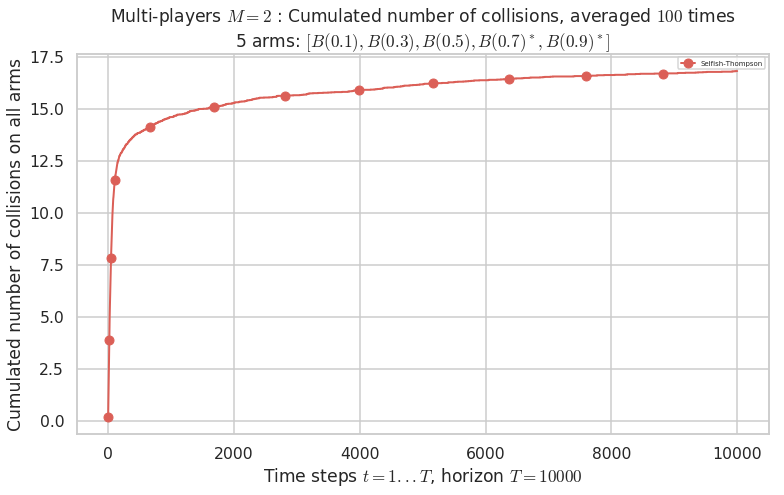
- For #$0$: $B(0.1)$ ($0.0%$$\%$), frequency of collisions is 3.3e-05 ...
- For #$1$: $B(0.3)$ ($0.0%$$\%$), frequency of collisions is 6.2e-05 ...
- For #$2$: $B(0.5)$ ($0.0%$$\%$), frequency of collisions is 0.000131 ...
- For #$3$: $B(0.7)$ ($0.0%$$\%$), frequency of collisions is 0.00041 ...
- For #$4$: $B(0.9)$ ($0.1%$$\%$), frequency of collisions is 0.001045 ...
Warning: forcing to use putatright = False because there is 4 items in the legend.
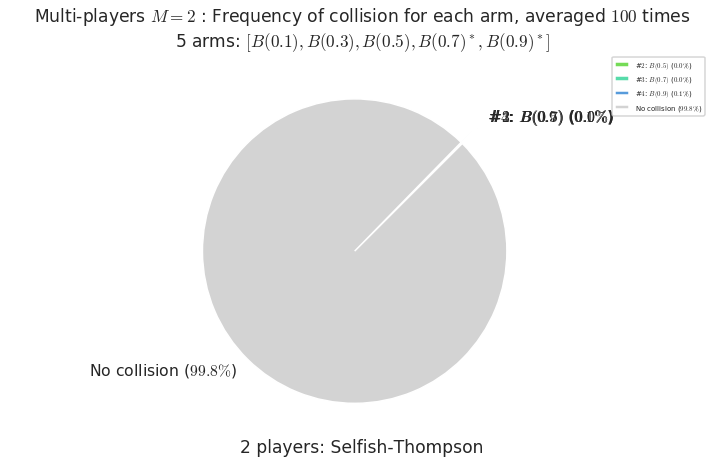
Final ranking for this environment # 1 : RhoRand-kl-UCB ...
- Player # 1 / 2, RhoRand-kl-UCB was ranked 1 / 2 for this simulation (last rewards = 7925.6).
- Player # 2 / 2, RhoRand-kl-UCB was ranked 2 / 2 for this simulation (last rewards = 7922.8).
Warning: forcing to use putatright = False because there is 2 items in the legend.
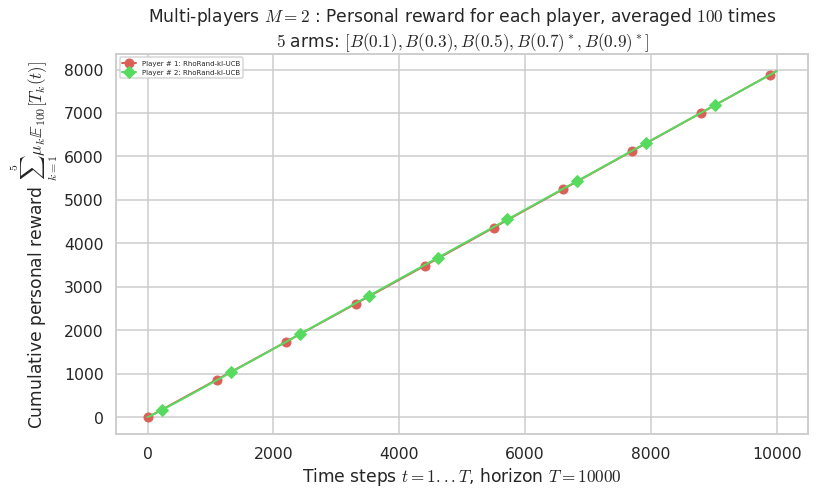

- For 2 players, Anandtharam et al. centralized lower-bound gave = 4.23 ...
- For 2 players, our lower bound gave = 8.46 ...
- For 2 players, the initial lower bound in Theorem 6 from [Anandkumar et al., 2010] gave = 5.35 ...
This MAB problem has:
- a [Lai & Robbins] complexity constant C(mu) = 3.12 for 1-player problem ...
- a Optimal Arm Identification factor H_OI(mu) = 40.00% ...
- [Anandtharam et al] centralized lower-bound = 4.23,
- [Anandkumar et al] decentralized lower-bound = 5.35
- Our better (larger) decentralized lower-bound = 8.46,
Warning: forcing to use putatright = False because there is 7 items in the legend.
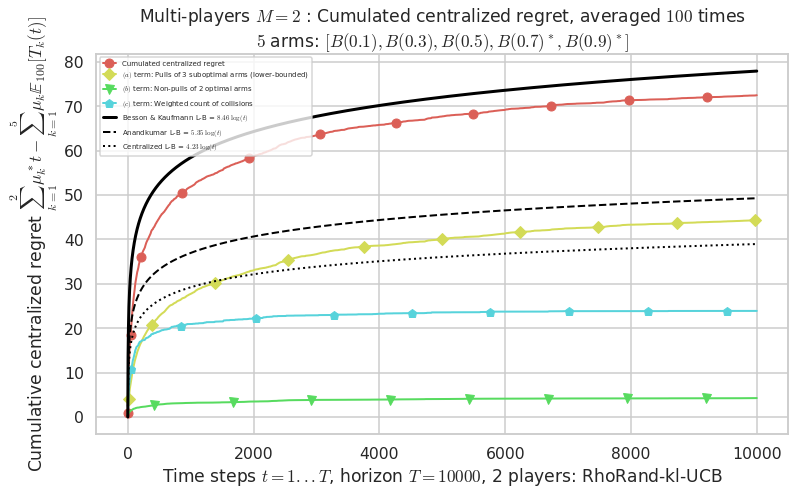
Warning: forcing to use putatright = False because there is 2 items in the legend.
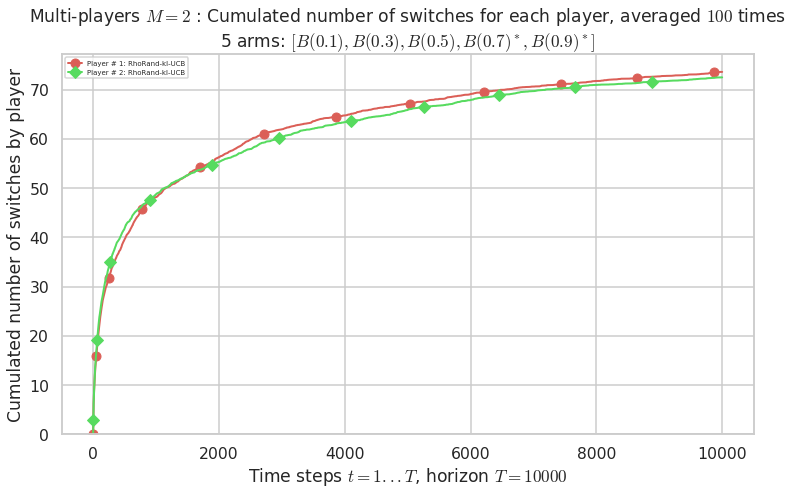
Warning: forcing to use putatright = False because there is 2 items in the legend.
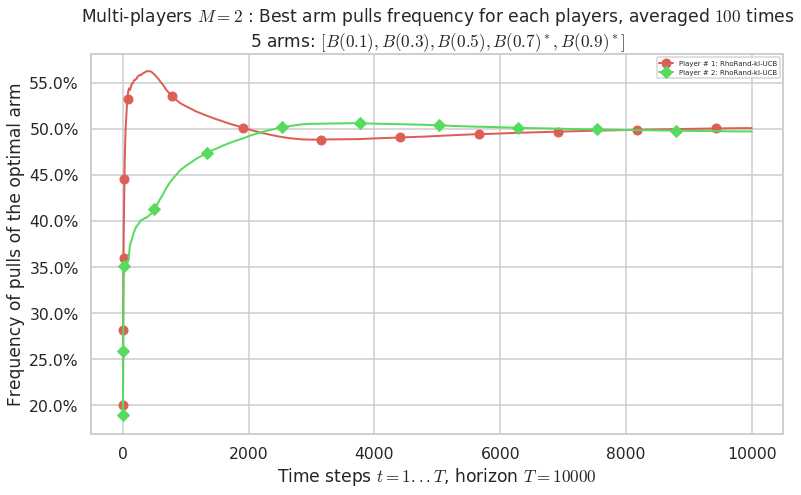
No upper bound for the non-cumulated number of collisions...
Warning: forcing to use putatright = False because there is 1 items in the legend.
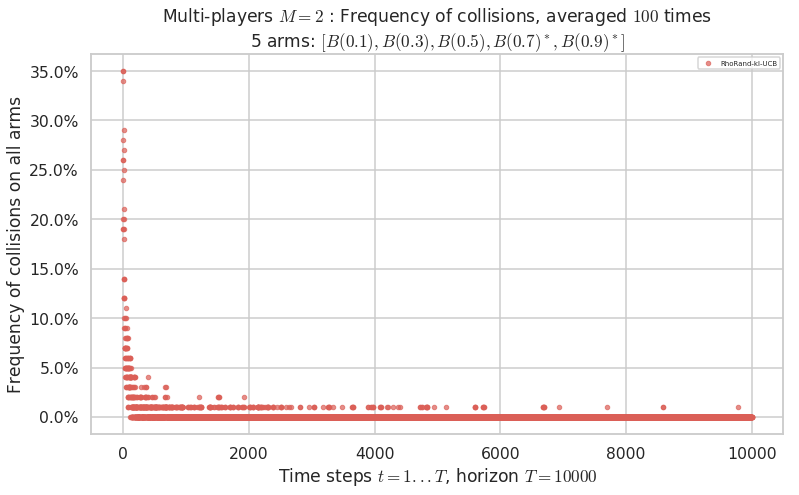
No upper bound for the non-cumulated number of collisions...
Warning: forcing to use putatright = False because there is 1 items in the legend.
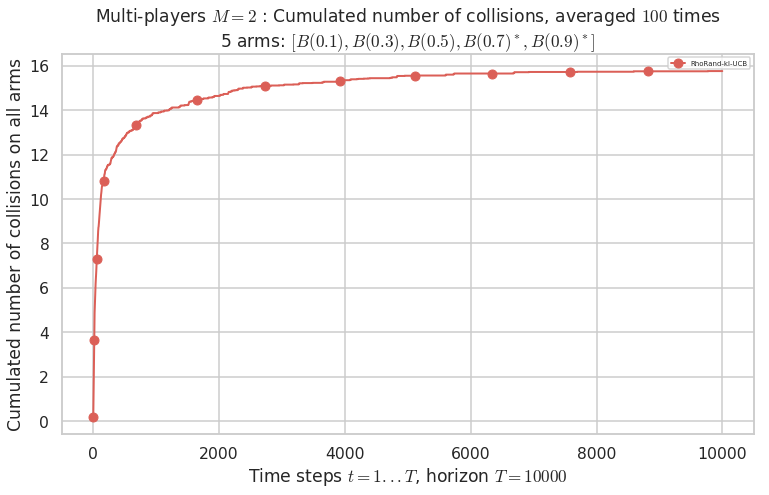
- For #$0$: $B(0.1)$ ($0.0%$$\%$), frequency of collisions is 2.4e-05 ...
- For #$1$: $B(0.3)$ ($0.0%$$\%$), frequency of collisions is 4.5e-05 ...
- For #$2$: $B(0.5)$ ($0.0%$$\%$), frequency of collisions is 0.000117 ...
- For #$3$: $B(0.7)$ ($0.1%$$\%$), frequency of collisions is 0.000653 ...
- For #$4$: $B(0.9)$ ($0.1%$$\%$), frequency of collisions is 0.000737 ...
Warning: forcing to use putatright = False because there is 4 items in the legend.
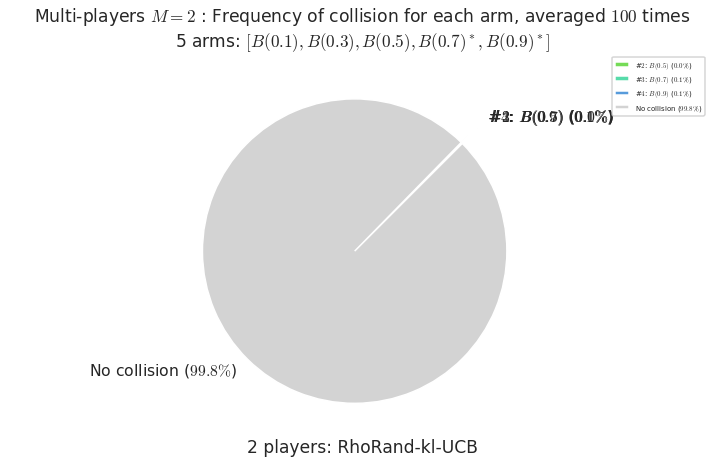
Final ranking for this environment # 1 : Selfish-kl-UCB ...
- Player # 2 / 2, Selfish-kl-UCB was ranked 1 / 2 for this simulation (last rewards = 8104.4).
- Player # 1 / 2, Selfish-kl-UCB was ranked 2 / 2 for this simulation (last rewards = 7741.5).
Warning: forcing to use putatright = False because there is 2 items in the legend.
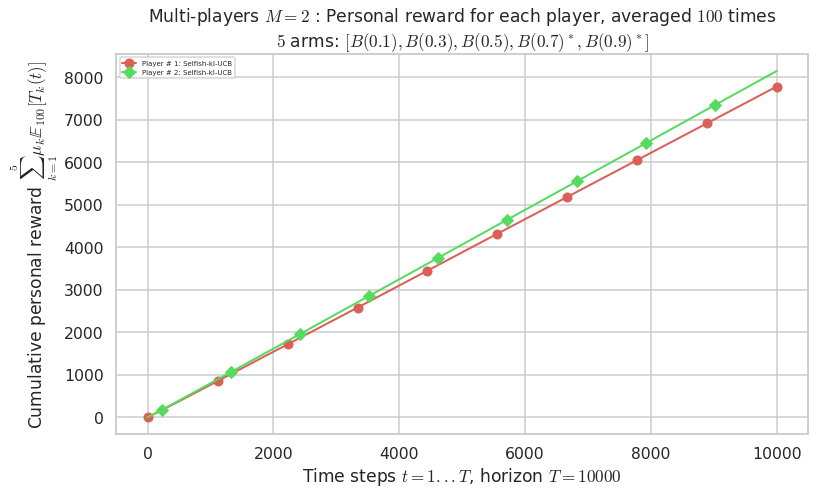
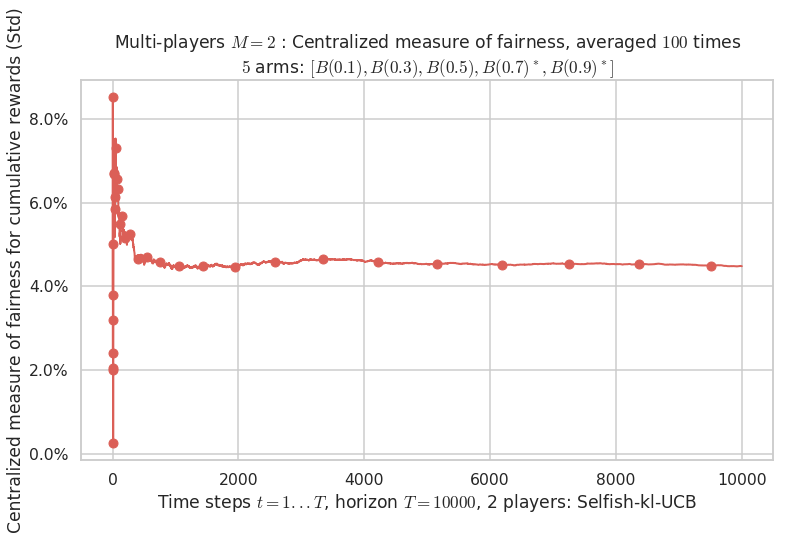
- For 2 players, Anandtharam et al. centralized lower-bound gave = 4.23 ...
- For 2 players, our lower bound gave = 8.46 ...
- For 2 players, the initial lower bound in Theorem 6 from [Anandkumar et al., 2010] gave = 5.35 ...
This MAB problem has:
- a [Lai & Robbins] complexity constant C(mu) = 3.12 for 1-player problem ...
- a Optimal Arm Identification factor H_OI(mu) = 40.00% ...
- [Anandtharam et al] centralized lower-bound = 4.23,
- [Anandkumar et al] decentralized lower-bound = 5.35
- Our better (larger) decentralized lower-bound = 8.46,
Warning: forcing to use putatright = False because there is 7 items in the legend.
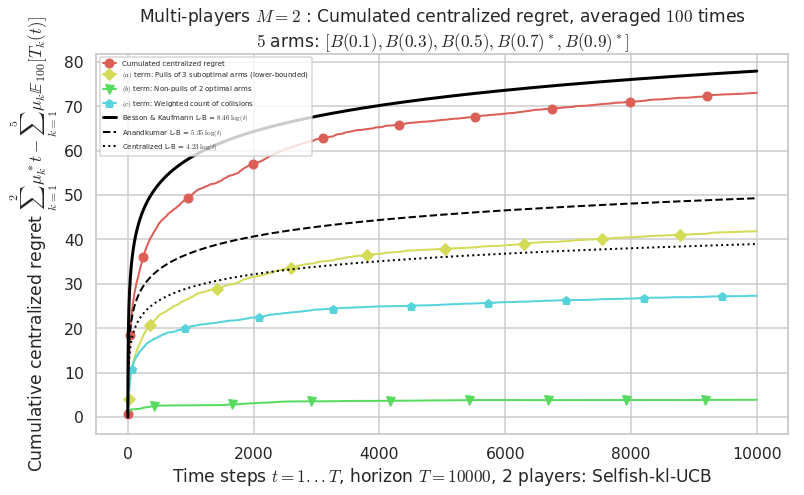
Warning: forcing to use putatright = False because there is 2 items in the legend.
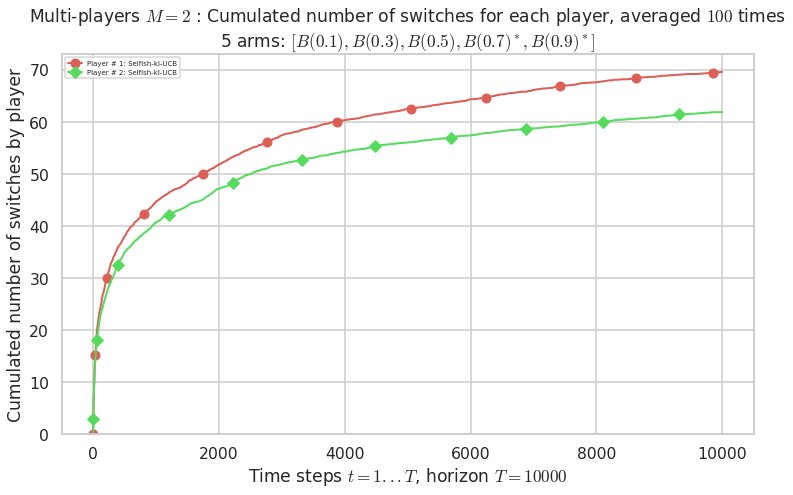
Warning: forcing to use putatright = False because there is 2 items in the legend.
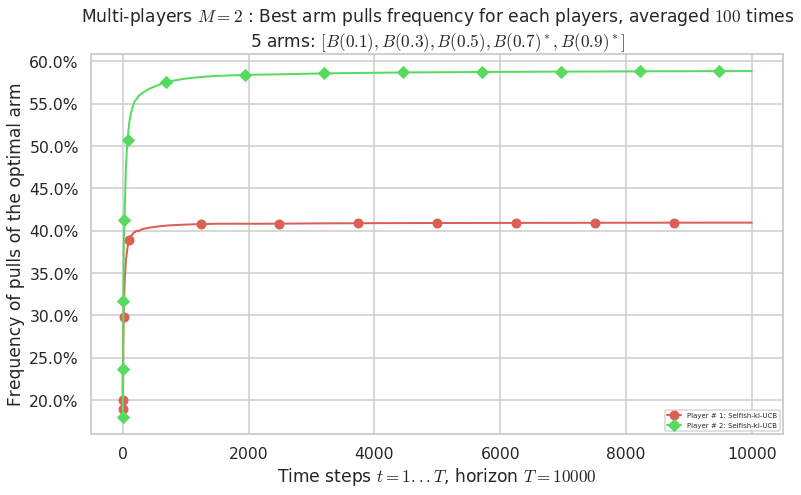
No upper bound for the non-cumulated number of collisions...
Warning: forcing to use putatright = False because there is 1 items in the legend.
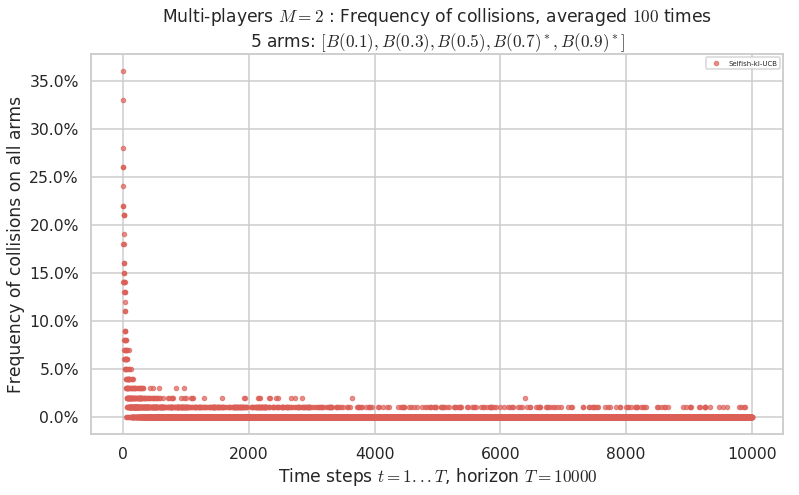
No upper bound for the non-cumulated number of collisions...
Warning: forcing to use putatright = False because there is 1 items in the legend.
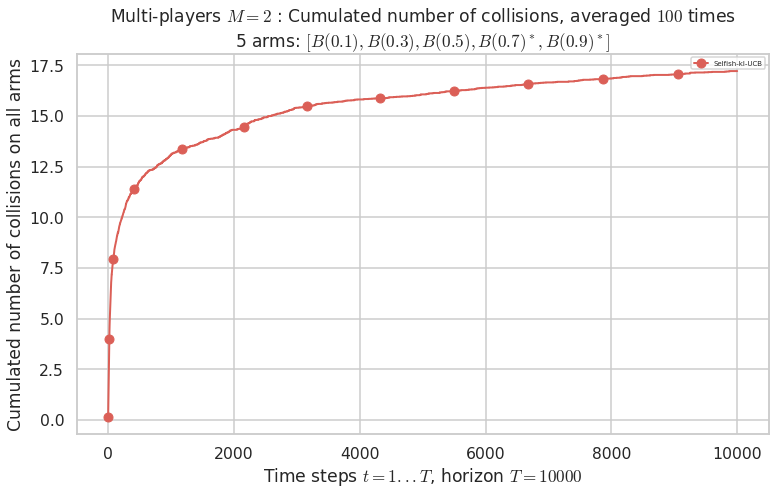
- For #$0$: $B(0.1)$ ($0.0%$$\%$), frequency of collisions is 3.2e-05 ...
- For #$1$: $B(0.3)$ ($0.0%$$\%$), frequency of collisions is 4.5e-05 ...
- For #$2$: $B(0.5)$ ($0.0%$$\%$), frequency of collisions is 0.00012 ...
- For #$3$: $B(0.7)$ ($0.0%$$\%$), frequency of collisions is 0.000419 ...
- For #$4$: $B(0.9)$ ($0.1%$$\%$), frequency of collisions is 0.001105 ...
Warning: forcing to use putatright = False because there is 4 items in the legend.
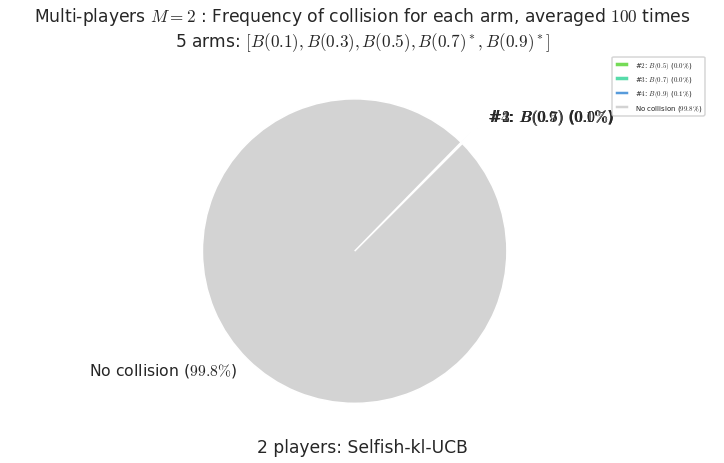
Third problem¶
\(\mu = [0.005, 0.01, 0.015, 0.84, 0.85]\) is an harder Bernoulli problem, as there is a huge gap between suboptimal and optimal arms.
[32]:
for playersId in tqdm(range(len(evs)), desc="Policies"):
evaluation = evaluators[2][playersId]
plotAll(evaluation, 2)
Final ranking for this environment # 2 : RhoRand-UCB($\alpha=1$) ...
- Player # 2 / 2, RhoRand-UCB($\alpha=1$) was ranked 1 / 2 for this simulation (last rewards = 8385.3).
- Player # 1 / 2, RhoRand-UCB($\alpha=1$) was ranked 2 / 2 for this simulation (last rewards = 8375.3).
Warning: forcing to use putatright = False because there is 2 items in the legend.
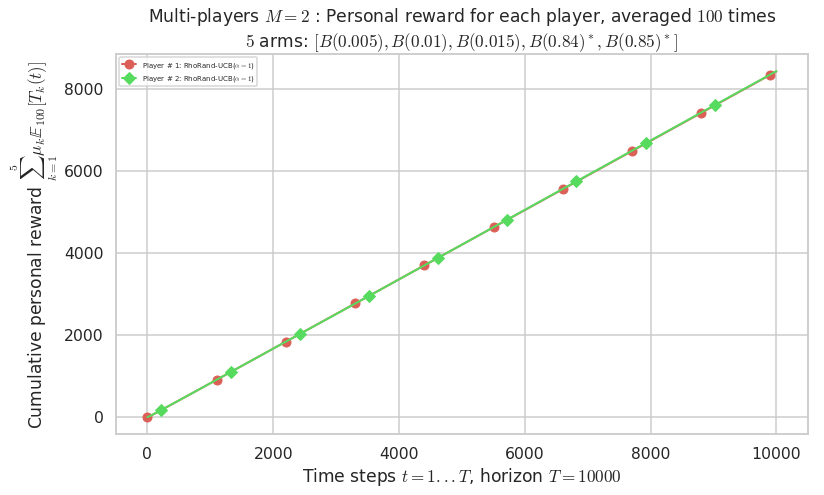
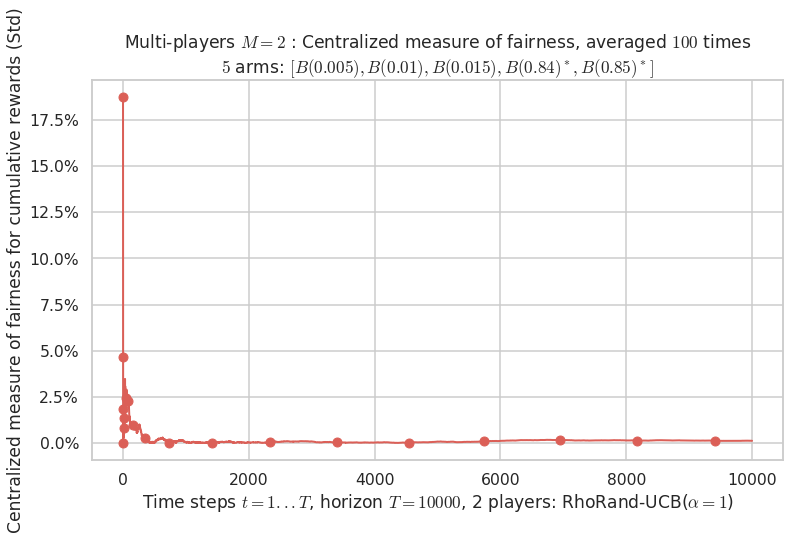
- For 2 players, Anandtharam et al. centralized lower-bound gave = 1.41 ...
- For 2 players, our lower bound gave = 2.83 ...
- For 2 players, the initial lower bound in Theorem 6 from [Anandkumar et al., 2010] gave = 2.78 ...
This MAB problem has:
- a [Lai & Robbins] complexity constant C(mu) = 27.3 for 1-player problem ...
- a Optimal Arm Identification factor H_OI(mu) = 29.40% ...
- [Anandtharam et al] centralized lower-bound = 1.41,
- [Anandkumar et al] decentralized lower-bound = 2.78
- Our better (larger) decentralized lower-bound = 2.83,
Warning: forcing to use putatright = False because there is 7 items in the legend.
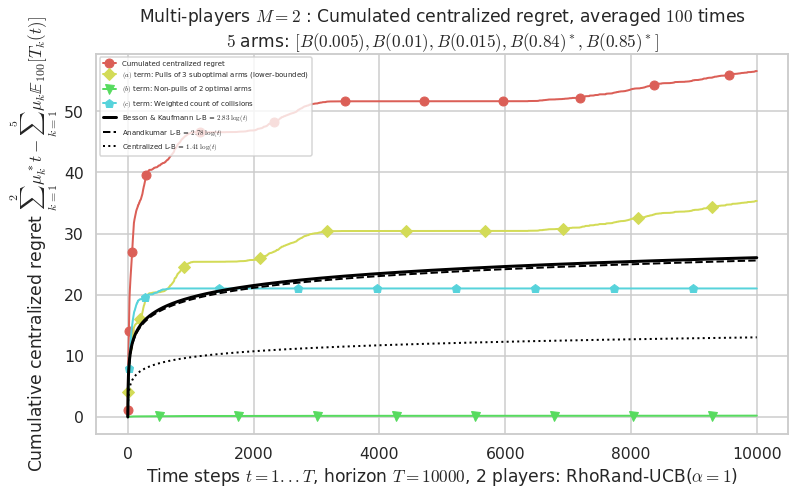
Warning: forcing to use putatright = False because there is 2 items in the legend.
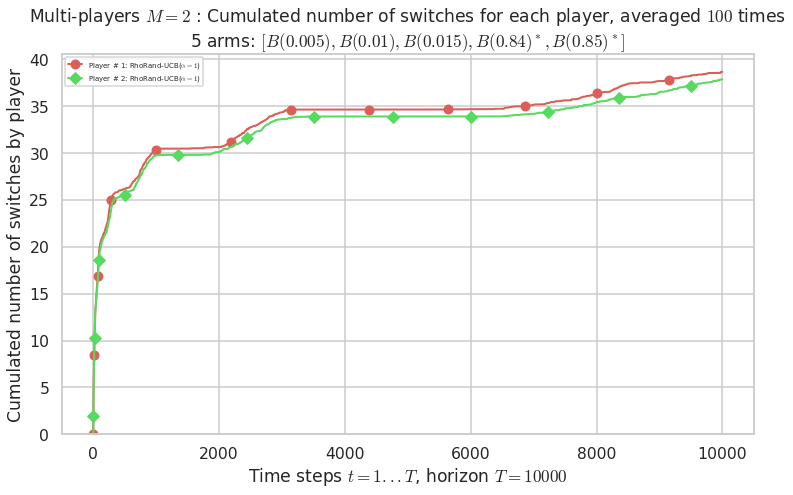
Warning: forcing to use putatright = False because there is 2 items in the legend.
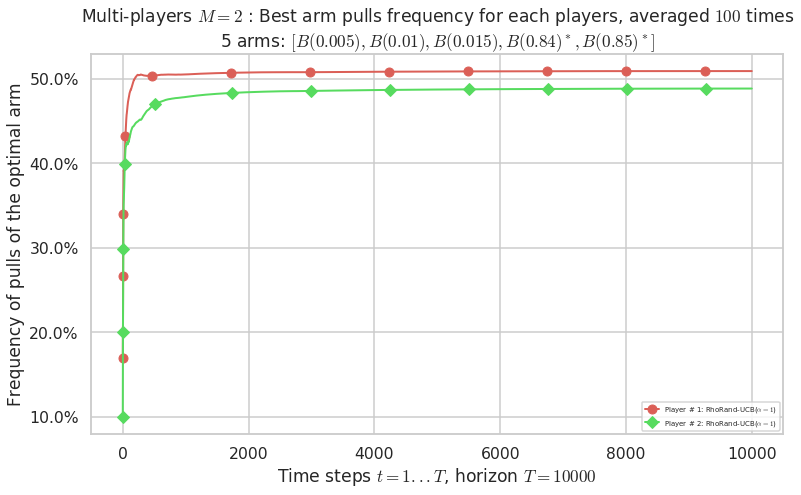
No upper bound for the non-cumulated number of collisions...
Warning: forcing to use putatright = False because there is 1 items in the legend.
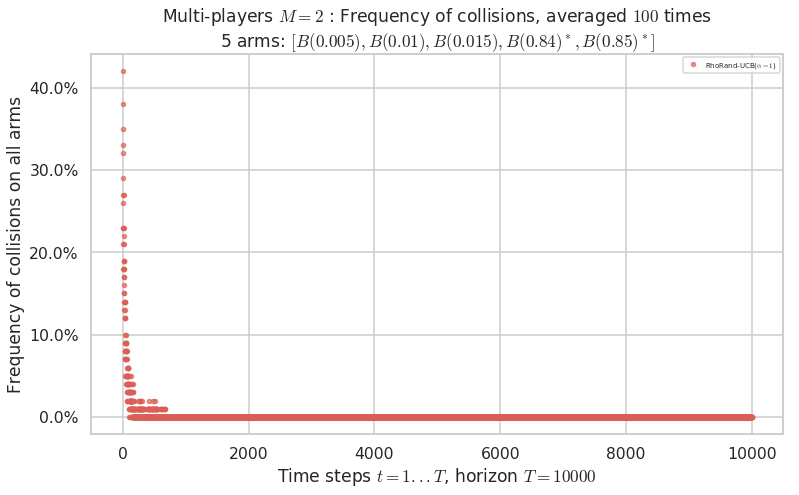
No upper bound for the non-cumulated number of collisions...
Warning: forcing to use putatright = False because there is 1 items in the legend.
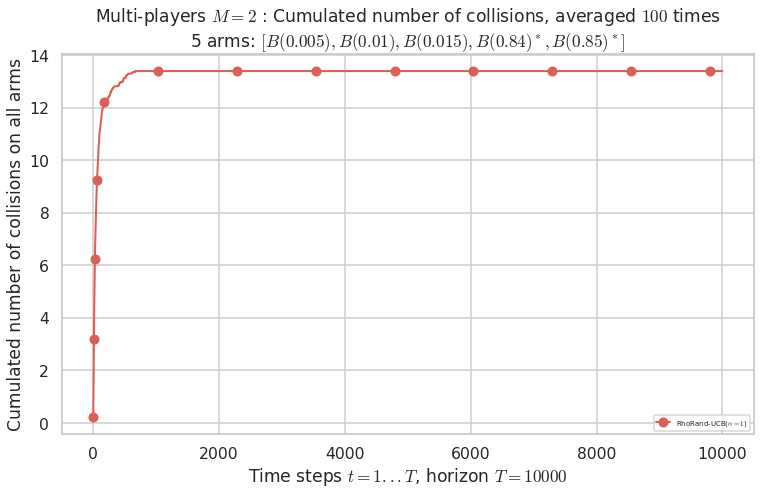
- For #$0$: $B(0.005)$ ($0.0%$$\%$), frequency of collisions is 2.8e-05 ...
- For #$1$: $B(0.01)$ ($0.0%$$\%$), frequency of collisions is 3.2e-05 ...
- For #$2$: $B(0.015)$ ($0.0%$$\%$), frequency of collisions is 3.6e-05 ...
- For #$3$: $B(0.84)$ ($0.1%$$\%$), frequency of collisions is 0.000661 ...
- For #$4$: $B(0.85)$ ($0.1%$$\%$), frequency of collisions is 0.000582 ...
Warning: forcing to use putatright = False because there is 3 items in the legend.
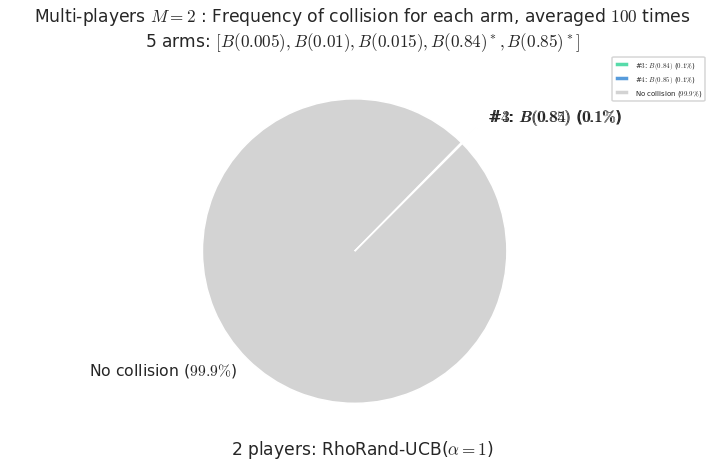
Final ranking for this environment # 2 : Selfish-UCB($\alpha=1$) ...
- Player # 2 / 2, Selfish-UCB($\alpha=1$) was ranked 1 / 2 for this simulation (last rewards = 8373.4).
- Player # 1 / 2, Selfish-UCB($\alpha=1$) was ranked 2 / 2 for this simulation (last rewards = 8372.2).
Warning: forcing to use putatright = False because there is 2 items in the legend.
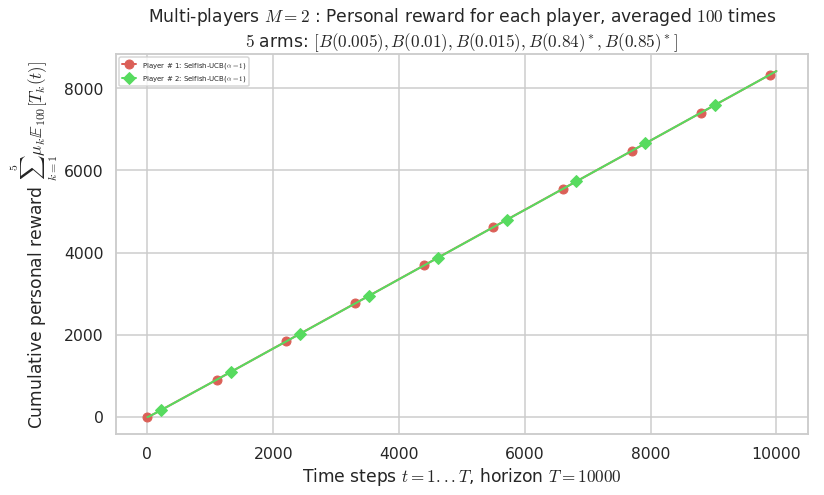
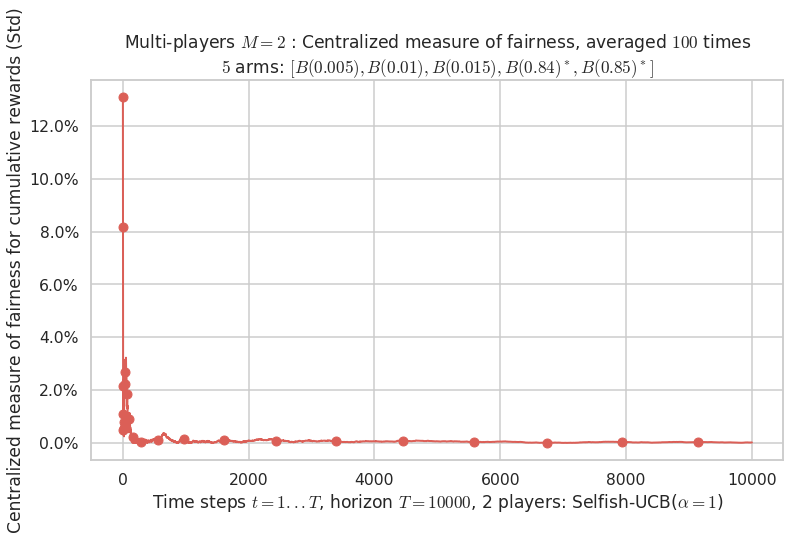
- For 2 players, Anandtharam et al. centralized lower-bound gave = 1.41 ...
- For 2 players, our lower bound gave = 2.83 ...
- For 2 players, the initial lower bound in Theorem 6 from [Anandkumar et al., 2010] gave = 2.78 ...
This MAB problem has:
- a [Lai & Robbins] complexity constant C(mu) = 27.3 for 1-player problem ...
- a Optimal Arm Identification factor H_OI(mu) = 29.40% ...
- [Anandtharam et al] centralized lower-bound = 1.41,
- [Anandkumar et al] decentralized lower-bound = 2.78
- Our better (larger) decentralized lower-bound = 2.83,
Warning: forcing to use putatright = False because there is 7 items in the legend.
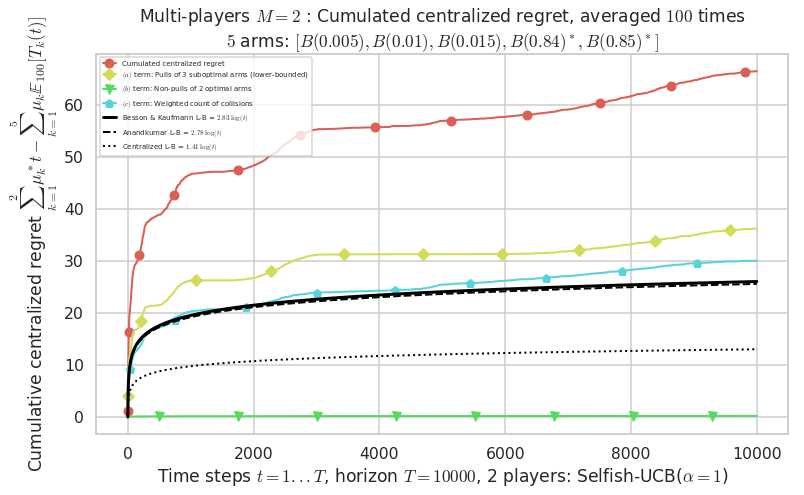
Warning: forcing to use putatright = False because there is 2 items in the legend.
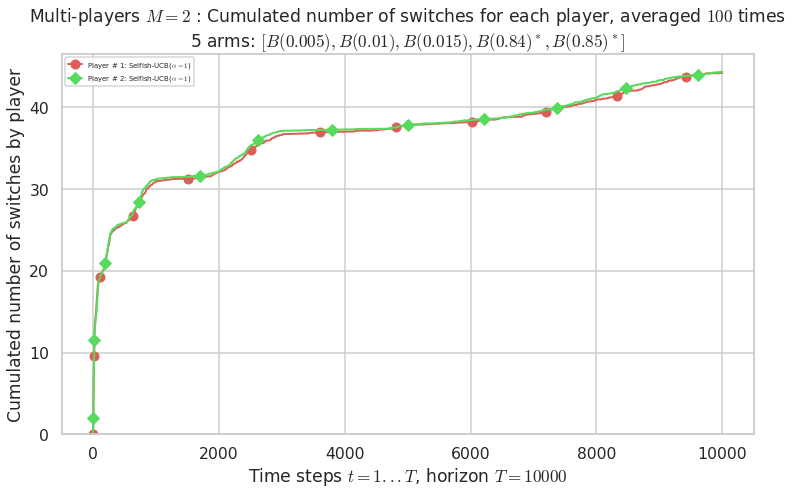
Warning: forcing to use putatright = False because there is 2 items in the legend.
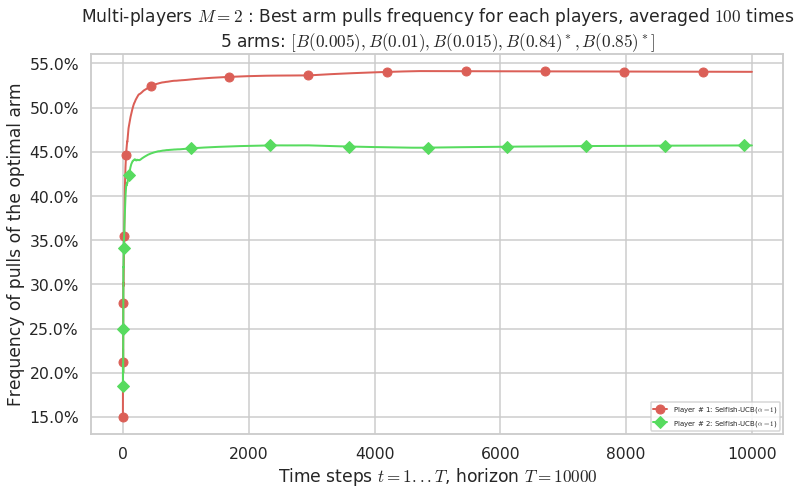
No upper bound for the non-cumulated number of collisions...
Warning: forcing to use putatright = False because there is 1 items in the legend.
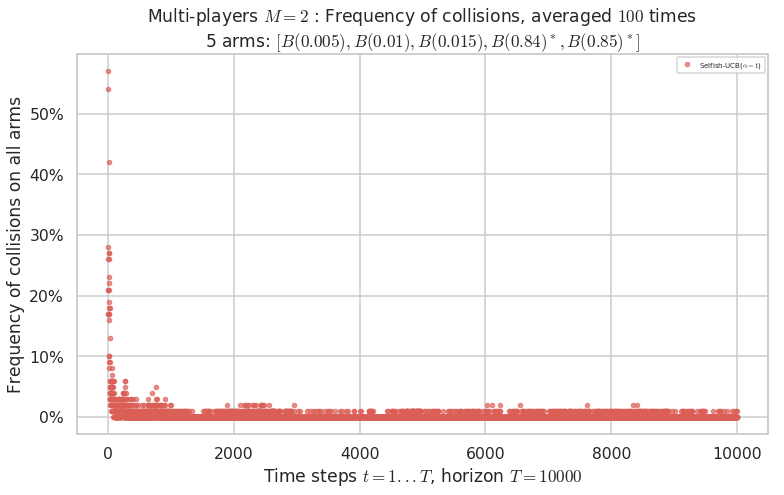
No upper bound for the non-cumulated number of collisions...
Warning: forcing to use putatright = False because there is 1 items in the legend.
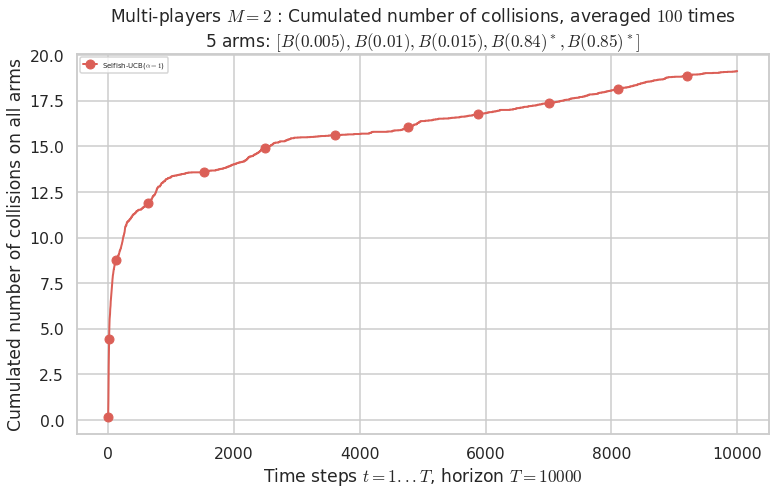
- For #$0$: $B(0.005)$ ($0.0%$$\%$), frequency of collisions is 4.7e-05 ...
- For #$1$: $B(0.01)$ ($0.0%$$\%$), frequency of collisions is 4.3e-05 ...
- For #$2$: $B(0.015)$ ($0.0%$$\%$), frequency of collisions is 4.4e-05 ...
- For #$3$: $B(0.84)$ ($0.1%$$\%$), frequency of collisions is 0.000891 ...
- For #$4$: $B(0.85)$ ($0.1%$$\%$), frequency of collisions is 0.000888 ...
Warning: forcing to use putatright = False because there is 3 items in the legend.
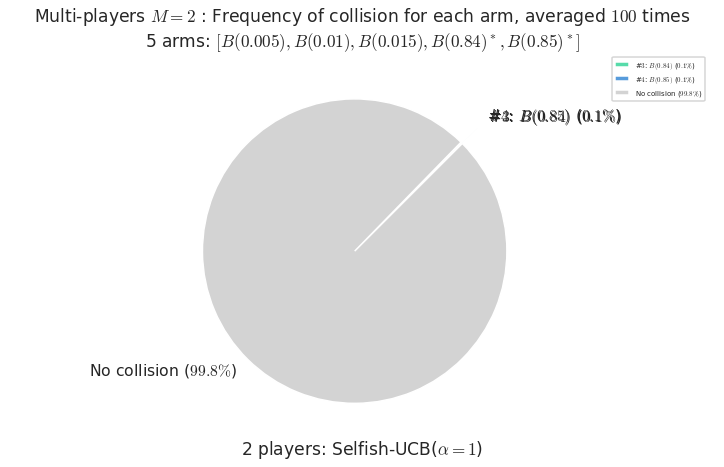
Final ranking for this environment # 2 : RhoRand-Thompson ...
- Player # 1 / 2, RhoRand-Thompson was ranked 1 / 2 for this simulation (last rewards = 5107.2).
- Player # 2 / 2, RhoRand-Thompson was ranked 2 / 2 for this simulation (last rewards = 5105.4).
Warning: forcing to use putatright = False because there is 2 items in the legend.
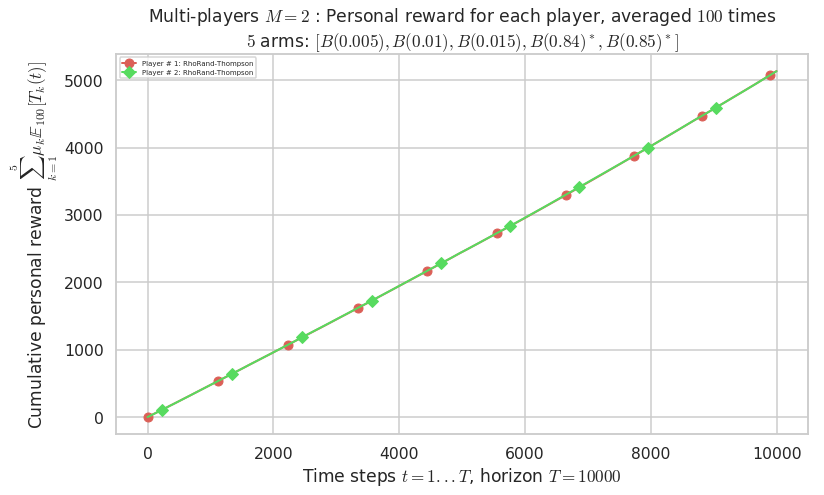
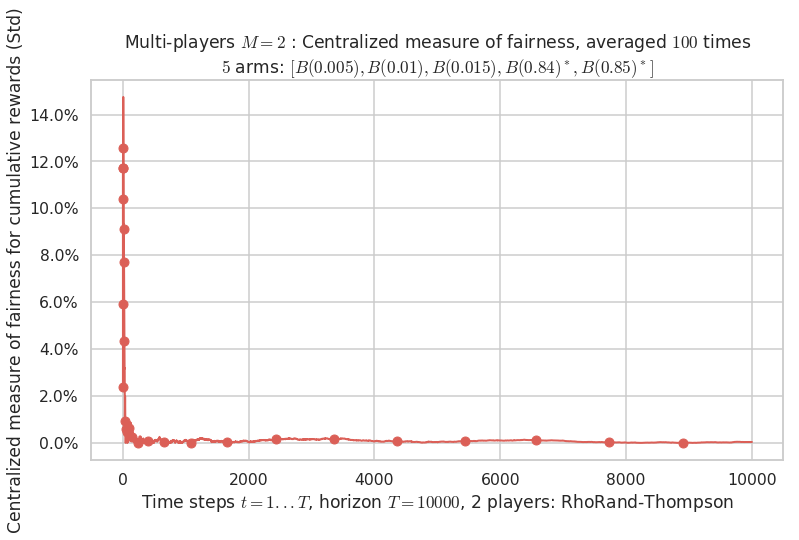
- For 2 players, Anandtharam et al. centralized lower-bound gave = 1.41 ...
- For 2 players, our lower bound gave = 2.83 ...
- For 2 players, the initial lower bound in Theorem 6 from [Anandkumar et al., 2010] gave = 2.78 ...
This MAB problem has:
- a [Lai & Robbins] complexity constant C(mu) = 27.3 for 1-player problem ...
- a Optimal Arm Identification factor H_OI(mu) = 29.40% ...
- [Anandtharam et al] centralized lower-bound = 1.41,
- [Anandkumar et al] decentralized lower-bound = 2.78
- Our better (larger) decentralized lower-bound = 2.83,
Warning: forcing to use putatright = False because there is 7 items in the legend.
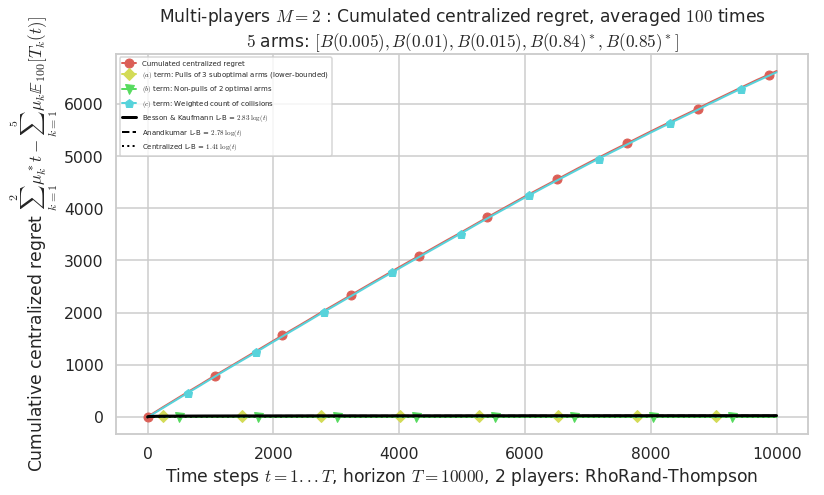
Warning: forcing to use putatright = False because there is 2 items in the legend.
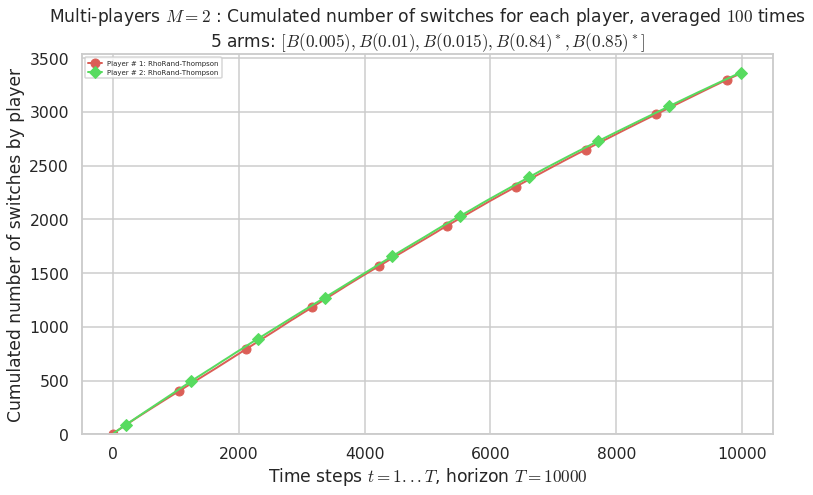
Warning: forcing to use putatright = False because there is 2 items in the legend.

No upper bound for the non-cumulated number of collisions...
Warning: forcing to use putatright = False because there is 1 items in the legend.
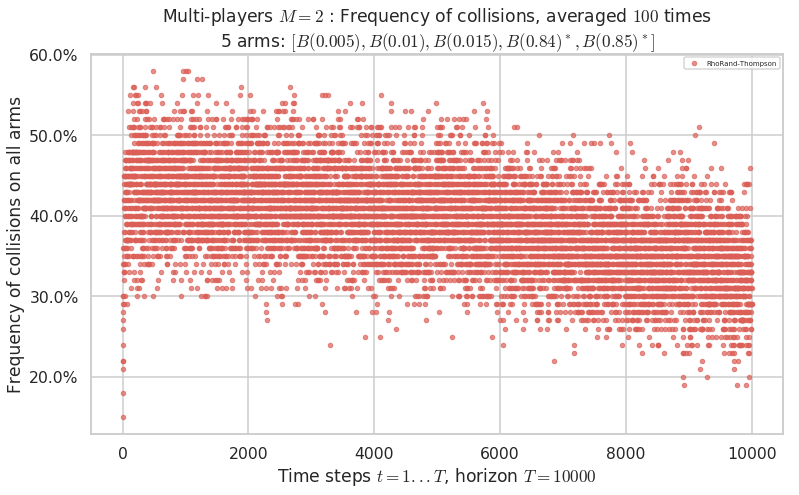
No upper bound for the non-cumulated number of collisions...
Warning: forcing to use putatright = False because there is 1 items in the legend.

- For #$0$: $B(0.005)$ ($0.0%$$\%$), frequency of collisions is 2.9e-05 ...
- For #$1$: $B(0.01)$ ($0.0%$$\%$), frequency of collisions is 2.9e-05 ...
- For #$2$: $B(0.015)$ ($0.0%$$\%$), frequency of collisions is 2.4e-05 ...
- For #$3$: $B(0.84)$ ($19.5%$$\%$), frequency of collisions is 0.19493 ...
- For #$4$: $B(0.85)$ ($19.6%$$\%$), frequency of collisions is 0.19604 ...
Warning: forcing to use putatright = False because there is 3 items in the legend.

Final ranking for this environment # 2 : Selfish-Thompson ...
- Player # 2 / 2, Selfish-Thompson was ranked 1 / 2 for this simulation (last rewards = 8388).
- Player # 1 / 2, Selfish-Thompson was ranked 2 / 2 for this simulation (last rewards = 8386.4).
Warning: forcing to use putatright = False because there is 2 items in the legend.
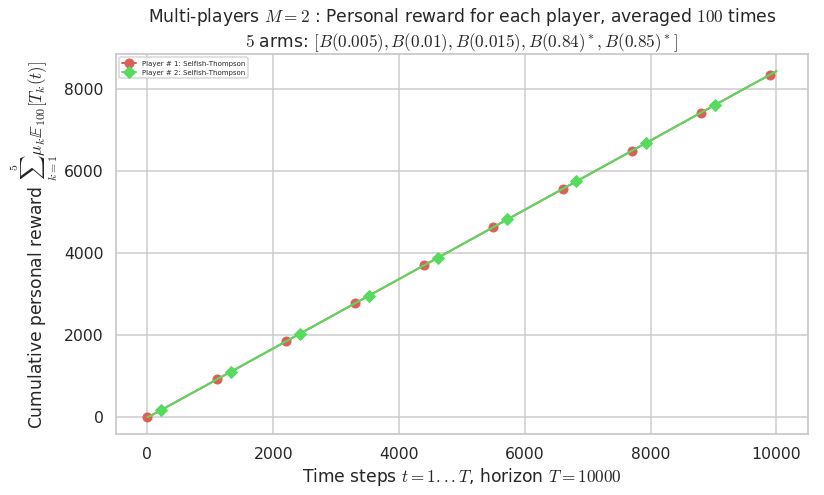
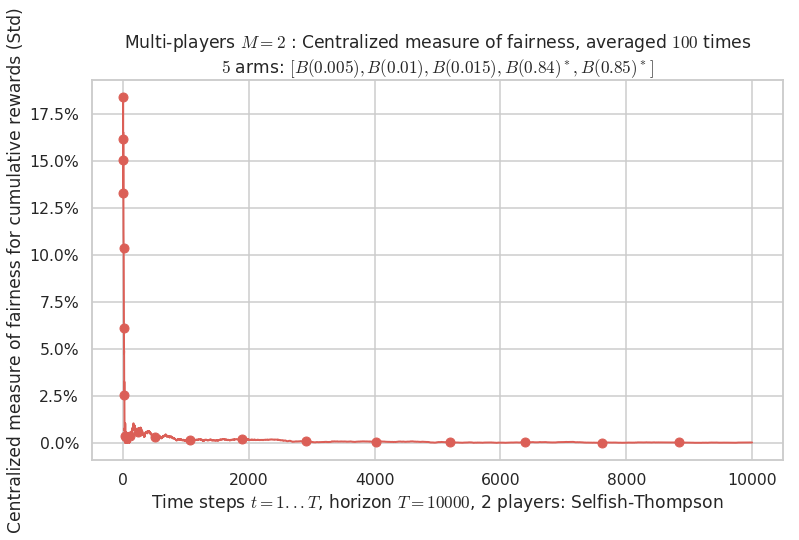
- For 2 players, Anandtharam et al. centralized lower-bound gave = 1.41 ...
- For 2 players, our lower bound gave = 2.83 ...
- For 2 players, the initial lower bound in Theorem 6 from [Anandkumar et al., 2010] gave = 2.78 ...
This MAB problem has:
- a [Lai & Robbins] complexity constant C(mu) = 27.3 for 1-player problem ...
- a Optimal Arm Identification factor H_OI(mu) = 29.40% ...
- [Anandtharam et al] centralized lower-bound = 1.41,
- [Anandkumar et al] decentralized lower-bound = 2.78
- Our better (larger) decentralized lower-bound = 2.83,
Warning: forcing to use putatright = False because there is 7 items in the legend.
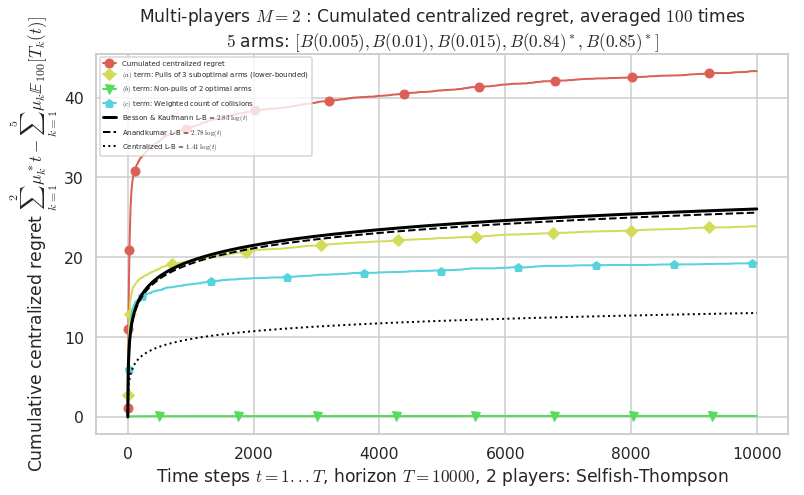
Warning: forcing to use putatright = False because there is 2 items in the legend.
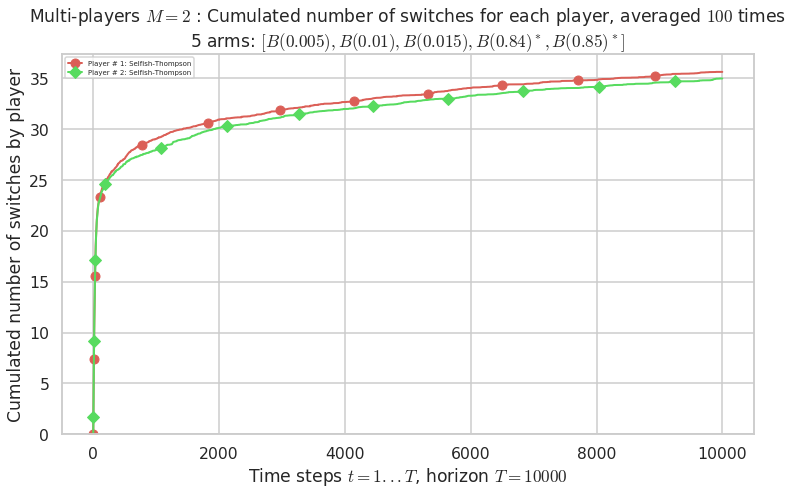
Warning: forcing to use putatright = False because there is 2 items in the legend.
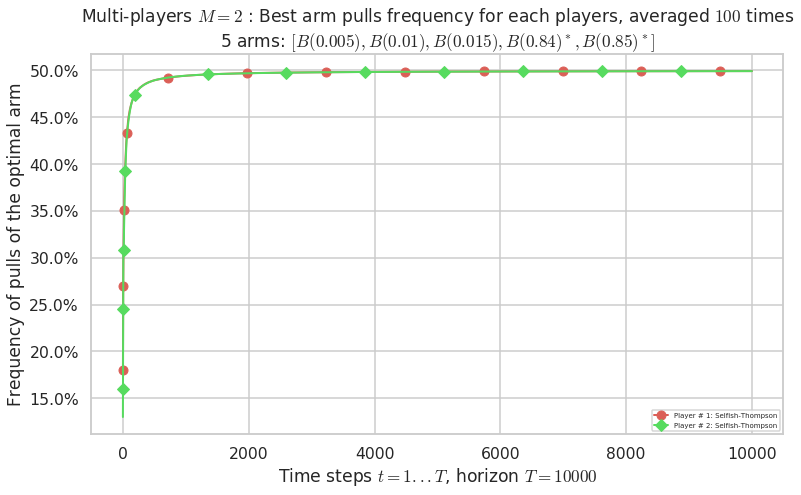
No upper bound for the non-cumulated number of collisions...
Warning: forcing to use putatright = False because there is 1 items in the legend.
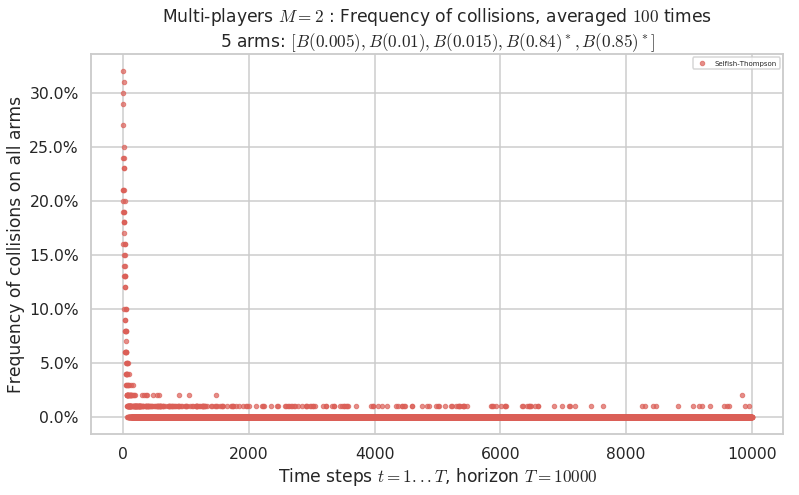
No upper bound for the non-cumulated number of collisions...
Warning: forcing to use putatright = False because there is 1 items in the legend.
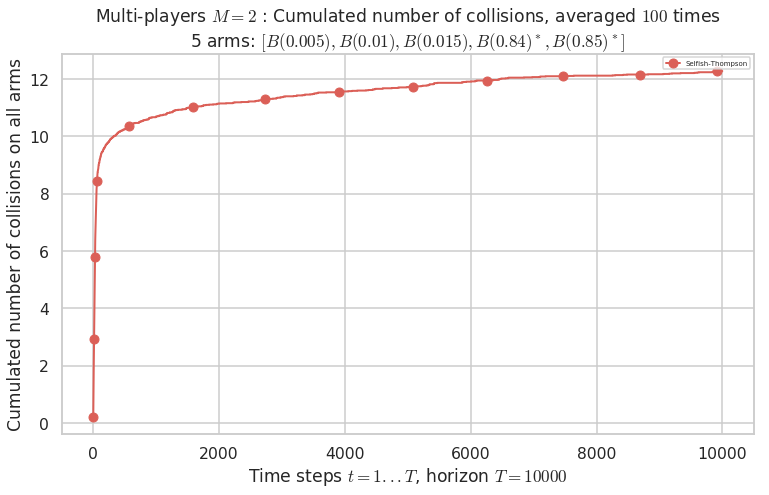
- For #$0$: $B(0.005)$ ($0.0%$$\%$), frequency of collisions is 2.8e-05 ...
- For #$1$: $B(0.01)$ ($0.0%$$\%$), frequency of collisions is 2.2e-05 ...
- For #$2$: $B(0.015)$ ($0.0%$$\%$), frequency of collisions is 3.7e-05 ...
- For #$3$: $B(0.84)$ ($0.1%$$\%$), frequency of collisions is 0.000555 ...
- For #$4$: $B(0.85)$ ($0.1%$$\%$), frequency of collisions is 0.000586 ...
Warning: forcing to use putatright = False because there is 3 items in the legend.

Final ranking for this environment # 2 : RhoRand-kl-UCB ...
- Player # 2 / 2, RhoRand-kl-UCB was ranked 1 / 2 for this simulation (last rewards = 8380.2).
- Player # 1 / 2, RhoRand-kl-UCB was ranked 2 / 2 for this simulation (last rewards = 8378).
Warning: forcing to use putatright = False because there is 2 items in the legend.
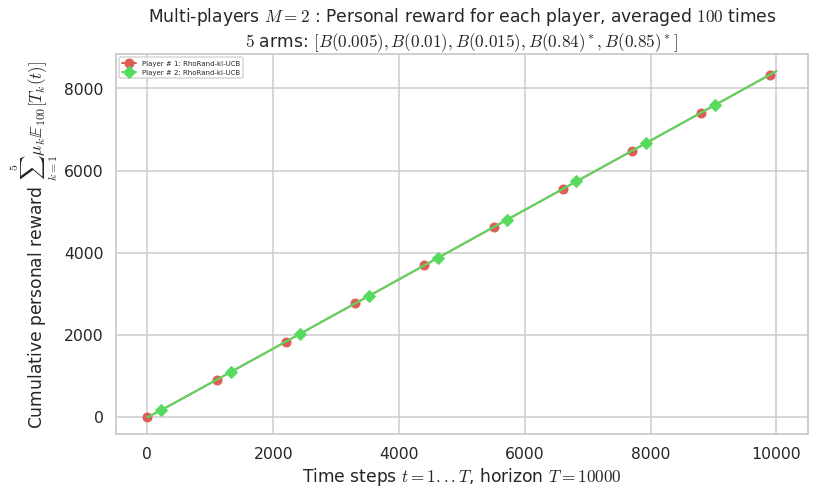
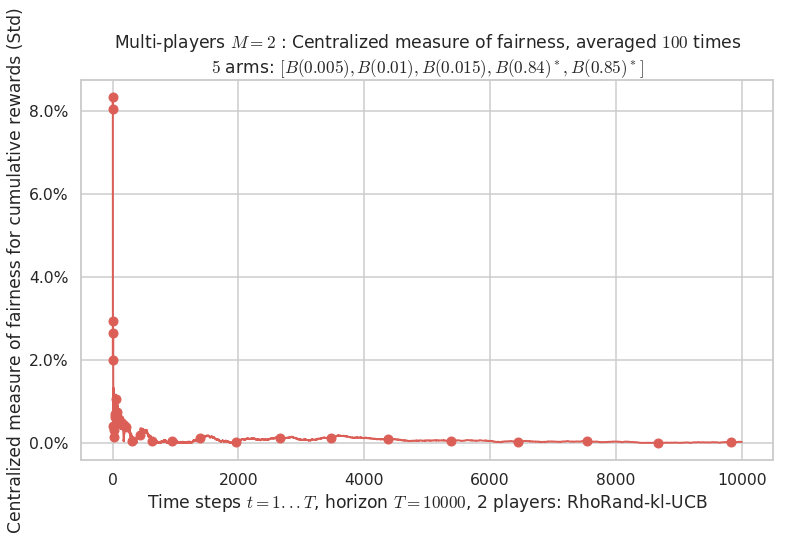
- For 2 players, Anandtharam et al. centralized lower-bound gave = 1.41 ...
- For 2 players, our lower bound gave = 2.83 ...
- For 2 players, the initial lower bound in Theorem 6 from [Anandkumar et al., 2010] gave = 2.78 ...
This MAB problem has:
- a [Lai & Robbins] complexity constant C(mu) = 27.3 for 1-player problem ...
- a Optimal Arm Identification factor H_OI(mu) = 29.40% ...
- [Anandtharam et al] centralized lower-bound = 1.41,
- [Anandkumar et al] decentralized lower-bound = 2.78
- Our better (larger) decentralized lower-bound = 2.83,
Warning: forcing to use putatright = False because there is 7 items in the legend.
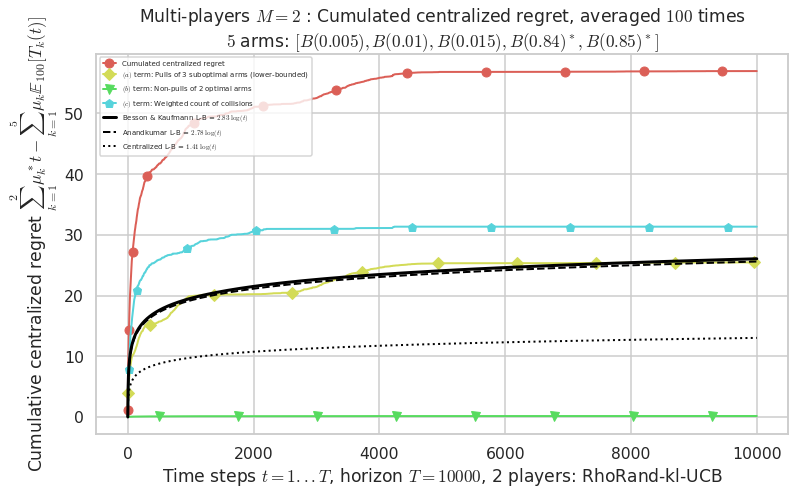
Warning: forcing to use putatright = False because there is 2 items in the legend.
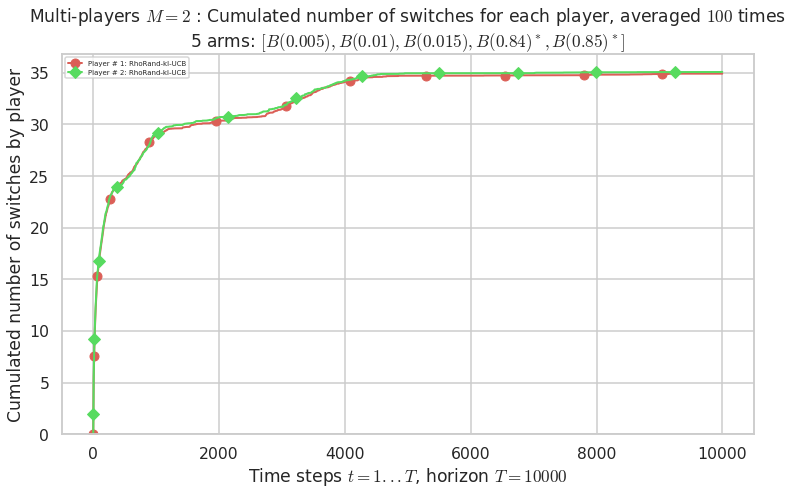
Warning: forcing to use putatright = False because there is 2 items in the legend.

No upper bound for the non-cumulated number of collisions...
Warning: forcing to use putatright = False because there is 1 items in the legend.
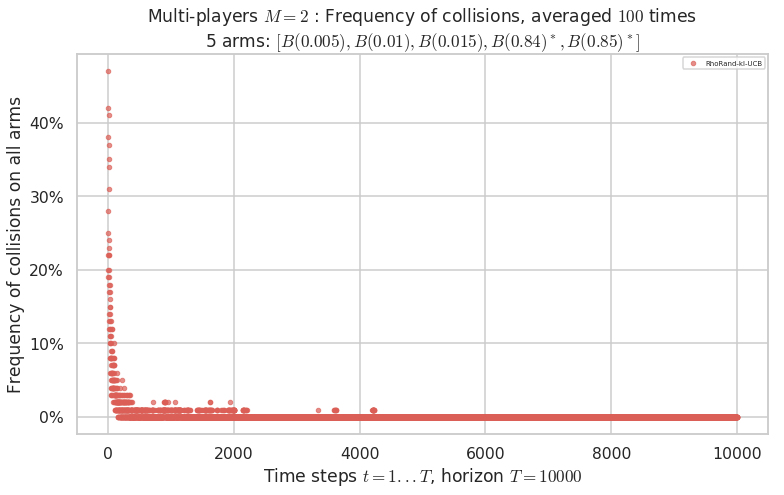
No upper bound for the non-cumulated number of collisions...
Warning: forcing to use putatright = False because there is 1 items in the legend.
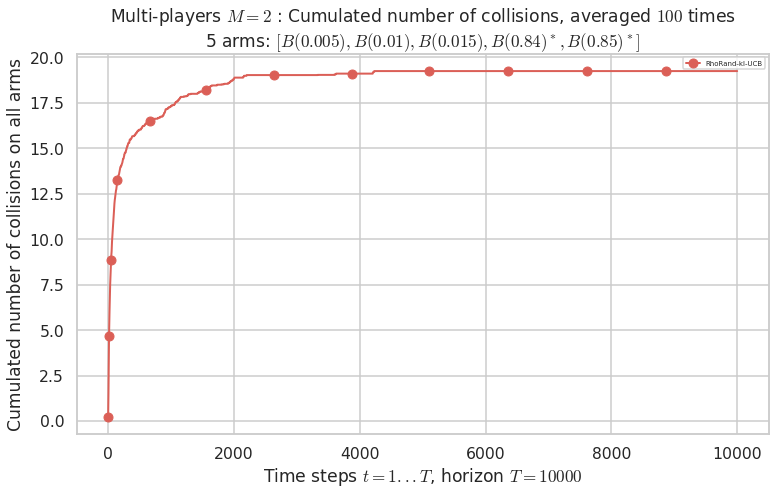
- For #$0$: $B(0.005)$ ($0.0%$$\%$), frequency of collisions is 2.2e-05 ...
- For #$1$: $B(0.01)$ ($0.0%$$\%$), frequency of collisions is 2.5e-05 ...
- For #$2$: $B(0.015)$ ($0.0%$$\%$), frequency of collisions is 2.3e-05 ...
- For #$3$: $B(0.84)$ ($0.1%$$\%$), frequency of collisions is 0.000983 ...
- For #$4$: $B(0.85)$ ($0.1%$$\%$), frequency of collisions is 0.000871 ...
Warning: forcing to use putatright = False because there is 3 items in the legend.
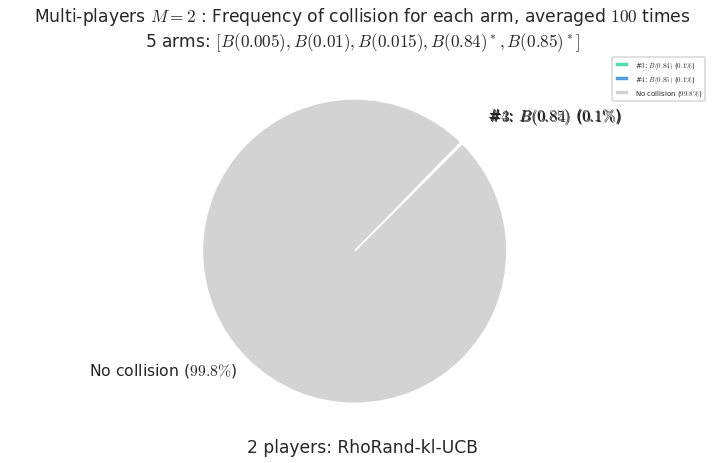
Final ranking for this environment # 2 : Selfish-kl-UCB ...
- Player # 2 / 2, Selfish-kl-UCB was ranked 1 / 2 for this simulation (last rewards = 8384.6).
- Player # 1 / 2, Selfish-kl-UCB was ranked 2 / 2 for this simulation (last rewards = 8380.2).
Warning: forcing to use putatright = False because there is 2 items in the legend.
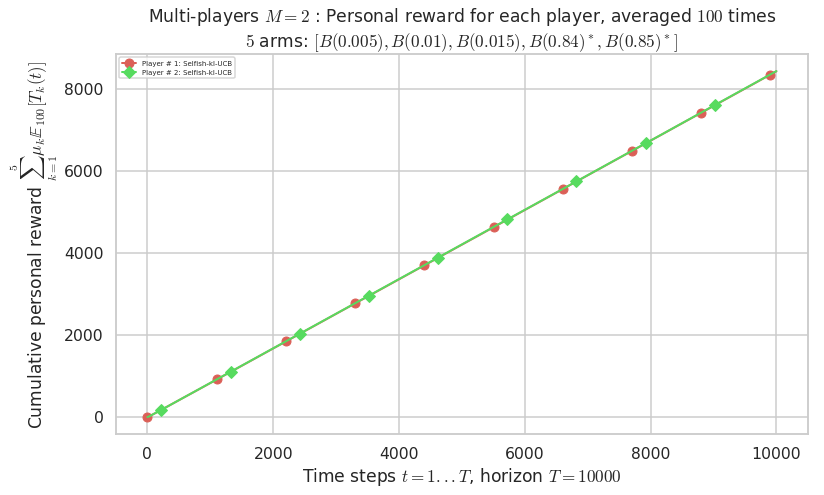
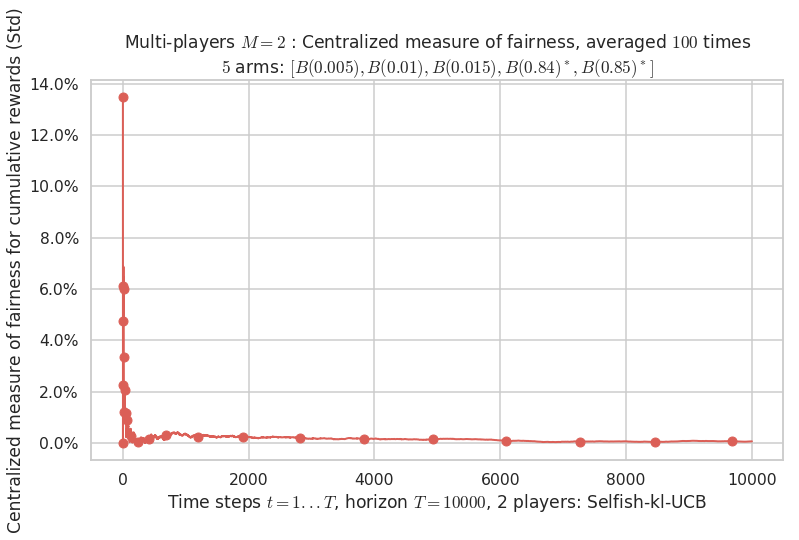
- For 2 players, Anandtharam et al. centralized lower-bound gave = 1.41 ...
- For 2 players, our lower bound gave = 2.83 ...
- For 2 players, the initial lower bound in Theorem 6 from [Anandkumar et al., 2010] gave = 2.78 ...
This MAB problem has:
- a [Lai & Robbins] complexity constant C(mu) = 27.3 for 1-player problem ...
- a Optimal Arm Identification factor H_OI(mu) = 29.40% ...
- [Anandtharam et al] centralized lower-bound = 1.41,
- [Anandkumar et al] decentralized lower-bound = 2.78
- Our better (larger) decentralized lower-bound = 2.83,
Warning: forcing to use putatright = False because there is 7 items in the legend.
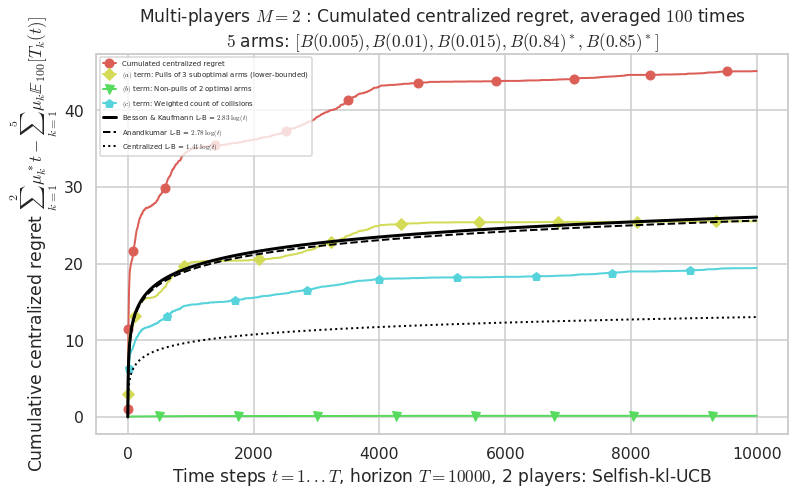
Warning: forcing to use putatright = False because there is 2 items in the legend.
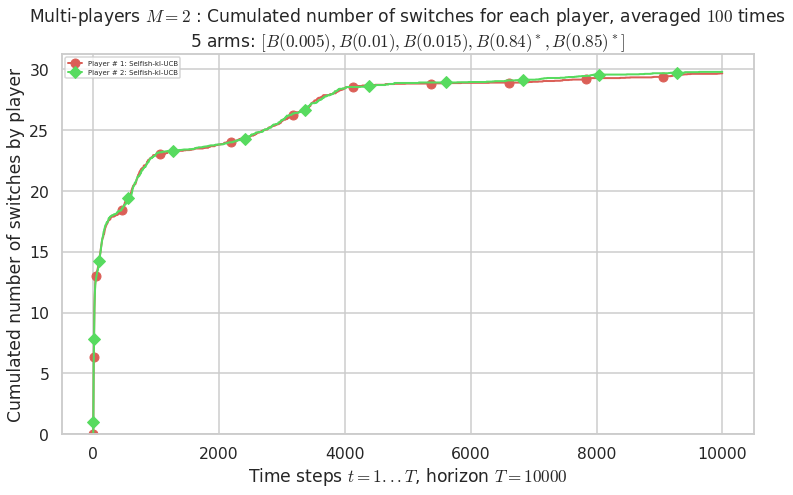
Warning: forcing to use putatright = False because there is 2 items in the legend.
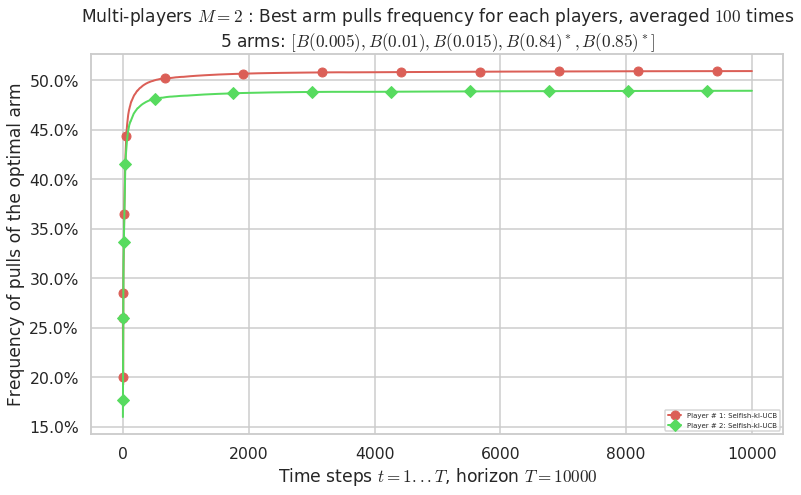
No upper bound for the non-cumulated number of collisions...
Warning: forcing to use putatright = False because there is 1 items in the legend.
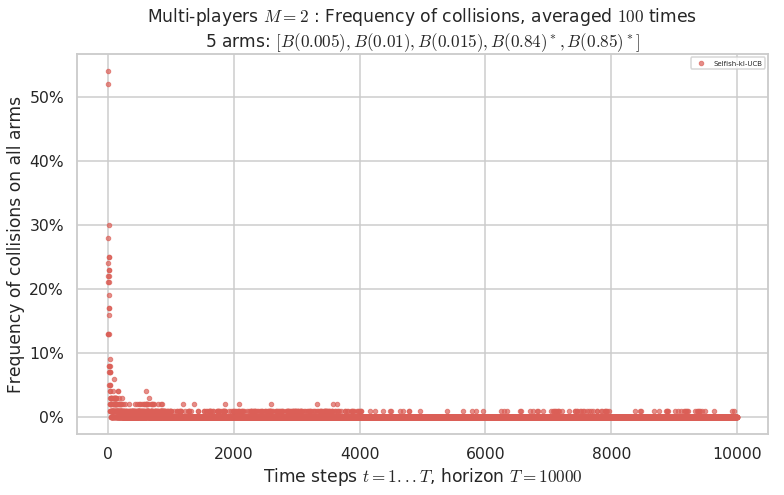
No upper bound for the non-cumulated number of collisions...
Warning: forcing to use putatright = False because there is 1 items in the legend.
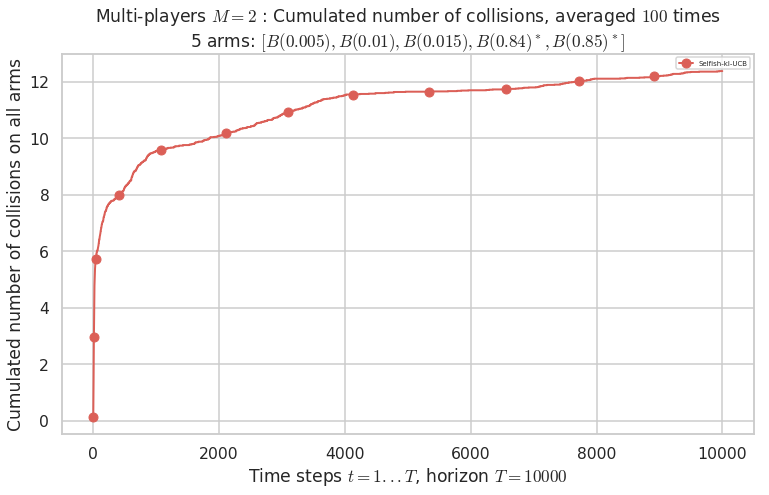
- For #$0$: $B(0.005)$ ($0.0%$$\%$), frequency of collisions is 2.9e-05 ...
- For #$1$: $B(0.01)$ ($0.0%$$\%$), frequency of collisions is 2.5e-05 ...
- For #$2$: $B(0.015)$ ($0.0%$$\%$), frequency of collisions is 3.6e-05 ...
- For #$3$: $B(0.84)$ ($0.1%$$\%$), frequency of collisions is 0.00056 ...
- For #$4$: $B(0.85)$ ($0.1%$$\%$), frequency of collisions is 0.000588 ...
Warning: forcing to use putatright = False because there is 3 items in the legend.
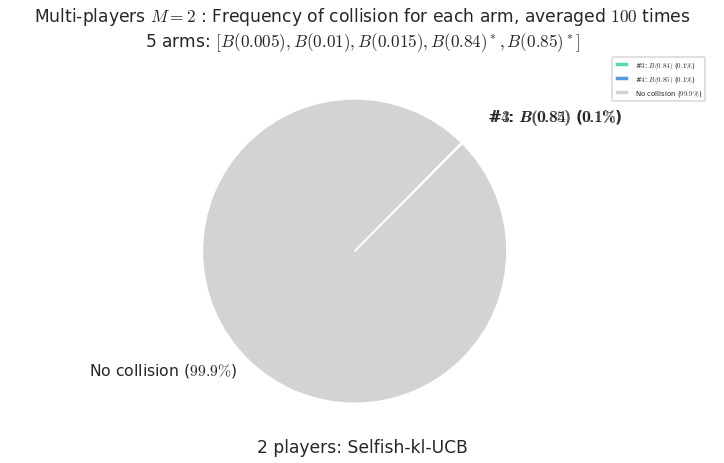
Comparing their performances¶
[33]:
def plotCombined(e0, eothers, envId):
# Centralized regret
e0.plotRegretCentralized(envId, evaluators=eothers)
# Fairness
e0.plotFairness(envId, fairness="STD", evaluators=eothers)
# Number of switches
e0.plotNbSwitchsCentralized(envId, cumulated=True, evaluators=eothers)
# Number of collisions - not for Centralized* policies
e0.plotNbCollisions(envId, cumulated=True, evaluators=eothers)
[34]:
N = len(configuration["environment"])
for envId, env in enumerate(configuration["environment"]):
e0, eothers = evaluators[envId][0], evaluators[envId][1:]
plotCombined(e0, eothers, envId)
- For 2 players, Anandtharam et al. centralized lower-bound gave = 9 ...
- For 2 players, our lower bound gave = 18 ...
- For 2 players, the initial lower bound in Theorem 6 from [Anandkumar et al., 2010] gave = 12.1 ...
This MAB problem has:
- a [Lai & Robbins] complexity constant C(mu) = 9.46 for 1-player problem ...
- a Optimal Arm Identification factor H_OI(mu) = 60.00% ...
- [Anandtharam et al] centralized lower-bound = 9,
- [Anandkumar et al] decentralized lower-bound = 12.1
- Our better (larger) decentralized lower-bound = 18,
Warning: forcing to use putatright = True because there is 9 items in the legend.
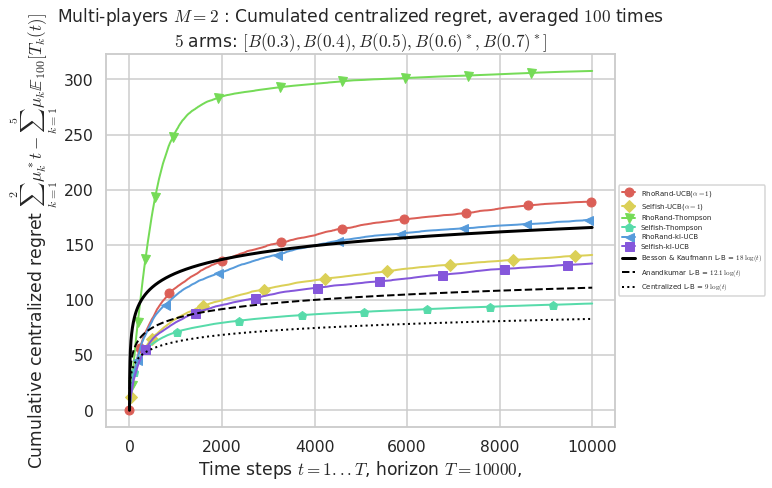
Warning: forcing to use putatright = False because there is 6 items in the legend.
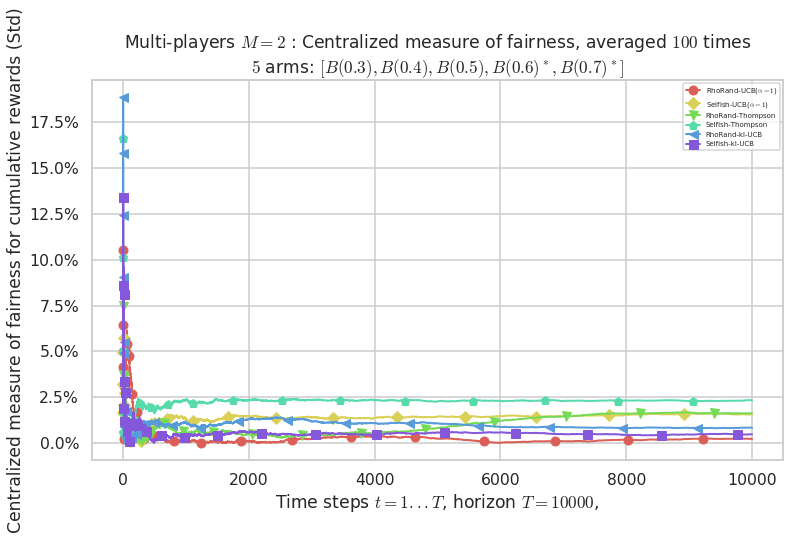
Warning: forcing to use putatright = False because there is 6 items in the legend.
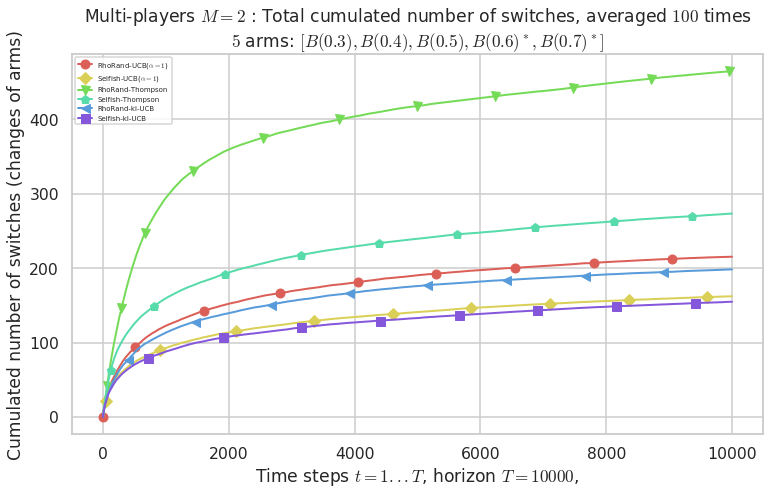
No upper bound for the non-cumulated number of collisions...
Warning: forcing to use putatright = False because there is 6 items in the legend.
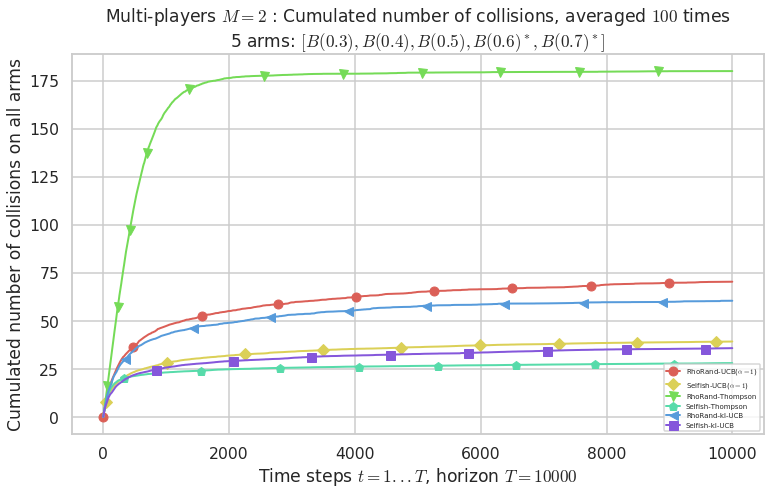
- For 2 players, Anandtharam et al. centralized lower-bound gave = 4.23 ...
- For 2 players, our lower bound gave = 8.46 ...
- For 2 players, the initial lower bound in Theorem 6 from [Anandkumar et al., 2010] gave = 5.35 ...
This MAB problem has:
- a [Lai & Robbins] complexity constant C(mu) = 3.12 for 1-player problem ...
- a Optimal Arm Identification factor H_OI(mu) = 40.00% ...
- [Anandtharam et al] centralized lower-bound = 4.23,
- [Anandkumar et al] decentralized lower-bound = 5.35
- Our better (larger) decentralized lower-bound = 8.46,
Warning: forcing to use putatright = True because there is 9 items in the legend.
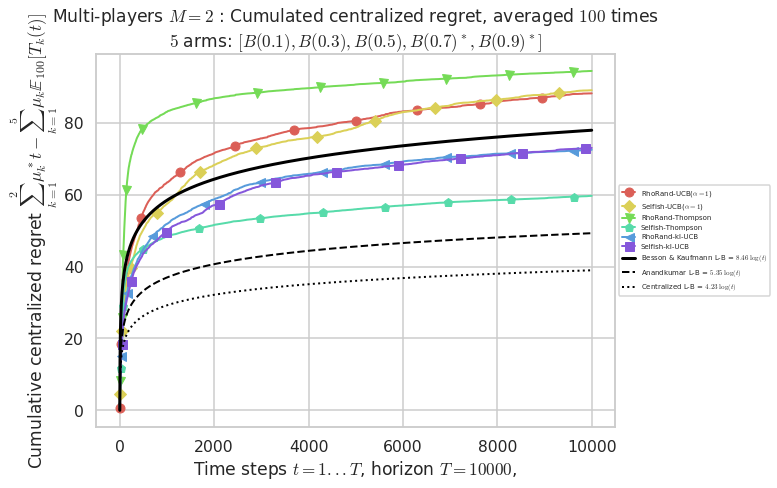
Warning: forcing to use putatright = False because there is 6 items in the legend.
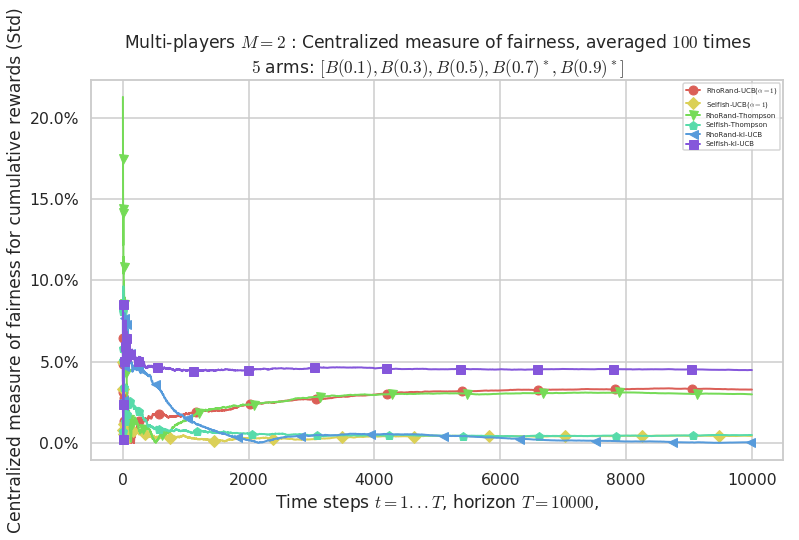
Warning: forcing to use putatright = False because there is 6 items in the legend.
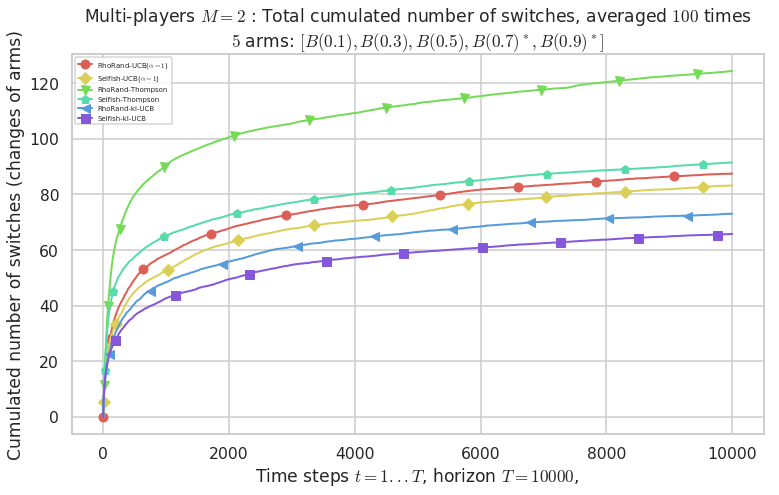
No upper bound for the non-cumulated number of collisions...
Warning: forcing to use putatright = False because there is 6 items in the legend.
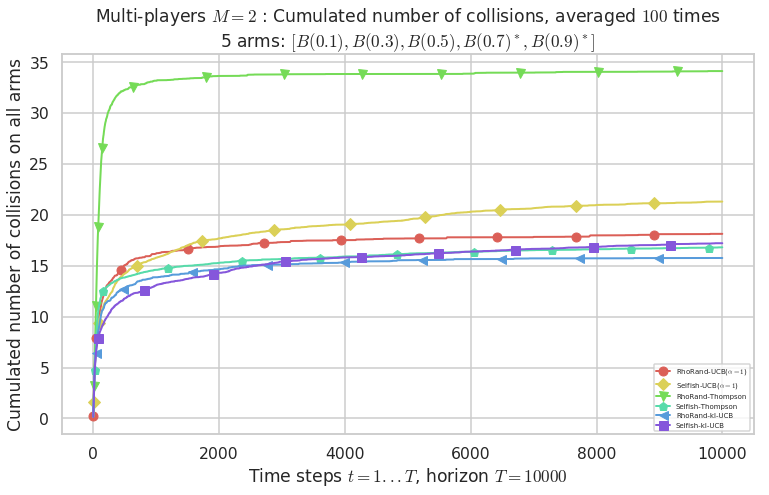
- For 2 players, Anandtharam et al. centralized lower-bound gave = 1.41 ...
- For 2 players, our lower bound gave = 2.83 ...
- For 2 players, the initial lower bound in Theorem 6 from [Anandkumar et al., 2010] gave = 2.78 ...
This MAB problem has:
- a [Lai & Robbins] complexity constant C(mu) = 27.3 for 1-player problem ...
- a Optimal Arm Identification factor H_OI(mu) = 29.40% ...
- [Anandtharam et al] centralized lower-bound = 1.41,
- [Anandkumar et al] decentralized lower-bound = 2.78
- Our better (larger) decentralized lower-bound = 2.83,
Warning: forcing to use putatright = True because there is 9 items in the legend.
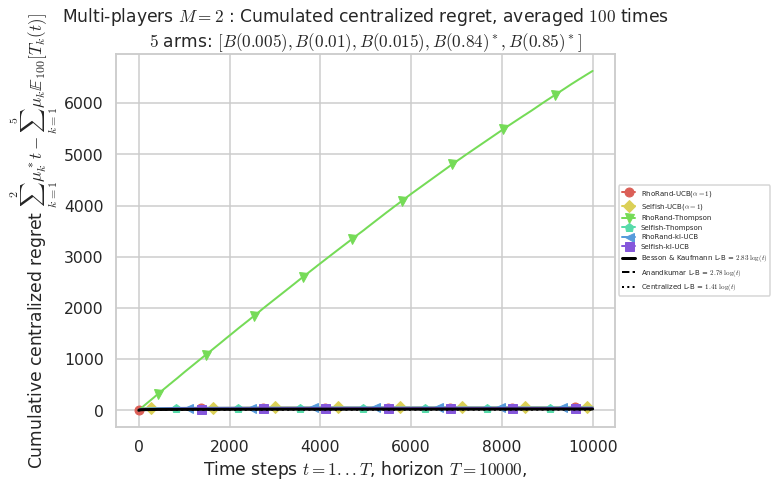
Warning: forcing to use putatright = False because there is 6 items in the legend.
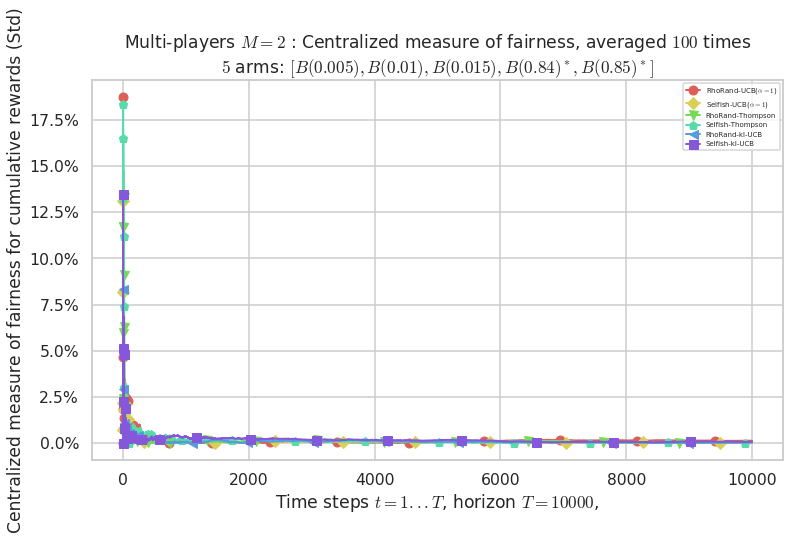
Warning: forcing to use putatright = False because there is 6 items in the legend.
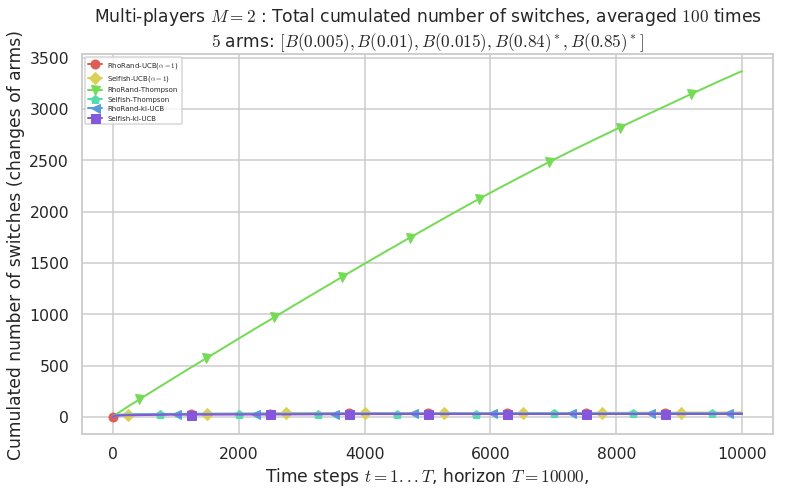
No upper bound for the non-cumulated number of collisions...
Warning: forcing to use putatright = False because there is 6 items in the legend.
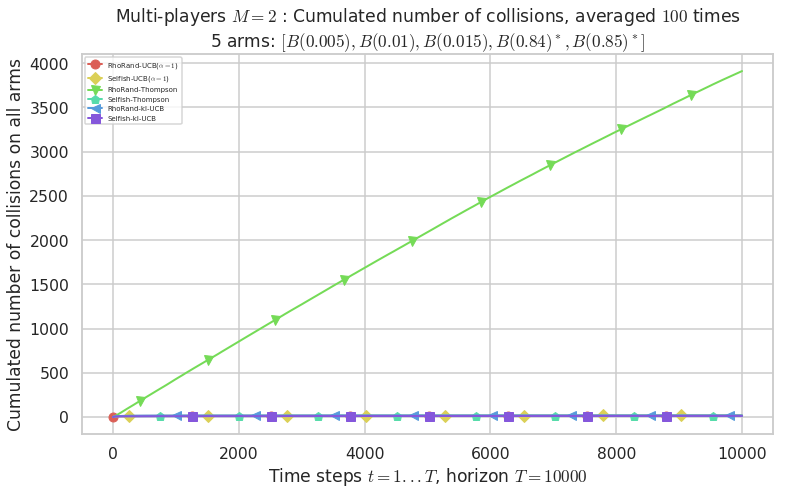
That’s it for this demo!